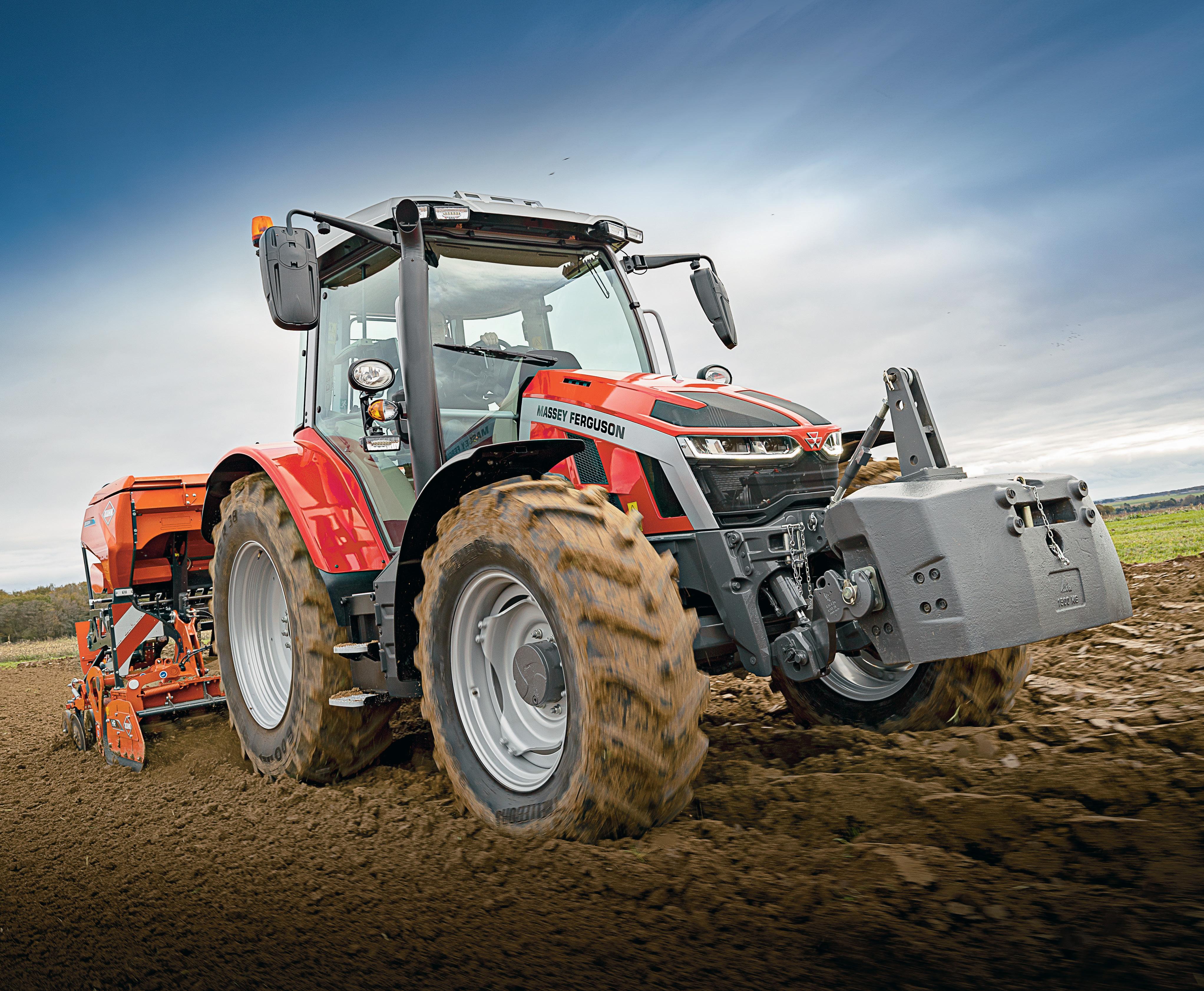Learn, grow, excel
SPECIAL REPORT: Stop the loss
Reducing N losses from the farm system

Learn, grow, excel
SPECIAL REPORT: Stop the loss
Reducing N losses from the farm system
Ed Jackson shares his tips for hitting heifer grazing targets.
THE RISE OF RURAL CRIME
SHORTER GESTATIONS
Reconsidering mating and calving dates
FROM THE GROUND





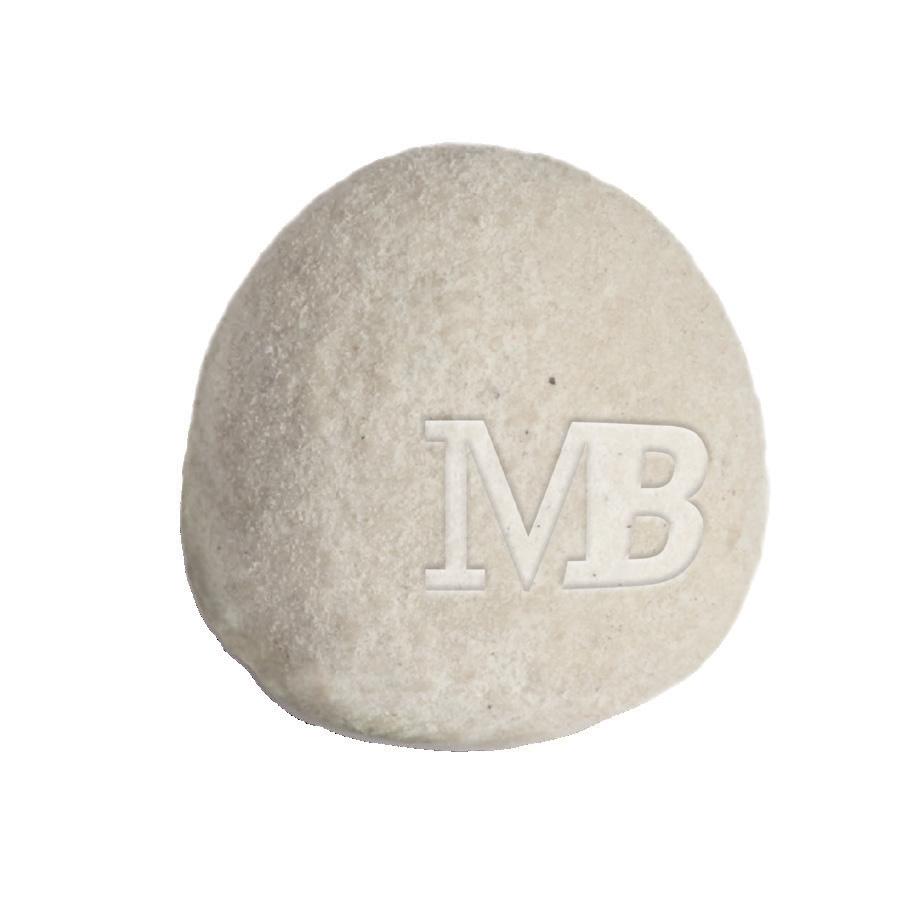
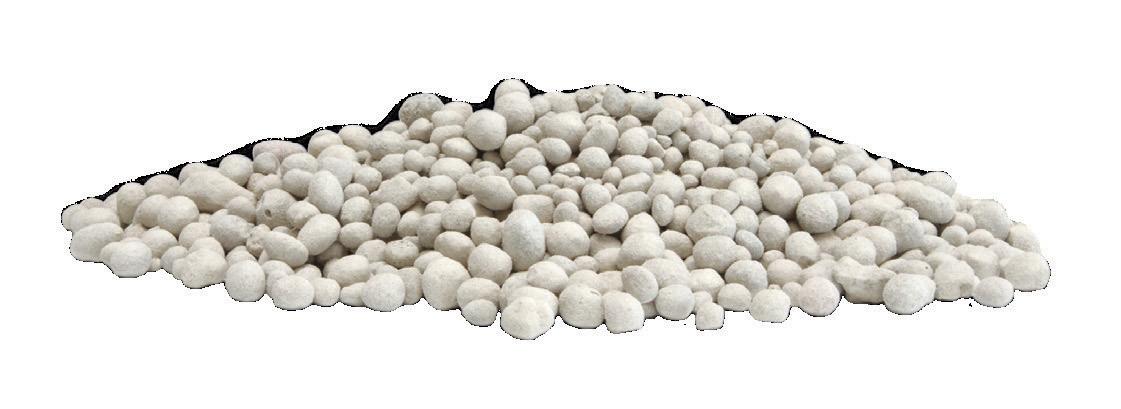
SPECIAL
Page 70
YOUNG COUNTRY
Fast track to success
An Aussie crossing the ditch for dairy

From the Ground Up: A workout for the mind
RESEARCH WRAP
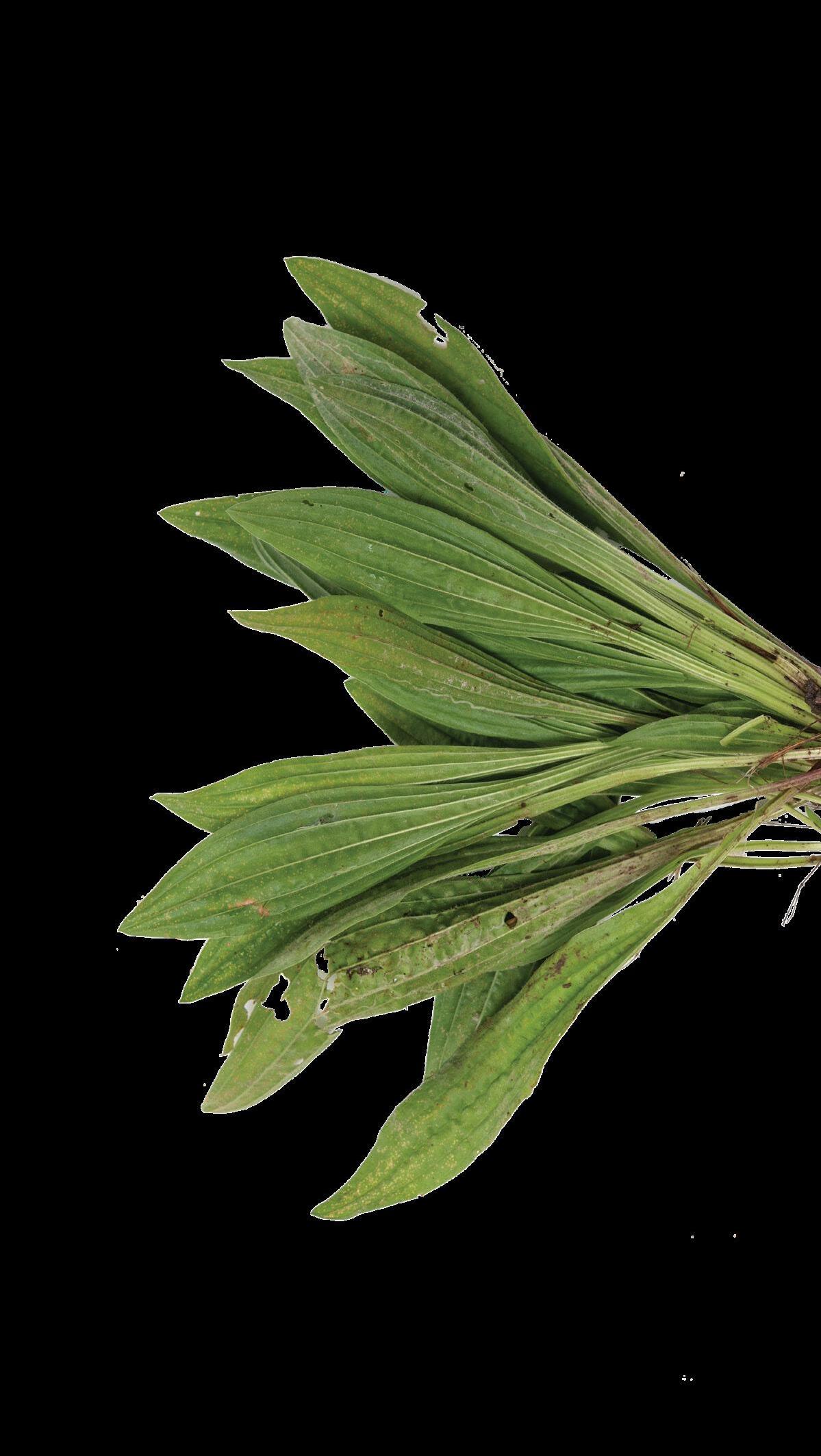
Mating later, calving on time
ENVIRONMENT
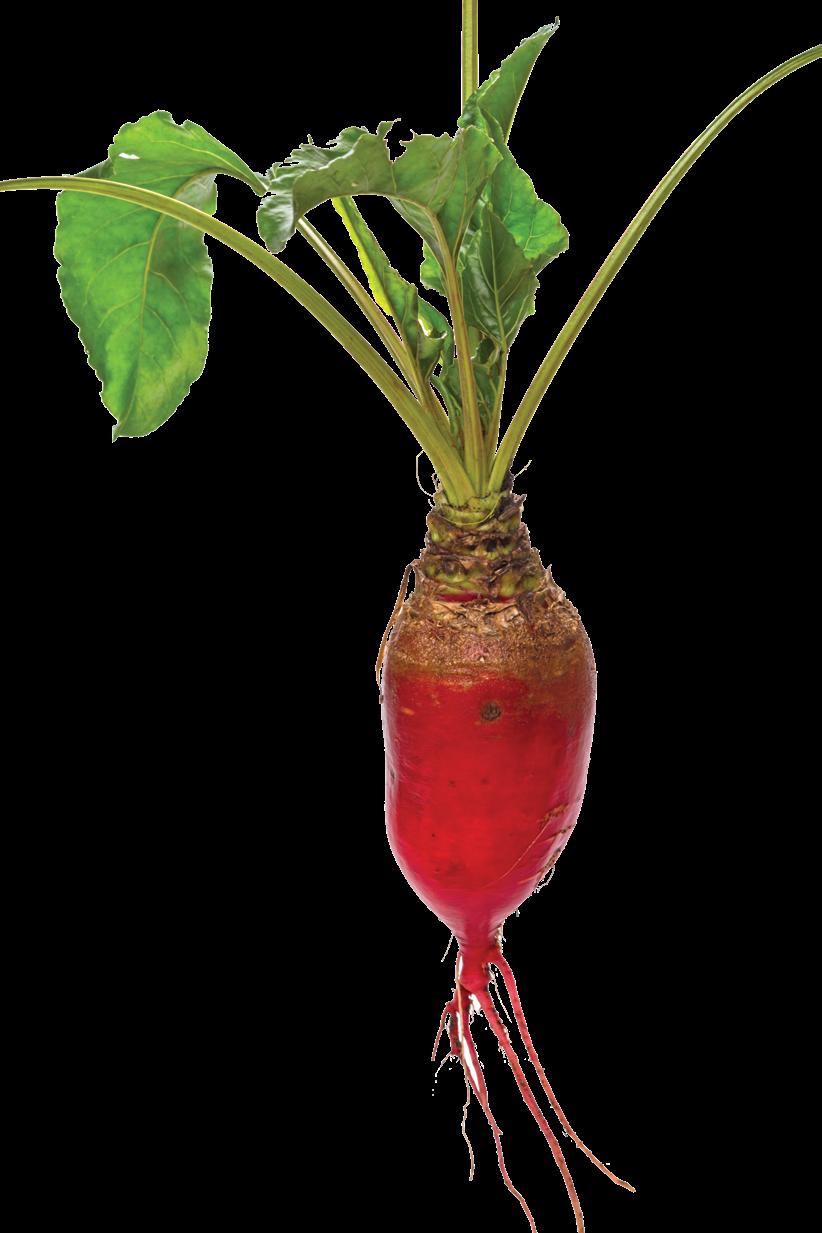
54 Solar power: The power of light
Page
58 Heifers: On target with grazing.
63 Gestation: Calves arrive earlier.
64 Skin conditions: An ABC of lumps and bumps.
66 How heat Impacts your cows
Cover: Ed Jackson from Ashhurst grazes more than 300 dairy heifers each year and has some tips about how to get them up to target weights.
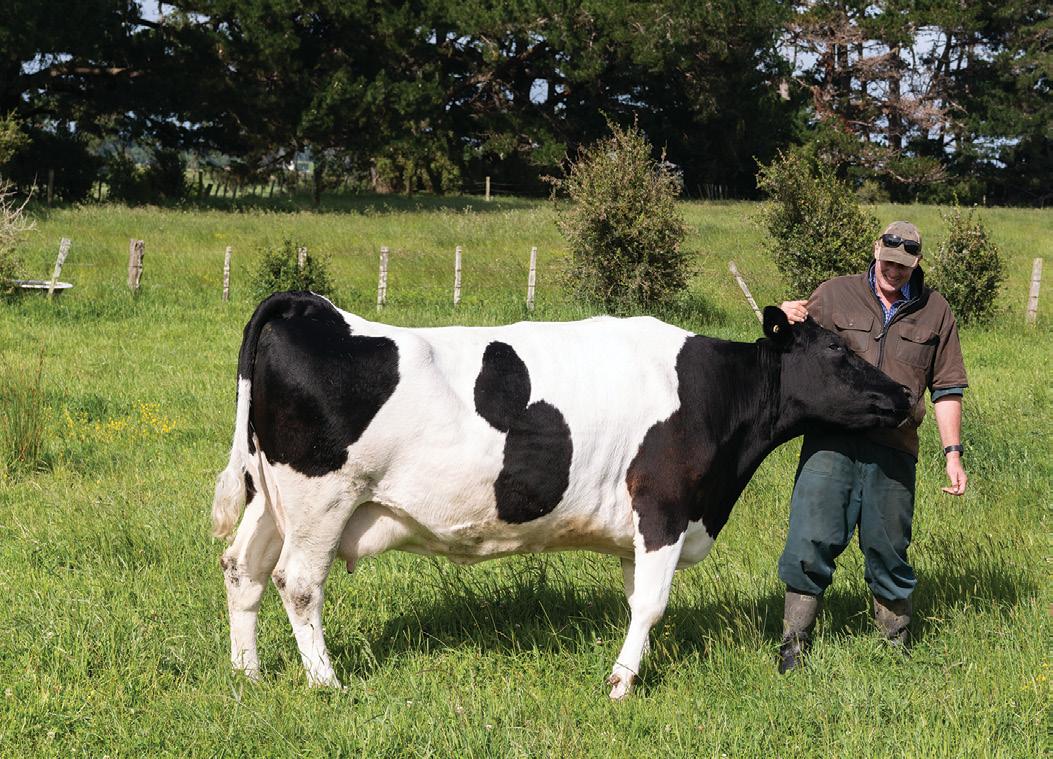
Page 45
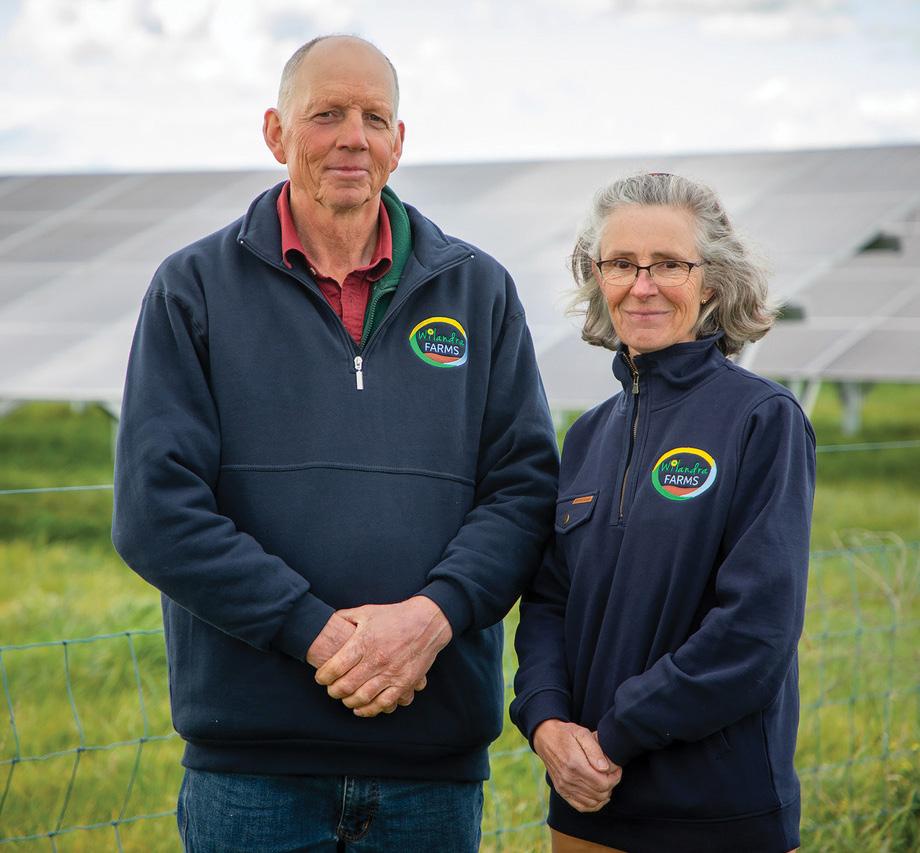
December 13 – A SMASH field day at Tirau looks at inspiration for your future farm. Hosts, Adrian and Pauline Ball were the regional supreme winners of the Ballance Farm Environment Awards in 2019. They will share how they aim to be sustainable in every aspect of their business including the environment, staff and stock. Celebrity chef, Angelo Georgalli, will then demonstrate how to make the most of the game you hunt. The day runs from 10am to 1pm. For more, visit http www.smallerherds. co.nz/smash-events/field-dayinspiration-for-your-future-farm-tirauwaikato/
December 15 – DairyNZ hosts a session on feed planning for summer for its Bell Block/Lepperton summer group at Waitara in Taranaki. Former DairyNZ CO and now farm consultant, Alicia Riley, will be answering questions on the topic. The event combines with the annual Christmas barbeque and will be hosted by Tony Potroz. It runs from 11am to 1pm. For more, visit www.dairynz.co.nz/events/ taranaki/bell-blocklepperton-summergroup-december/
December 15 – Embryo transfers and Tru Test collars are the topics for the Jersey Breeders’ Christmas group get-together in Otorohanga.
Topics include embryo transfers using Vytelle, Tru-Test collars and walk-over weighing to get better herd information, plus inspection of the herd and viewing a wetland. The event is being held at Michelle and Shaun Good’s farm between 11am and 1pm. For more, visit www.dairynz. co.nz/events/waikato/jersey-breederschristmas-group-december
February 1 – The Orini Summer Group with Arjun Singh looks at the role nutrition and genetics play in maximising production and profit; the ration balancing needed to achieve 730kgMS/cow and the importance of good infrastructure in the system. The event runs between 11am and 1pm and will also look at how they set up for calving, plus heat stress through the height of summer. For more visit www.dairynz.co.nz/events/waikato/ orini-summer-group-february
February 7 – DairyNZ’s FarmTune 2023 holds a workshop in Winton. The comprehensive programme is aimed at supporting you and your team to implement Lean thinking onfarm. The workshop runs between 10am and 1.30pm. Another workshop will be held in Balclutha on February 23 and further workshops will follow in both locations. For more, contact Lynsey Stratford on 021 165 2004.
February 14 – The Te Kawa/Pokuru summer group meets to discuss mixed-species summer crops at the Wallaces’ Pokuru farm. See how the crops are growing and the herd grazing on them. For more contact Phil Irvine, DairyNZ, on 027 483 9820.


February 15 – Dairy Women’s Network in conjunction with SealesWinslow and AgriVantage is running a Today’s Calf, Tomorrow’s Cow expo in Manawatu. The event looks at proper care and nutrition for today’s calves to set them up for a lifetime of high performance. As well as stands from sector organisations, the expo will run a workshop with Natalie Hughes from SealesWinslow and Natalie Chrystal from AgriVantage on best practice to maximise calves’ potential from day one. Expo attendees have the chance to book a 10-minute slot with the speakers to discuss farm-specific challenges. Book slots at the expo which runs from 9am to 4.30pm. For more visit www.dwn. co.nz/events/todays-calf-tomorrowsmanawatu/
February 22 – A Today’s Calf, Tomorrow’s Cow expo is being held in Whangarei at the Barge Showgrounds Event Centre. See details above and visit www.dwn.co.nz/events/todayscalf-tomorrows-cow-northland

How do you eat an elephant? One bite at a time… (don’t even think about how you wrangle it, chop it up, cook and tenderise it… that’s for another day.)
But for the purposes of this exercise the old mantra bears thinking about.
Farmers have always had elephants, or gnarly issues, to eat, and the trick is to not let the overwhelm get you while you think about it and decide how to go about breaking down the gnarly issue and moving forward.
Faced with a need to cut nitrogen leaching losses by 30%, mid-Canterbury farmers Tom and Sara Irving didn’t choke on the elephant, but took a multipronged approach.
Through investing in irrigation infrastructure, a slight drop in stocking rate, a big backing off the annual N application, cutting bought-in supplement and a stronger focus on pasture management they have cruised across the line, reducing N leaching to 28kg N/ ha - well under the 50kgN/ha target. And milk production is still sitting at close to the level of the last six years of 1500kg milksolids (MS)/ha or 450-470kg MS/cow.
Tom and Sara are confident advances in R&D will see more tools added to the tool
box, so are not afraid of further cuts.
Read about them in our special report on ‘stopping the loss’ of nutrients on page 40.
George Moss writes about learning from the positivity and self-belief of the conquering Black Ferns and suggests we reframe our eating an elephant problem of reducing GHG emissions to chip away at the problem and and be the “world-leading farmers that contribute to climate cooling”. (pg 10)

Here we are at the end of 2022, the December issue.
I hope you have the head space over the summer to think about how to eat your elephant - start sharpening your knife and cut it into really small pieces.
We all have changes coming at us in 2023, if you can think about them with positivity and self-belief you have a much better chance of not just surviving but thriving through the changes. Wishing you a happy and healthy Christmas and all the best for 2023!

• The resurgence of equity partnerships - how to get keen young people into your business, and how to make the relationship work.
• The Brothers Green: how could converting 10% of your farm to hemp help your bottom line and GHG emissions.
• Winter bale grazing, how it works in Southland

New Zealand Dairy Exporter’s online presence is an added dimension to your magazine. Through digital media, we share a selection of stories and photographs from the magazine. Here we share a selection of just some of what you can enjoy. Read more at www.nzfarmlife.co.nz
Young Country is pleased to announce that episode nine of From the Ground Up is now live on all of your favourite podcast providers.
Episode 9: From running personal training sessions on her front lawn while her young children slept, to a thriving online health and fitness platform, Kate Ivey is inspiring people to adopt a healthier lifestyle that is sustainable long-term.

Episode 8: Merino lamb raised in the Marlborough high country and delivered direct to your door, Middlehurst Delivered is a family business with a focus on sustainability.
Episode 7: Scott Jimmieson has realised his dream of becoming a farmer, and he’s keeping it local with his new online shop business, Local Food NZ, connecting farms with consumers.
Episode 6: Standing on the sideline watching her daughter play rugby in winter, Charlotte Bell thought she’d love to have a warm wool coat to wear.
Episode 5: Edward Eaton and Wilbur Morrison talk all things Buzz Club. Launching a range of premium sparkling mead naturally brewed from native NZ honey.
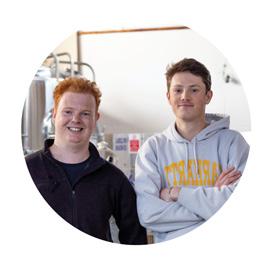
Episode 4: Brad Lake from The Brothers Green talks about harnessing the potential of hemp with a range of valueadded products.
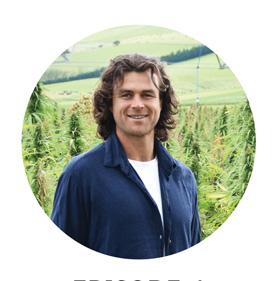

Episode 3: The Mangamaire Sunflower Field, established by farmer, photographer and mum, turned sunflower entrepreneur extraordinaire, Abbe Hoare, is turning heads for all the right reasons.

Episode 2: Amanda King founder of By The Horns. They say you should never work with children or animals, but By the Horns photographer Amanda King has carved out a niche for herself doing exactly that.


Episode 1: Delwyn Tuanui from The Chatham Island Food Co about how he chased his dreams from the ground up.
We love highlighting positive stories of young agri-innovators chasing their dreams. Listen to From the Ground Up: nzfarmlife.co.nz/podcasts-2 or scan QR code
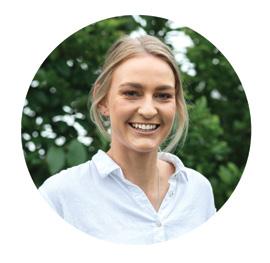


NZ Dairy Exporter is published by NZ Farm Life Media PO Box 218, Feilding 4740, Toll free 0800 224 782, www.nzfarmlife.co.nz
Editor
Jackie Harrigan P: 06 280 3165, M: 027 359 7781 jackie.harrigan@nzfarmlife.co.nz
Deputy Editor Sheryl Haitana M: 021 239 1633 sheryl.haitana@nzfarmlife.co.nz

Sub-editor:
Andy Maciver, P: 06 280 3166 andy.maciver@nzfarmlife.co.nz
Reporters
Anne Hardie, P: 027 540 3635 verbatim@xtra.co.nz
Anne Lee, P: 021 413 346 anne.lee@nzfarmlife.co.nz
Karen Trebilcock, P: 021 146 4512 ak.trebilcock@xtra.co.nz
Delwyn Dickey, P: 022 572 5270 delwyn.d@xtra.co.nz
Phil Edmonds phil.edmonds@gmail.com
Elaine Fisher, P: 021 061 0847 elainefisher@xtra.co.nz
Claire Ashton P: 021 263 0956 claireashton7@gmail.com
Design and production:
Lead designer: Jo Hannam P: 06 280 3168 jo.hannam@nzfarmlife.co.nz
Emily Rees emily.rees@nzfarmlife.co.nz
Partnerships Managers: Janine Aish
Auckland, Waikato, Bay of Plenty P: 027 890 0015 janine.aish@nzfarmlife.co.nz
Tony Leggett, International P: 027 474 6093 tony.leggett@nzfarmlife.co.nz
Angus Kebbell, South Island, Lower North Island, Livestock
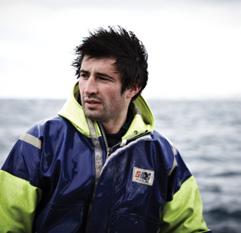
P: 022 052 3268 angus.kebbell@nzfarmlife.co.nz
Subscriptions: www.nzfarmlife.co.nz subs@nzfarmlife.co.nz

P: 0800 2AG SUB (224 782)
Printing & Distribution:
Printers: Blue Star, Petone
Single issue purchases: www.nzfarmlife.co.nz/shop
ISSN 2230-2697 (Print)
ISSN 2230-3057 (Online)






We can learn from New Zealand Women’s Rugby’s Black Ferns team’s turnaround from being almost written off to all-conquering, writes George Moss.

The Black Ferns were the tonic we all needed, not just because they won the Women’s World Rugby trophy, but for the absolute joy they brought to rugby, their personal happiness and their self belief without arrogance.
I have to confess to shedding a tear of pride when Ruby Tui led Tutira Mai Nga Iwi, a song of standing together and unity. Such is the pride and engagement engendered that there are now many young people wanting to take up rugby. Positivity and belief is infectious – we can learn from their journey from being almost written off to all-conquering.
The season continues to be challenged with significantly less silage made so far, with production being slightly behind (<1%) on one farm and slightly ahead daily on the other. Submission rates have been well in the 80%s where intervention used and low 80s without intervention.
Have looked at purchasing silage to bridge the gap. Cost of purchased silage itself is reasonable but depending on distance freight can add $60 to $70 per bale. Hence, there is going to be a rethink if serious surpluses do not arrive soon. The rise in farm costs is staggering and we only hope we can keep them under $5.50/kg MS but I’m not optimistic.

Like every other farmer, we have been closely watching the developments with He Waka Eke Noa. Now with some suggested costs for gases available, we have been able to get a good estimate on both the per hectare cost and total cost across the enterprises. We made no reduction for any carbon sequestered.
Using last year’s OverseerFM figures, the home farm (dairy plus beef operation) cost per hectare is $56.35 and the other farm cost per hectare is $69.27. Both farms are using the highest methane cost for the calculation. Absolute cost in total is just on $10,000 which equates to about 7% of the increase in our interest bill.
There are changes that need to be made to the Government’s proposal, namely pricing should be delinked from the NZ units on the ETS, we need to control how
the levy received is spent and have flexibility around that and we need to be able form collectives so that individuals can work together for mutual benefit. The fact that Iwi are disproportionately impacted needs to be addressed.
I have said it before, regardless of what we think of the He Waka proposal, the markets will be the arbiters on our progress in reducing our footprint.
Regardless of what we think of the He Waka proposal, the markets will be the arbiters on our progress in reducing our footprint.
AirNZ ‘s chief executive Greg Foran is pushing hard to have the fleet well on track to decarbonisation by 2030 potential using electric planes for very short haul, hydrogen planes for longer internal flights (aka Auckland to Wellington) and biofuels for the really big jumps. Clearly, given the huge cost involved and risks involved as a first mover they have decided that the status quo is not a long-term viable option and have chosen to lead.
Fonterra at its annual meeting forewarned of the market and financing risk if we do meet sustainability expectations. Banks are already pricing “footprints” in interest pricing. I absolutely accept this is a difficult space to operate in and manage but I do not accept the notion that it can’t be done –our own operations have weaknesses that need addressing.
The question is whether we approach the challenge with positivity and self-belief attracting others to NZ’s premier sector (and we are in desperate need of new blood and energy) or whether we talk ourselves into a negative space undermining wealth and opportunity and, worse still, affecting the “top paddock”.
Just imagine a headline, that reads “the world-leading farmers contribute to climate cooling” – surely this would appeal to the highly aware consumers wanting guilt-free nutritious food and those people wanting to be part of a winning team.

Future-proofing in the dairy is the way to go, writes Westport dairy farmer
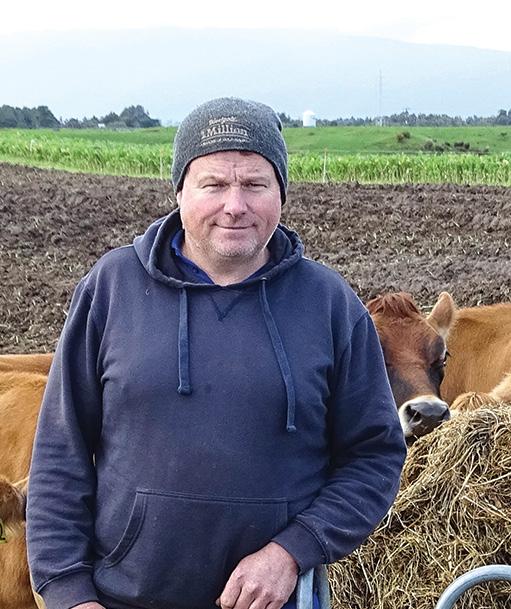 John Milne.
John Milne.
This will be our third season using a dedicated AB facility. It came about after having an ankle reconstruction operation back in December 2019. While laid up on the couch for a solid four months, this gave the mind a chance to wander and think what changes had to be made for the upcoming season.
Unbeknown to us that this would actually be a necessity in the very near future at the time we started construction.
Before the installation there were planks hanging off a pit rail like so many other dairy farms do or did.
The AI Tech of 13 years that we have here loves the new setup, she’s confident in her footing, there are no pinch points and the cows are relaxed while they are herringboned there to be artificially inseminated.
The first comment in the first season was “Gosh your cows are relaxed.” She says she can now solely concentrate on the job in hand instead of worrying about pinch points and unsteady footing.
We can continue milking with the ‘3 in 2’ using this facility, on the one-day milking we just simply draft out the in-season cows as they come up to the cowshed and they wait there in the facility while we start milking.
Once a week over mating we draft the cows out that need a touch-up of tail paint or heat detectors. One person can do this while we are milking.
Vets love it for total herd tests i.e. pregnancy scanning, vaccines.

The TB tester just flies through them at TB testing time –no stilts needed.
We have even calved cows in there as well.
It’s just safe and bloody handy.
In the years of using the planks we only had one fall, they
Before the installation there were planks hanging off a pit rail like so many other dairy farms do or did.
just walked off the end of the plank concentrating on the job they were doing, luckily they landed on the pit mats with no injury, shrugged it off and carried on. A lucky escape I reckon.
It’s just compliance, but also could be called common sense, to keep people out of harm’s way.
Here are some things that need to be considered:
• Make it long enough to hold a decent amount of cows –take a look at what your average day of AB consists of
• Make it fall into an existing water flow area to capture effluent
• Make it so it does not have to be hosed off when not in use
• Make it weatherproof for sun and rain.
We couldn’t use existing concrete so utilised an exterior garden area to keep it practical and constructed on top of this.
Look on the LIC website they have a requirement that must be met by 2025.
Think of it as future-proofing.
We don’t like the look of the industry going forward. A lot is going on outside the farm gate beyond our control that we do not agree with. Our preference is to focus on the crucial farm tasks at hand.
These are areas we enjoy doing and getting up for in the morning: mating, pasture management, feeding cows and turning grass into milk, summer crop establishment etc. These are areas we know what we need to do to be successful, we have control (mostly), and they have a direct impact on our bottom line.
But, if we want to stay in farming and influence what our future looks like, we need to be more proactive outside the farmgate.
The Government’s climate policy is shaping up to be one of our most significant policy challenges in our industry. This is happening during the running of day-to-day farm tasks, implementation of unorganised environmental legislation, coping with onfarm inflation and tripling interest rates, and seasonal climatic conditions that aren’t following typical trends (to name a few).
The stress and pressure on our farming community is evident. You only had to attend one of the many consultation sessions to observe farmers’ frustrations are at boiling point and morale is low.
So, we would be hypocritical to say we don’t like the look of the industry going forward and yet not do anything about it. Like with our onfarm tactics, we assess the situation and focus on areas that we can either have control or influence. In this case, having a voice is one option.
Our approach is to be more strategic with our time; currently it is to divide and conquer. Nic is running the dayto-day farm tasks and Kirsty is putting her time into admin that is outside the farm gate. It is important to engage in the He Waka Eke Noa consultancy process:


• attend consultation meetings and get up to speed with the details,
• give feedback.
• make our levy work for us and reflect our feedback.
• be a member of Federated Farmers.

• fill in the farmer surveys, and prepare our own submission.
• talk to our peers and get them revved up on this issue as well.
Not losing focus with happenings onfarm, over the last few months we pulled the trigger on some key management decisions. With grass failing to fire at its usual time, we decided to contract palm kernel in early September after almost a two-year hiatus. By contracting the extra feed it meant cows kept their condition into mating and have continued to milk ahead of budget this season.
After five months of drought we have changed up our summer cropping programme to target drymatter yields and trialled leafy turnip this summer on the milking platform.
So far, the decision to expand onfarm technology has been a good one. For mating we achieved a 90% threeweek submission rate, with Halter taking a huge amount of pressure off the team for heat detection.
We continue to get letters in the mail from the bank informing us of our interest rate rises. To this end, we keep revisiting our budget and refreshing it with these changes and in other areas that costs keep going up. Keeping the budget accurate allows us to be strategic in where we make key decisions – particularly when to pay down debt and how much to pay.
We always look forward to Christmas as the pressure comes off. By this time, we have done almost everything we can to set ourselves up for the rest of the season. This will be our first year experiencing ‘school holidays’ with our first-born starting school in October. It will be good to have a change of scene from the farm to the beach!
Kirstyand Nic Verhoek have taken stock of where they stand in a time of turmoil off the farm.
But, if we want to stay in farming and influence what our future looks like, we need to be more proactive outside the farmgate.Starting school.
Composting shelters have allowed the family to escape for a soak at Hanmer Springs, despite a severe weather warning, Gaye Coates writes.
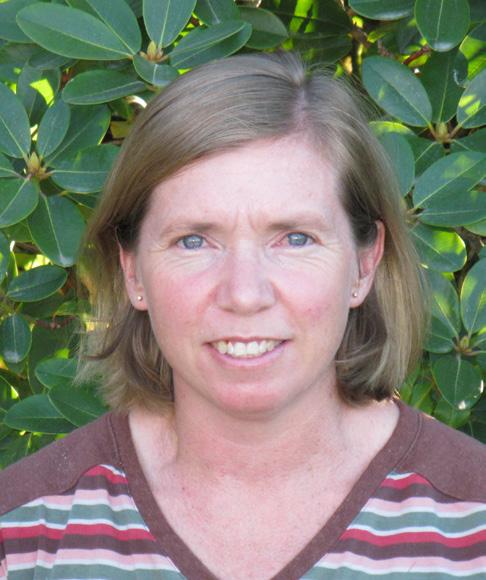
Unintentionally, incorporating composting shelters into our farming system has created something of a talking point.
Building these shelters has not been a small project; there is no stepping away from them being an up-front response to improving our farm’s winter grazing practices. Unsurprisingly the direct questioning, mixed with some evasive scepticism all share the same purpose. Ultimately, people want to know if this is a solution that is going to work or, conversely, not work.
Looking for a solution to improve our winter grazing and environmental compliance, we wanted a focus on resilience. We wanted to respect not only our land and the wider environment, but also safeguard the wellbeing of our pastures, our cows and our people. Introducing our herd to the barns this winter for shelter and feeding noticeably reduced stress and fatigue across all of those three important areas – pasture, cows and people.
the barns were scheduled into the grazing plan and we escaped worry-free for some “soak and hold” in Hanmer. So, while there is a sense of realism that these are early days, the barns are absolutely working in our farming system.
Have our farming priorities changed? One of the first concerns was whether our milk could still be marketed within the framework of grass-fed? We have always been, and continue to be, a pasture-based farm with an emphasis on cow condition, production second. Our farming system has not shifted from those priorities. The barns are a resource that allows us to better use both the pasture grown onfarm and the supplements required to fill the deficits. We are in a position with the barns to balance without compromise both pasture and cow health. Have our farming practices changed? Again we were challenged by suggestions that introducing a barn into our farming system would result in us indiscriminately and excessively feeding our cows. Removing our traditional reliance on annual forage crops to meet feed demand in winter has been the major change in our farming practices.
Being precise with our feed budgeting and understanding cow feed demands remains unchanged.
Have there been challenges? The timing of a one in 100year storm just before calving saw the roofs damaged on both sheds, allowing significant rain into the barns. The success or not of the composting bed pack is reliant on a few crucial factors, one being the elimination of water from the stack.
During spring, the cows calved in the barns and following this, the barns have been “on call”, providing us with flexibility to respond to climate and weather events and to cow demands. After 12 months using the barns, cows are in good condition and definitely damage to pasture because of inclement weather has been averted.
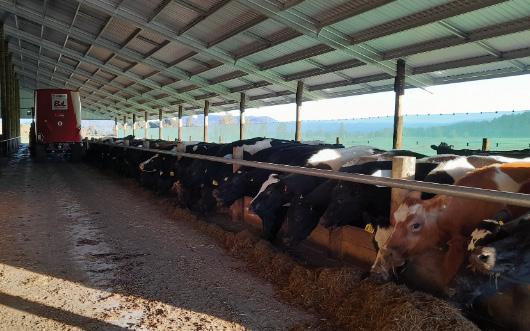
While we haven’t achieved quite the peak milk production we had aimed for, the usual phenomenon of that high point dropping rapidly away has not happened, and production has remained stable. Lameness is significantly less, the result we believe of the extra space and kinder surface of the feed area. There has been no acceleration of mastitis and the somatic cell count remains at 100,000.
Inadvertently, there is a personal sense of security in having these dominant structures onfarm. Usually a forecast hinting at significant rain would quash any thoughts of snatching some time away. Last week a dumping of 300mm was forecast,
At the time, it was demoralising to watch a dry, warm bed transform to a less than optimal, cool quagmire. But with adversity, there is inevitably learning and we now have confidence in what it takes to reasonably quickly re-establish the composting action. We also have some assurance in knowing from experience that lack of perfection does not compromise the overall benefits.
One year in and there is still a lot to learn; 12 months really only amounts to novice experience. However, the barns definitely are feeling like the right fit for our farm. But, we are calf-length 4x4 gumboot wearers, while many others out there are ankle-high Red Band enthusiasts. And, just like any good gumboot, it’s what fits for purpose for the individual and is comfortable to wear that is most important in the consideration of whether a solution is working or not.
• First published Country-Wide December 2022
• Read more on the Coates’ barns, page 30
“Removing our traditional reliance on annual forage crops to meet feed demand in winter has been the major change in our farming practices.”
Banks are getting involved in ensuring farming meets government and market requirements on emissions compliance. Phil Edwards reports.
The prospect of being regulated and charged for greenhouse gas emissions by the government will have stolen much of farmers’ spare thinking time over the latter part of this year. The prospect of being regulated for environmental compliance by supply chain partners has however probably deserved as much attention.

In terms of compliance, the government might well hold the biggest stick, but the potential of new rules imposed by the market could be equally imposing. Don’t worry though, banks are getting ready to help.
Many farmers won’t be unaccustomed to the banks’ desire to see farms invest in environmental projects. For some time now they have promoted bespoke lending that enables farmers to borrow to make their operations more environmentally robust or bring them into line with local regulations. The emerging trend in lending is however pointing to ‘sustainable finance’ taking hold where loans are written on the condition that farms meet agreed targets that show categorical improvements. For their trouble, farmers will be eligible for discounted interest rates.
Globally, the sustainable finance category is believed to have increased by an average 20% over the past five years. Much of this is being driven by investors looking for channels to support sustainable development. This is true in New Zealand with a growing green bonds market. But there are also other pressures on banks to develop its appeal.
In 2023 The Financial Sector (Climate-related Disclosure and Other Matters) Amendment Act will come into force, which will make climate-related disclosures mandatory for banks, licensed insurers and managers of investment schemes. For banks, these disclosures will need to indicate they are acting to address climate change in order to ensure they have future access to offshore capital, where the majority of NZ funds come from. A disclosure that shows they’re funding unsustainable activities without efforts being made to change will inevitably look unappealing.
For some sectors sustainable finance is already well advanced (energy and transport for example) but agriculture has struggled to attract funds based on the sustainable finance model because investors have not had the confidence that farm-level improvements are able to be accurately measured.
The metrics for measuring climate change on farms have been slow to form, with data gaps, the inability to share farm-level data and the ‘no one-size-fits-all’ farming system making it difficult to make uniform assumptions on impacts. Those challenges are however being overcome.
NZ-based lenders have finalised a framework of measured principles through the Sustainable Finance Agriculture Initiative (SAFI) that can now be used to provide assurance on the extent to which farm-level environmental impacts are being mitigated.
“The SAFI framework is one that the New Zealand finance sector can work with to issue sustainable finance to agriculture that meets the same requirements as the European green bond,” Westpac head of agri research David Whillans says.
So far, some banks have come out with various sustainable finance products, some of which incorporate bits of SAFI. BNZ launched a sustainability-linked loan for farmers several months ago, based on adherence to three different KPIs, including greenhouse gas emissions reduction. Beyond that the loan can be otherwise tailored to focus on other goals that go over and above those that are currently regulated, including soil health, animal welfare, biodiversity, waste prevention and so on. The assurance of the BNZ offering was developed with support from AgFirst, AsureQuality and professional services firm EY.
Whillans says Westpac is trialling a sustainable finance product for agriculture based on the SAFI framework. This will include leveraging off a lot of the compliance work going on for onfarm assurance – including farm environment plans, freshwater farm plans, processor requirements, NZ Farm Assurance Programme, NZFAP Plus and so on.
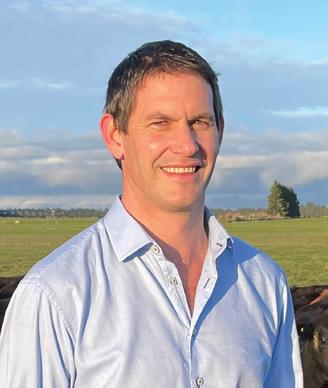
“There’s a lot of different programmes that farmers are involved in or completing which capture a lot of the core components of SAFI.”
The benefits for farmers from taking on sustainable finance are not just about interest rate incentives and a lower cost of capital.
“It will mean they’ll be able to get ongoing recognition for all the work they are doing, and have the meaningful improvement to the environment they are creating through adjustments to their farm management formally acknowledged,” Whillans says.
LactisolTM Nucleus Z1 is armed with zinc oxide, vital in the battle to prevent facial eczema. However, only Lactisol Nucleus Z contains Hy-D®, to improve calcium adsorption, blocked as a side effect of high levels of zinc. And of course, Lactisol Z contains the full SollusTM range of vitamins, trace minerals and antioxidants needed to make your herd healthy and robust. Ask your feed supplier for the newest hero and give yourself a fighting chance.

‘It will mean they’ll be able to get ongoing recognition for all the work they are doing, and have the meaningful improvement to the environment they are creating through adjustments to their farm management formally acknowledged.’Dave Whillans, head of Westpac Agribusiness Research.
When facial eczema threatens, you turn to a hero that has a few tricks up its sleeve.
NZ is well placed to capitalise on the ability for banks to now offer sustainability-linked loans to the agriculture sector, he says.
“The growth in sustainable finance bonds around the world is very aggressive, and there’s a lot of investors that are wanting to place their money into investments that are verified as being sustainable. We’ve got a competitive advantage in that space because our farming models are as sustainable as any elsewhere in the world.”
There will also be opportunities to leverage the improvements formalised through this assurance by becoming more attractive supply chain partners. At a recent Institute of Financial Professionals event dedicated to sustainable finance in the primary sector, BNZ head of natural capital Dana Muir focused on this potential.

“It becomes part of a guarantee that production from a farm meets supply chain partners’ own needs.”
This latter advantage has gained significance over the past couple of months as overseas market requirements for assurance on environmental mitigation activities have started to hit NZ food manufacturers.
In November, chief executive Miles Hurrell is likely to have alarmed some attendees at the company’s AGM when he said that if Fonterra is unable to give its high value customers such as Nestle confidence that it can achieve emissions reduction targets as prescribed, they will look to other product suppliers, including those who are able to produce alternatives to milk.
Prior to this, Fonterra published its own Sustainable Finance Framework to reflect the evolving preferences of its own lenders and debt investors. Fonterra says it will do this by issuing sustainability-linked bonds and loans to mitigate environmental risks and continue to differentiate NZ milk.
It is already providing incentives for farmers to comply with its needs via the Co-Operative Difference initiative where farmers who meet specific criteria including milk quality and other onfarm improvements are eligible for a payment of up to 10c/ kg milksolids (MS).
Earlier this year Silver Fern Farms started on a similar track. In June it announced the establishment of a sustainability-linked financing facility with ANZ, tailored to addressing water use, waste management and GHG emissions reductions which implicates its farmer suppliers and their farming practices.
Like Fonterra, SFF is also mindful of being able to meet the prescriptions for environmental mitigation placed on it by its customers. At the INFINZ event in October, Silver Fern Farms chief financial officer Vicki McColl noted that in order to meet its obligations, as well as meeting the expectations of its market partners, it was possible that Silver Fern Farms won’t be able to support some of its suppliers in the future.
These barely subtle warning shots to suppliers are based on the likes of Fonterra and Silver Fern Farms and others shifting their GHG reporting to include ‘Scope 3’ emissions - those emissions the company is indirectly, as well as directly responsible for, up and down its value chain.
This means the likes of Fonterra will have to report on its own manufacturing emissions, but also those made by producers of its products and those who deliver its goods to market. As alluded to above, this directional shift is being forced on it by international customers who have their own ambitions to deliver proof of their own sustainability credentials.
If farmers are sceptical of the motivations of their co-ops and other partners, the same message is being consistently broadcast by those with exposure to wider influences on supply chains.
NZ trade negotiator Vengalis Vitalis, who stitched together the NZ European Union free trade agreement, recently made the point that he reiterated immediately after concluding the deal in June, that EU negotiators were primarily focused on sustainability and how climate change issues were being dealt with NZ.
In a sense, the message was: access to the EU market will increasingly be determined by how good our story is on sustainability. In a similar vein, Finance Minister Grant Robertson said in November that during a business delegation trip to the United States, every conversation he’d had with business people on food production was on how we could describe the impact our food exports were having on the climate.
Back to sustainable finance. There is no sense at this stage that farmers will be forced by banks into adopting it in order to qualify for new lending. For one, Whillans points out that for it to work, farmers have to want to do it. But with an ever-increasing pot of money from conscious investors wanting to make a difference, and the assurance falling into place, the advantages of at least exploring its potential benefits, particularly longer term, are stacking up.
‘We’ve got a competitive advantage in that space because our farming models are as sustainable as any elsewhere in the world.’

2022 Mystery Creek National Fieldays
Farmgate is a purpose driven company with a vision to reduce rural crime by 50% through our clever tech and partnerships.
The FarmARMr system uses license plate recognition software and high quality German cameras to detect vehicles coming and going on properties. It is solar, 4G and battery powered.
The camera and barrier arm system is specifically designed for dairy farms to help manage vehicle assess and promote visibility at the farmgate.
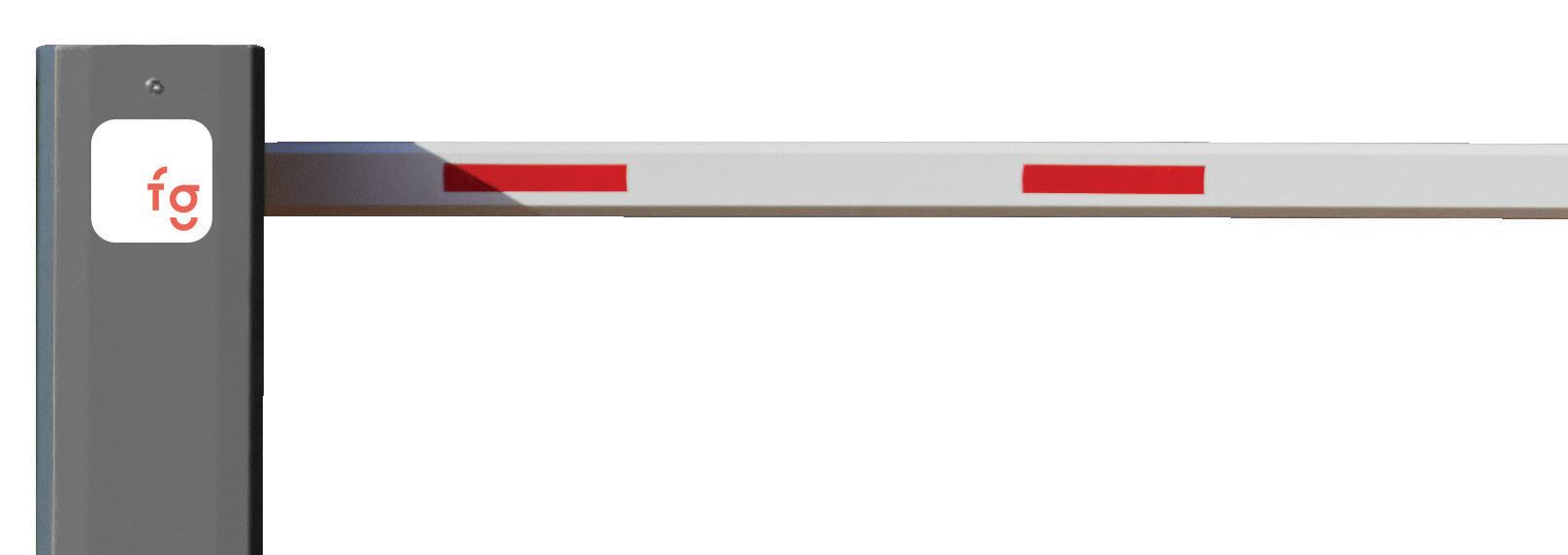
What makes it work?
Artificial Intelligence detects vehicle plates at the tanker entrance. Milk tankers and farm traffic pass right by the barrier arm – only unrecognised vehicles are stopped until you let them onto your farm using your mobile phone APP.
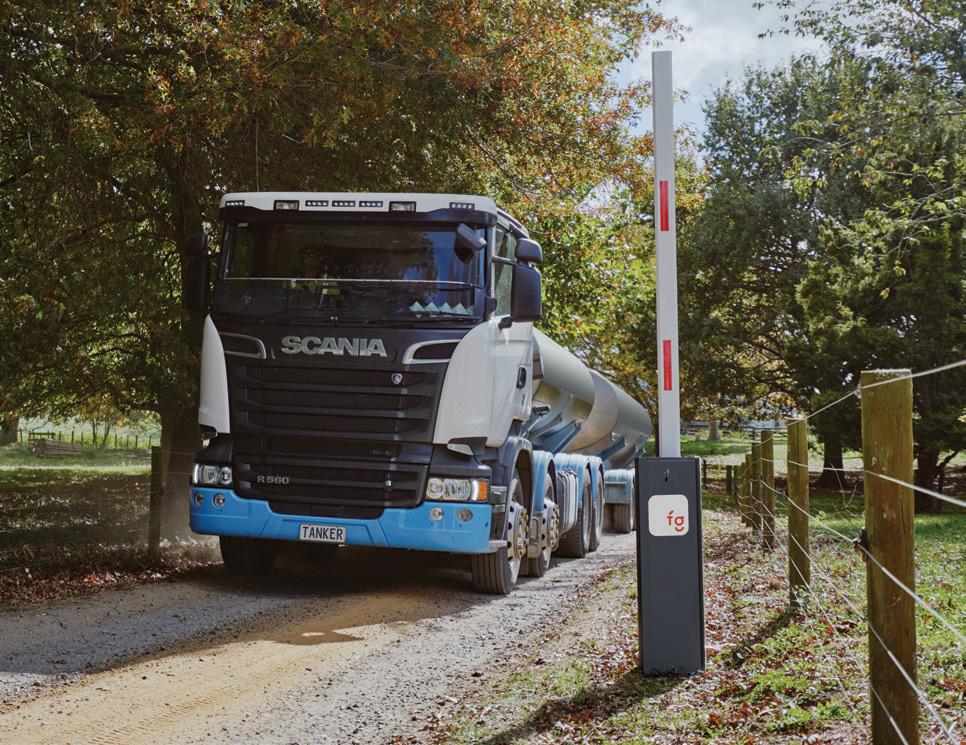
Why does this matter?
We’ve calculated that up to 60% of farm theft occurs through the tanker track in a stolen vehicle. That’s why our Stolen Vehicle Register connects NZ Police data with our community APP to notify the user and local communities when a stolen vehicle is about.
Stop crime in its tracks with Farmgate
To learn more or to request a quote via our website, visit:
www.farmgate.co.nz

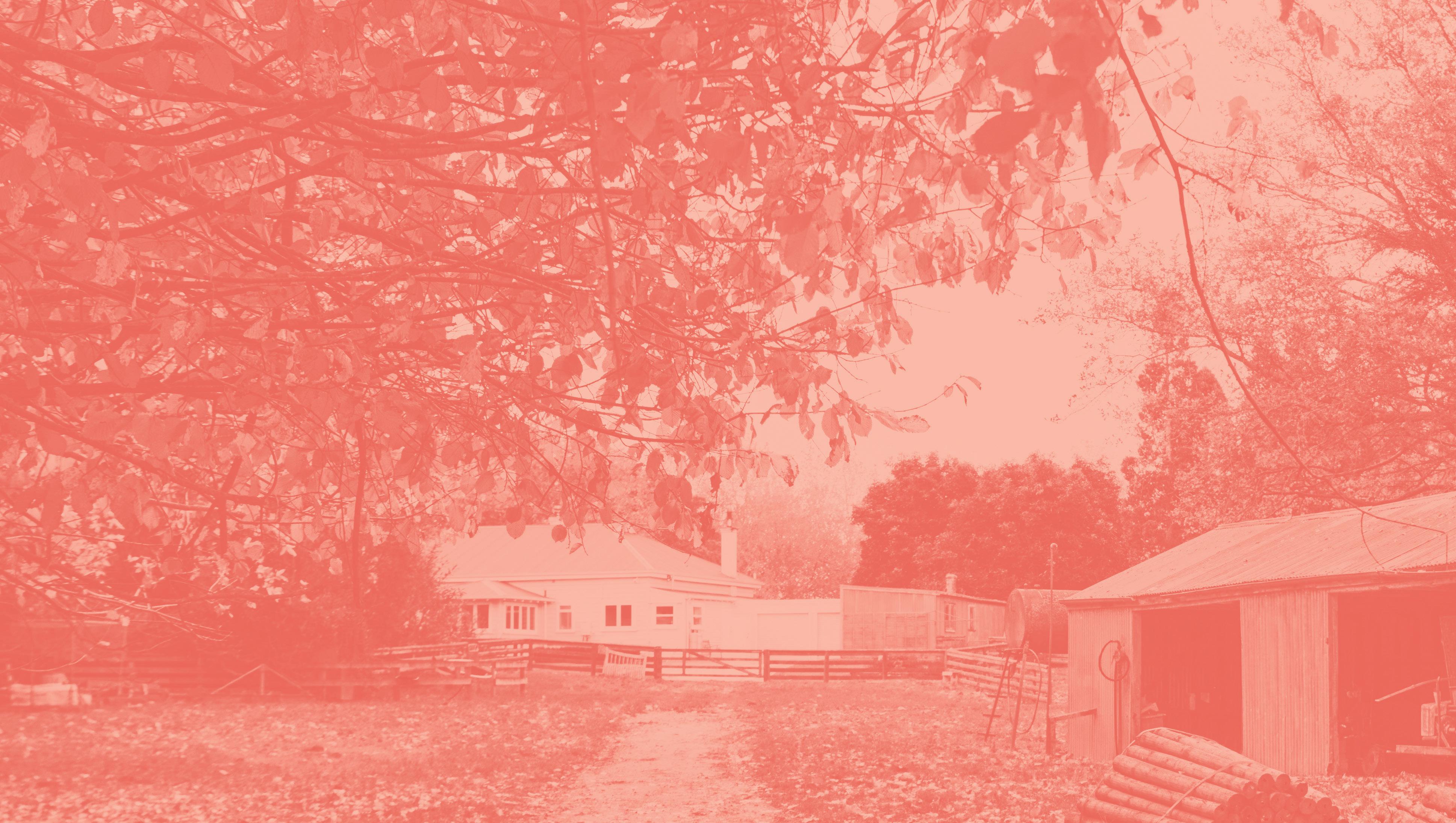
Senegal, Ghana, and more recently Argentina, while still in small proportions, as none of them seem to have fit in.
While the most common complaint expressed by Brazilian dairy farmers has been the significant increase in production costs in the last two years (from NZ$4.76 to NZ$8.73/kg milksolids), their structural bottlenecks are actually labour shortage and family succession.
In farmers’ own words, “dairy farm labour is difficult to find, when we find them they’re usually no good and when they’re good they do not last”.
This will come as no surprise to Kiwi farmers, where the problem has been present for years now, but it is recent in Brazil. Mexican immigrants are known to fill a similar gap in the US, Indians in Italy, Turks in Germany, Portuguese in the United Kingdom, South Americans from various countries in New Zealand and so forth. In Brazil, we increasingly see immigrants from Venezuela, Bolivia,

Brazil has made good investments in education over the last few decades but no efforts have been made to train dairy farm operators, especially milkers. Also, Brazilian farmers are not prepared to deal with the newer generations of employees, especially in modern labour legislation.
More recently, a number of private training courses and consultancy services have specialised in helping farmers acquire the skills to better manage rural human resources, but it is far from making a difference yet.
High costs, insufficient skills, unreliable or poor performance, and high turnover are the main employers’ concerns. Employees, on the other hand, complain about low wages, long hours, not enough days off, remoteness of some farms, living and working conditions (especially housing and milking installations).
On many dairy farms, the younger generations are not interested in continuing their parents’ business. Those
who fall into this category find it takes too much effort, risk and commitment for a very limited net income. However, this perception has improved slightly with increasingly better internet access in the countryside. Parents who manage to get their children to continue their business are usually those who get them involved early in life and value their participation throughout. Also, these parents tend to be more open minded and willing to adapt and change where needed.
Access to new technological solutions, especially in the last decade or so, has helped improve quality of life and to some extent the perception that the young ones had about dairy farming as “slaves’ work”, as it was often uttered.
The table illustrates recorded and expected changes in number of farms and cows, as well as in cow and farm annual production, all relative to 2015 (set to 100), for the state of Rio Grande do Sul in South Brazil, one of the most important dairy regions in the country. From 2015 to 2021 there was a staggering 52% reduction in the number of dairy farms, 26% reduction in cow numbers but only a 3% reduction in milk production. This was thanks to a 31% increase in milk production per cow.
The trend is forecast to continue to 2030, when only 14% of the farmers will be milking 44% of the cows, which will have more than doubled their production to yield a similar amount of milk per farm, as of 2015 figures.
Numbers of dairy farms and cows have plummeted in Brazil, but milk production has largely held up. By Wagner Beskow.
Few things are more relaxing than the sight and sound of calm, happy cows tucking into a good paddock of grass. But look closer – your girls aren’t actually relaxing! Each one is working hard to get the thousands of mouthfuls she needs to sustain herself for the day.
What if you could take some of the effort out of that process for them? From next autumn, you can, simply by sowing a new ryegrass that has been purpose-built for easier eating. Just what the doctor ordered Cows can’t tell us in words what makes a pasture able to be consumed more efficiently. So when we started breeding Array NEA2 ryegrass for high intake and easier grazing, we sought the next best source of advice.
Working with an animal scientist, the research tells us grass that stands up tall and erect – closer to those busy mouths – takes less time and effort to graze than grass that flops on the ground.
Twenty years of research and development later, the erect, dense pasture produced by Array NEA2 is now standing by to help your cows eat their fill more easily every day, and give them more time to relax,
ruminate and produce milk. That’s better for them, and for you, too.
In research trials, Array NEA2 has grown significantly more feed under low nitrogen conditions than other ryegrass cultivars.
What does this mean for your farm? More even pasture growth at times when soil nitrogen is deficient, something that happens on virtually every farm at some stage during the year; and a win for the environment, because you’re utilising nitrogen more efficiently.
This new diploid also has the best cool season growth of any perennial ryegrass we’ve bred, to help fill the gap when feed is short, and make your farm more resilient in shifting climatic patterns.
Seed for Array NEA2 is available for autumn sowing. Find out more from your retailer.
If you like hard data to support your pasture renewal decisions, check out the latest results from the National Forage Variety Trials – they’re available now.
Independent, industry-run and audited, these trials provide a forum for pasture companies to test their breeding material, and rank its performance compared with others.
We’re involved because want you to be confident about buying our seed. That’s why we’re pleased to see new Array NEA2 diploid perennial ryegrass at the top of the national summaries, unbeaten for total yield.
That lifts your supply of farm grown feed, and keeps animals well-fed.
Because National Forage Variety Trials trials are run under very good management, they give a good snapshot of optimal yield. So we also test new cultivars under real-world conditions on farms with known persistence issues, to give us a better picture of pasture resilience.
We need to know how new ryegrasses perform in dry summers and wet winters, for example. Like our low nitrogen breeding trials, this multi-faceted approach helps us create pastures that meet the wide-ranging goals of New Zealand dairy, both today and tomorrow.
Visit www.barenbrug.co.nz for more information.

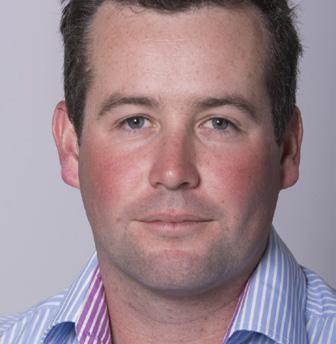
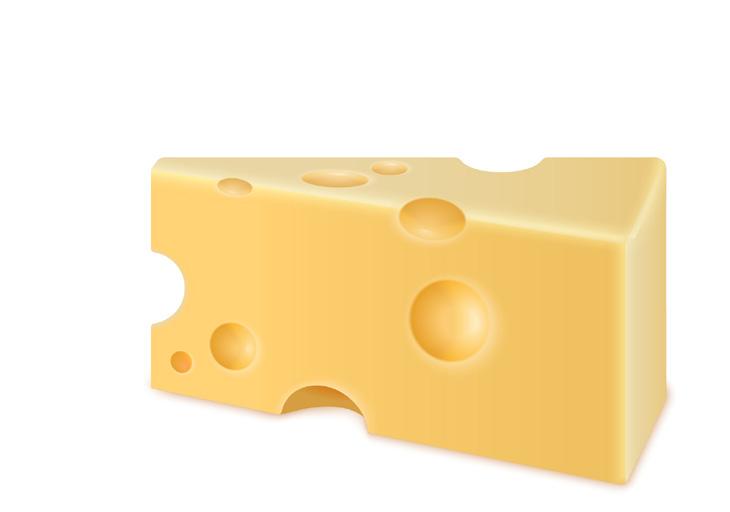

John Maynard Keynes presented The General Theory of Employment, Interest and Money in 1936, profoundly changing economic theory at the time. It still drives the basis of most economic theory today.
One of the key theories outlined in this revolutionary work was “The Propensity to Consume”, which states that as interest rates increase, all else being equal, then the propensity to consume must reduce. See where I’m going?
So, we find ourselves in the middle of another period economics students will study for years to come: a pandemic, the fallout from the resultant monetary response by governments and then the bubbling global economy that is the result, let alone what Tsar Vladimir’s imperial war has done to oil, fertiliser and grain markets. Not to mention the pain as interest rates are pumped higher to cool raging inflation, before it burns through the value of any currency in front of our eyes and reduces us to mediaeval squalor. A stretch maybe, but a rough comparative for the basis for monetary policy responses to inflation. I’m sure you’ve made the link. Interest rates are going up, so consumption will fall. Now, the tricky part is zooming into one commodity within an entire global economy. Economic forecasts are relatively simple when you’re looking at the entire system. When looking at a diverse product like dairy, and how the consumption of the 100+ products that are derived from milk will shift, it gets difficult. Thus why most analysts stick to the big-ticket items, and use them as a proxy for the rest of the market; I’m not going to be any different, I’m just outlining why I can’t tell you the rate of change of cream cheese lollipop sales in China for Q2 2024.
So, the global consumer is faced with rising interest rates,
along with the expectation that most developed economies will be in a recession at some point during 2023. As explained, we know the increases in interest rates will cannibalise overall consumption in some way, but the question is: where on the chain of value do consumers place dairy products today?
The 2008 Global Financial Crisis (GFC) resulted in dairy being consumed less by most consumers as dairy was viewed as a luxury, especially in Asian markets where it is not a cornerstone of the historical diet. This definition of luxury meant dairy was one of the first products left out of the shopping trolley.
But something is very different with this economic speed bump, post-pandemic is a very different position to post-GFC. Throughout history, pandemics change how humans behave around health and self-care, while financial crises just ruin the population’s trust in capital markets.
The easiest example here is the change in communication around the health or immunity benefits of consuming more protein, especially dairy protein, from the Chinese government during early stages of the pandemic. This change in association of products from “luxury” to “health product” is one of the key indicators that
consumption levels of dairy are likely to be very different to those post-GFC. But it’s harder to pinpoint the scale of the change. This is partly due to the unknown impact of interest rate increases or the depth and length of the likely recessions.
Notably, the significant change to Chinese consumption is the normality with which younger generations consume dairy. This wave of generational change is helping to cushion consumption, with the benefits of including a great source of calcium and protein into children’s diets not lost on parents in China. As a generalisation, we expect overall product lines like cheese, caseins and liquid milk consumption to have a much higher consumption baseline than 14 years ago, which is less likely to be influenced by inflation than other dairy products. The entire cheese category is growing at a compound annual growth rate (CAGR) of 22.6% since 2008 in China, with yoghurt and sour milk products coming in second best, only managing a CAGR of 12.0% over the same period. So, we know interest and inflation are going to impact consumption over the coming year, without doubt. We are seeing these metrics change in markets already. However, we estimate that due to changes in consumer habits over the last 14 years, we expect baseline demand to be significantly higher than during the 2008 GFC, a small cushion for what could be a hard landing.
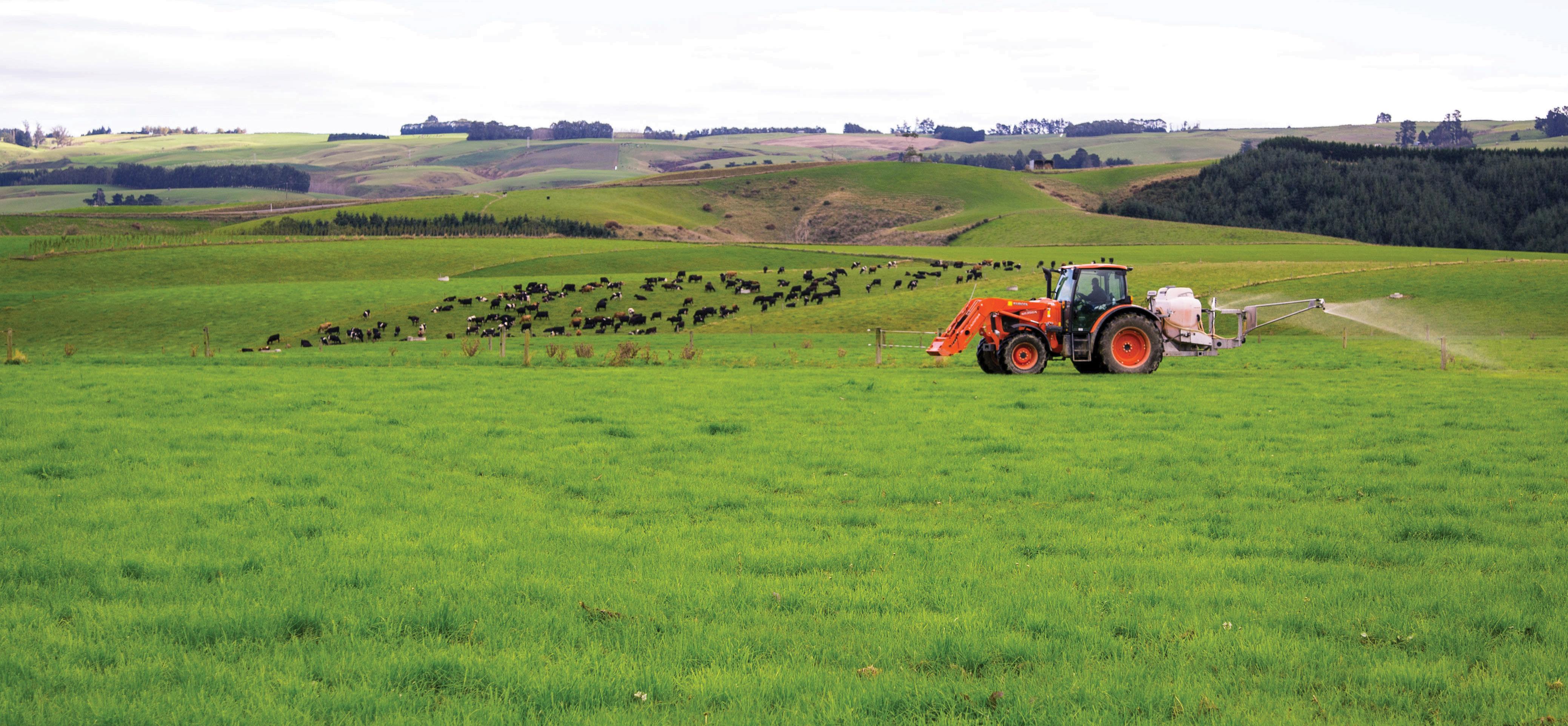

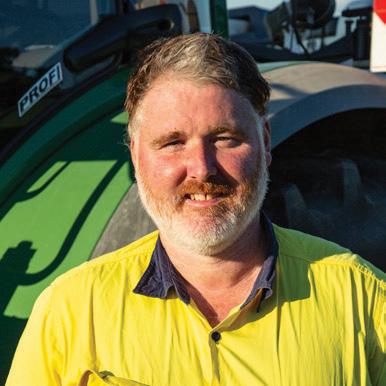
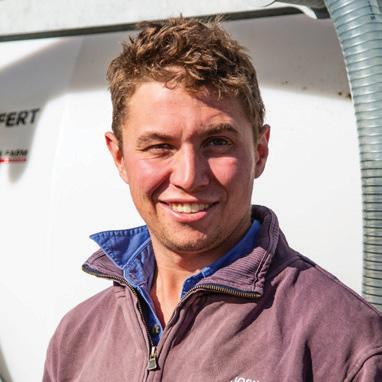
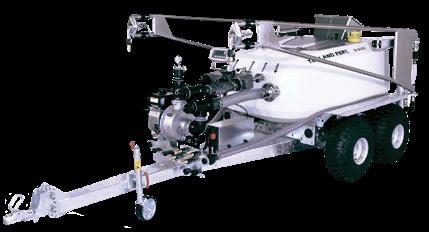
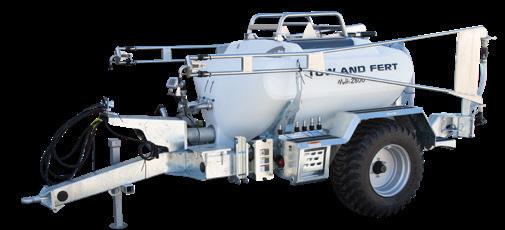
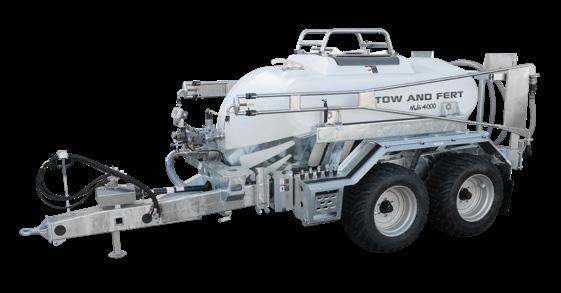
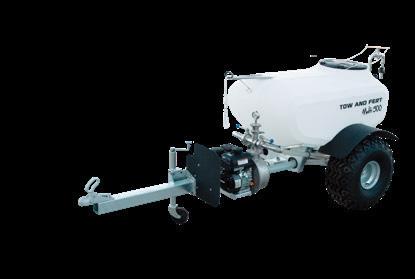
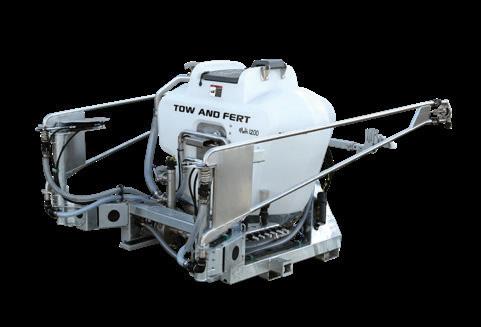
Robust evidence shows the Earth’s temperature is rising at a pace not seen before in its history and New Zealand farmers must take steps now to avoid the worst impacts.
That was the message delivered to those who attended the NZ Institute of Primary Industry Management (NZIPIM) Climate Change Seminar for Rural Professionals in November.
“Some say climate change doesn’t matter to New Zealand but that’s not true. It will have implications globally and for us. It will cost us to mitigate but cost us a lot more if we don’t,” Sinead Leahy, Principal Science Advisor New Zealand Agricultural Greenhouse Gas Research Centre (NZAGRC) said during the seminar.
“There is still a wide spectrum of opinion about climate change including that the climate isn’t warming and we shouldn’t worry.
“However, it is very difficult to argue against the data which shows temperatures rising from the 1950s onward and increasing at a rate never experienced in our planet’s history. It is indisputable now that humans are causing climate change and Earth’s inhabitants need to be incredibly concerned about it,” Sinead said.
Fellow presenter Phil Journeaux, agriculture economist with AgFirst said as NZ’s climate changes, it might not be possible to farm in the same way as we do now.
“A couple of degrees of warming might not seem much, but it can have a big effect on pasture
The world, and New Zealand, is getting hotter and weather patterns are changing as the heat goes up.
and crop growth and on pests, diseases and animal welfare. Ryegrass won’t grow at temperatures above 25 degrees.
“The upper North Island could go from a subtropical to a semi-monsoon climate with wet winters and hot dry summers. Friesian, Hereford and Angus cattle would be long gone in this scenario.
“Farming will be very different, and we need to sort out water policies because irrigation will be crucial in many areas.”
Designed to expand rural professionals’ understanding of climate change, why agricultural greenhouse gas emissions are important in NZ, how they can be estimated within the farm system, and how they can be reduced on different farms, the allday seminar, was attended by 25 rural professionals from around the country. Nearly 40 of these seminars have been held since mid-2019, attracting more than 670 people.
The seminar sought to answer some of the questions rural professionals most often heard from farmers including around animal emissions, methane and carbon sequestration.
A frequently heard comment was that there had always been large numbers of ruminant animals on the planet emitting greenhouse gases.
“The number of ruminant animals in the world has never been greater than today. In North America it’s estimated there were once 70 million bison but today
there are more than 200 million cattle in the USA,” Phil said.
“In New Zealand if you go back a few hundred years there were no ruminant animals here. Today we have around 40 million in NZ and those growth trends have happened all around the globe.”
Another argument was that methane doesn’t matter or that methane and nitrous oxide make an insignificant contribution and should not be targeted in any national framework for reducing emissions.
Sinead said although methane (CH4) is a shortlived gas, it does matter when it comes to limiting global warming.
“Methane can have a very important role to play in reducing climate change. New Zealand is the first country in the world to acknowledge that not all greenhouse gases are the same. There are different targets for different gases in New Zealand, recognising the different warming effect of methane in the atmosphere.”
The Government has legislated long-term targets to reduce NZ’s greenhouse gas emissions, including that carbon dioxide and nitrous oxide (the ‘long-lived’ gases) need to reduce to net zero by 2050. Methane emissions are to reduce to 10% below 2017 levels by 2030, and 24-47% below 2017 levels by 2050.
However, in the scenarios for achieving the goal of limiting warming to well below 2°C, in contrast to carbon dioxide emissions, methane emissions do
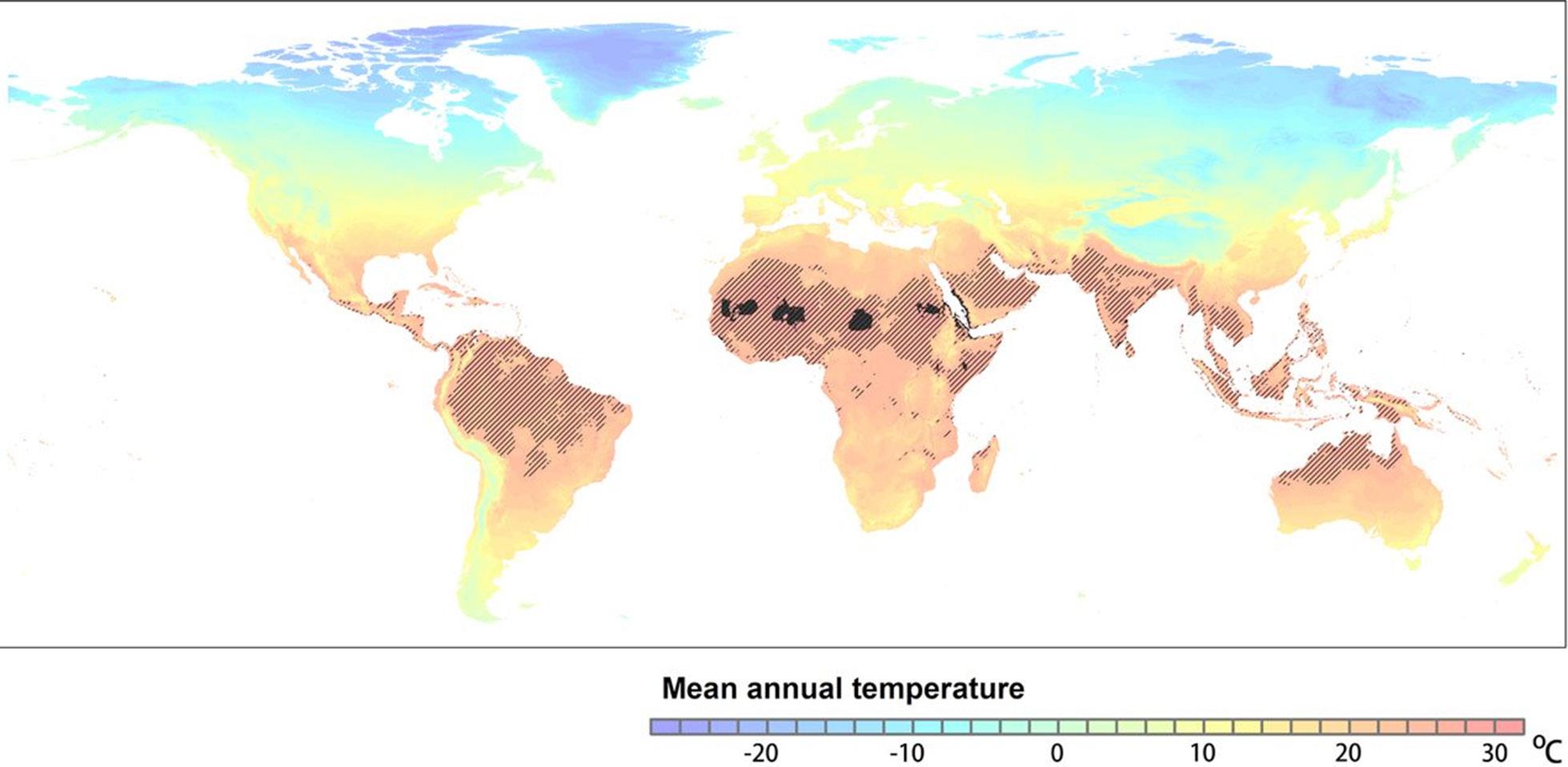
‘A COUPLE OF DEGREES OF WARMING MIGHT NOT SEEM MUCH, BUT IT CAN HAVE A BIG EFFECT ON PASTURE AND CROP GROWTH AND ON PESTS, DISEASES AND ANIMAL WELFARE.’This map shows average temperatures, highlighting in black the areas that are too hot for human habitation today. In cross-hatched black are the areas that will be too hot for humans by the year 2070. Such areas include some of the most populated regions of the globe. Source: “Future of the human climate niche”, Xu et al, PNAS 2020.
not need to go to zero. Methane has several sources, including wetlands, landfills, forest fires, agriculture and fossil fuel extraction. In NZ, the largest proportion (about 95% of total methane) is belched out by livestock. This is known as ‘enteric methane’.

The average dairy cattle beast produces about 98kg of methane a year, the average beef cattle beast produces 61kg a year, the average deer about 25kg and the average sheep about 13kg a year.
who live here. We export close to 90% of the food we produce and as a result we are dependent on what our customers want. Our big clients like McDonalds, Nestle, Danone and Tesco are all facing regulations in regards to climate.”
For many of NZ’s customers, a significant proportion of their greenhouse gas emissions will come from their farmer suppliers so it is likely they will impose emission reduction targets for them to meet.
Many places will see more than 80 days a year above 25C by 2100, which will have a significant impact on ryegrass growth (it prefers temperatures of 5-18C) and animal performance
Winter and spring are very likely to have increased rainfall in the west of the North and South Islands and be drier in the east.
Summer is likely to be wetter in the east of both islands, while the west and central North Island will be drier.
All areas are likely to get more very extreme rainfall, especially shorter, more intense events.
Increased drought frequency in many regions of New Zealand and farmers in dry areas can expect up to 10% more drought days by 2040.
Nitrous oxide is emitted into the atmosphere when naturally occurring microbes act on nitrogen introduced to the soil via dung, urine and fertiliser. Nitrous oxide accounted for 11% of NZ’s total greenhouse gas emissions in 2020, the largest source of which came from livestock urine and dung.
NZ dairy farmers had become very efficient in increasing milksolids per cow through means including better genetics and pasture management, Sinead said.
“We do know if farmers farmed the same way now as in 1990, instead of 17%, our total agricultural emissions would have increased by about 40%. Farmers have made a lot of efficiency gains which have nothing to do with climate change but with their bottom line. Efficiency gains still have a role to play in reducing absolute emissions,” she said.
Overall, NZ’s emissions are small at just 0.17% of global gross emissions (22nd among developed countries). However, per capita our emissions are the sixth highest in the world.
Sinead said some people argue that reducing NZ’s emissions is perverse.
“They say that if we reduce production here with a price on agricultural greenhouse gas emissions, other, less-efficient, producers will increase their production and total global emissions will go up. But it’s not quite as simple as that.”
Many of NZ’s competitors produce similar emissions per unit of product and have national mitigation targets to meet. If they expand their agricultural production, emissions must reduce somewhere else in their economy. Competitors in the developed world also face constraints on production. There is scope to maintain production and reduce greenhouse gas emissions.
“We are a trading nation and produce more food than required by the five million people

Phil said some farmers asked why they could not claim carbon credits for the grass they grew.
“Grass removes carbon dioxide from the atmosphere as it grows but returns it to the atmosphere when it is harvested and utilised,” he said.
Trees do exactly the same. However, the interval between growing/harvesting grass is weeks, whereas trees are harvested after decades or centuries – or not at all. The same quantity of carbon is stored in grass at the start and end of each year. The quantity of carbon in a tree increases year on year, while the tree grows.
The seminar spelled out clearly that NZ’s gross emissions are increasing and why action to reduce them is crucial.
In 2020, NZ gross emissions were 78,778 kilotonnes of carbon dioxide equivalent (Mt CO2-e), comprising 44% carbon dioxide, 44% methane, 11% nitrous oxide and 2% fluorinated gases. This represents a 21% increase in emissions since 1990 (which is when international reporting obligations for greenhouse gas emissions began).
In 2020, 73.1% of NZ’s reported agricultural emissions was enteric methane from ruminant animals. A further 20% of agricultural emissions was nitrous oxide, largely from the nitrogen in animal urine and dung, with a smaller amount from the use of synthetic fertilisers. The remainder of agricultural emissions in 2020 were mostly methane from manure management (4.4%) and carbon dioxide from fertiliser, lime and dolomite.
For more information on the topics covered in this seminar, please see www.agmatters.nz
CRIME SCENE – CRIME SCENE – CRIME SCENE – CRIME SCENE – CRIME SCENE – CRIME SCENE – CRIME

CRIME SCENE – CRIME SCENE – CRIME SCENE – CRIME SCENE – CRIME SCENE – CRIME SCENE – CR
The increase in the incidence and frequency of known and suspected rural crime is borne out by last year’s Federated Farmers survey. The 2021 survey answered by 1200 Feds members showed more than half (52%) of the respondents had experienced or suspected they had been the target of rural crime.


That’s a 10% increase from the previous survey in 2016. Over the same period the frequency of rural crime increased with 37% reporting two or more incidents compared to 22% in 2016.
The stats will come as no surprise but raises the questions of what’s driving it, and what steps farmers can take to keep livestock, property and themselves safe from criminal harm.
Federated Farmers rural crime spokesperson Colin Hurst believes the trend is reflective of what’s happening across society as more people struggle financially and illicit drug dealing becomes more widespread.
“I think that generally rural people are honest so there’s naivety about how criminals work and what they get up to, especially when it’s based around drugs. What we do know is that once the drug element is present it tends to turn a rural community upside down.”
The Feds are doing their bit to raise crime and security awareness by running rural crime prevention workshops, in conjunction with the police, throughout the country. They’re not intended as a precursor to a Neighbourhood Watch type of group but rather a starting point for discussions and awareness around rural crime, and to encourage farmers to report suspected thefts.
Hurst says the under-reporting of actual or suspected rural crime is a big problem. Farmers often flag the reporting of burglary, vandalism and other acts of crime because they don’t have sufficient evidence or assume police won’t be interested enough to follow-up. But he says the reporting of suspicious activity is a crucial step in prevention because it can uncover patterns and waves of crime which over time can lead to the apprehending of offenders.
But the tardiness of the police in responding to crime in rural areas is a huge frustration which is covered off in just over three pages of an 80-page report by the Independent Police Conduct Authority Review.
The 2018 report followed several complaints about policing in small communities. Discussion around the question of ‘are members of small communities easily
Rural crime is an increasing problem as more people struggle financially and illicit drug dealing becomes more widespread, Lynda Gray reports.
Are farmers doing enough to keep their stuff and property safe?
No, judging by responses to the 2021 survey with just over half improving their security in the wake of a rural crime incident.
Lock and key are no longer enough to keep property safe. Experienced criminals armed with easy-to-use cutting tools can make short work of padlocks and chains on gates to paddocks, implement sheds and woolsheds.
However, criminals are more likely to bypass farms that have padlocked access along with other deterrents such as sensor lights, dogs near sheds, and security cameras.
The NZ Police security checklist is a good starting point to gauge the status of your farm security.
https://www.police. govt.nz/aboutus/publication/ security-checklistnew-zealand-ruralproperties

able to contact their local officers’ highlighted the difficulty people had in getting hold of help. Police took too long to answer calls or respond to messages, which discouraged them from trying and this is why crime was underreported.
If you see something, do something, that’s the message from Inspector Paul Carpenter who is leading the New Zealand rural police model.
The finger is often pointed at police for not following up on reported rural crime due to the perception of scant resources but that’s not the case, he says.
“We understand that farmers are interested in what’s happening due to perceived resource constraints and we want to change that.”
The answer is not through the employment of more rural police but rather improved communication links and promotion of them, he says.
There are 165 police staff distributed among 104 one-to-three police officer rural community stations which cover about 60% of the country’s geographical area. It’s a huge expense and satisfying everyone is not easy, but Carpenter says feedback from rural police is that the fundamental model is working although it needs to be updated to deal with the increasing volume of calls.
“The police are there and contactable, our job is to raise awareness of how best to share information.”
A combination of online means and better resourcing of the 105 Police nonemergency number is being worked on, he says.
The 2021 rural crime survey is the second undertaken by Federated Farmers.
The first in 2016 gave a snapshot of where rural crime was occurring and what the focus of those crimes was.
Respondents in both surveys were quizzed on property stolen, livestock stolen, livestock killed, poaching or foraging, property damaged or vandalised, and the clandestine onfarm growing of drugs.
Of those surveyed last year more than half had been victims of crimes during the past two years.
Smaller farm equipment (other than machinery) accounted for 46% of items stolen followed by fuel at 45%. The theft of motorbikes, quadbikes or other farm vehicles accounted for 27% of reported thefts.
Survey feedback noted very new bikes and vehicles were targeted, probably by the same criminals who stole the old vehicle. Respondents reported several occasions of quadbike theft despite removing keys and locking sheds.
Some were now using specialist quadbike locking systems to prevent further thefts. About 14% of respondents had had or suspected stock had been stolen from their farm.
About 8% of total respondents had had or suspected that drugs, mostly cannabis with some suspecting methamphetamine, were grown or manufactured on their farm. Many of the respondents who knew cannabis was being grown on their farm avoided the area and didn’t report the activity to avoid repercussions.
The grouping of respondents according to their location revealed Bay of Plenty, Hawke’s Bay, Gisborne-Wairoa and North Otago as crime hot-spots, recording significantly above the average for having had or suspecting an incident in the last two years.
Rural Outlook is a new-release police app for logging suspicious activity. It was launched in early May and is being trialled in the Waimakariri and Hurunui districts of North Canterbury.
Federated Farmers is backing the trial by encouraging farmers to upload the app. By mid-June about 2000 had uploaded it and 40 incidents had been reported. The app can be used outside of cellphone range and farmers can tag their location, upload photos, and other relevant details. It is intended particularly for incidents which might otherwise go unreported such as illegal hunting, trespassing, illegal use of drones, deliberate damage, theft of fuel and stock.
“We know that under-reporting of crime is a big problem in rural areas and we hope this will encourage people to report these incidents,” Federated Farmers North Canterbury president, Caroline Amyes. She has her own story of not bothering to report suspected crime. Gates went missing from her lifestyle block at Whitecliffs. “It was
a pain and rather than report it we just went and replaced them. We later found out it was happening around the community so if we had reported it the police may have got on to it sooner.”
Feedback from users of the trial app has been positive. It’s easy to use and people say they’ve had good follow-up from the police, Amyes says.
A couple of recent examples was the reporting of illegal street racing. The logging and photograph with clear identification of number plates was the evidence police needed to follow up. In another situation police were able to get the exact location of a dumped car in an isolated area from a photo sent on the app.
“It’s giving the police more data of where incidents are happening so that they can target their resources.”
The app is being trialled for two years after which a decision will be made about further rollout.
• First published in Country-Wide magazine, August 2022.
The installation of sensor lights about six months ago on Colin Hurst’s cropping farm at Makihiki, South Canterbury, was a simple $1700 investment. He bought two Eufy Cam Security kits from Noel Leeming. The system, ready-to-go out of the box, is wire-free with a 365-day battery which keeps working if and when there’s a power outage.
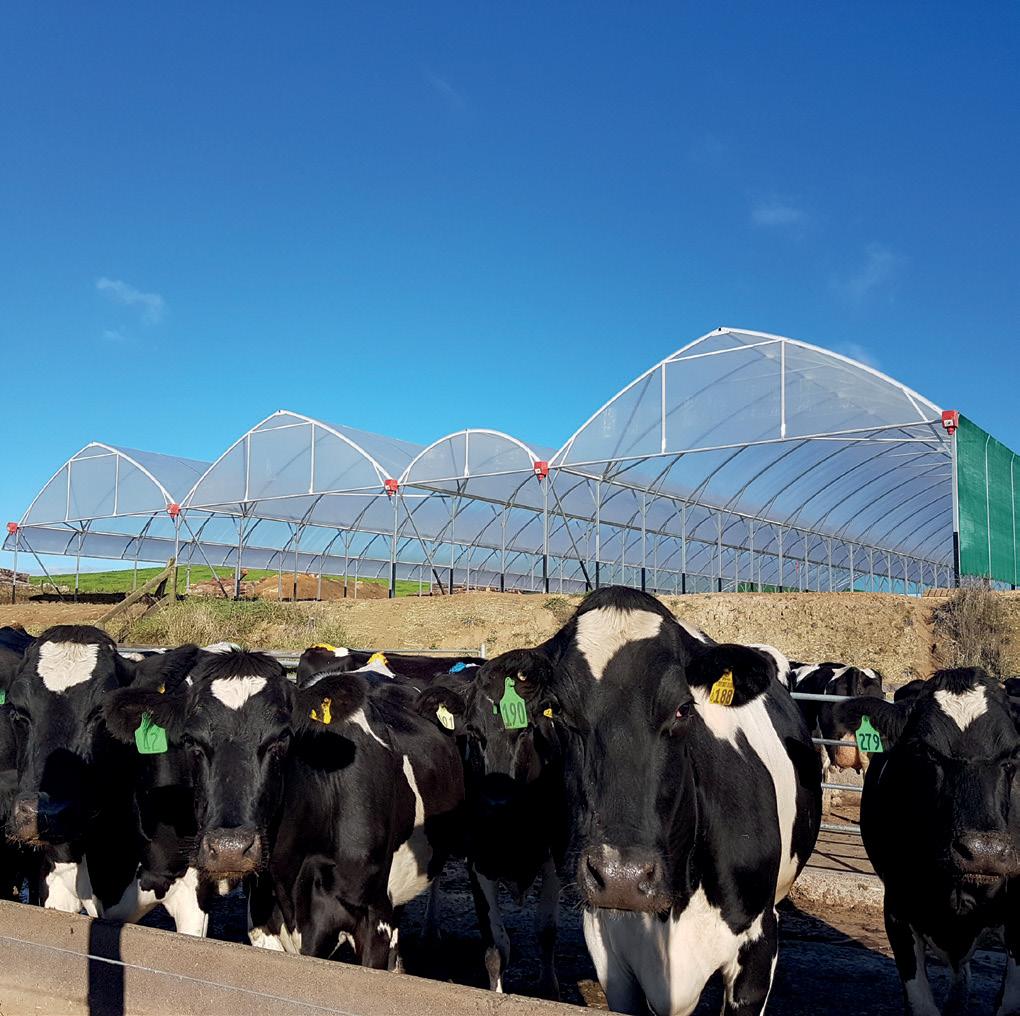

The system has facial recognition to reduce false alerts, stores video without the need for cloud storage and is weatherproof. The high-resolution camera picks up clearly the number plates and defining features of unwanted guests. The cameras overlook the fuel tanks, workshop, house and driveway.
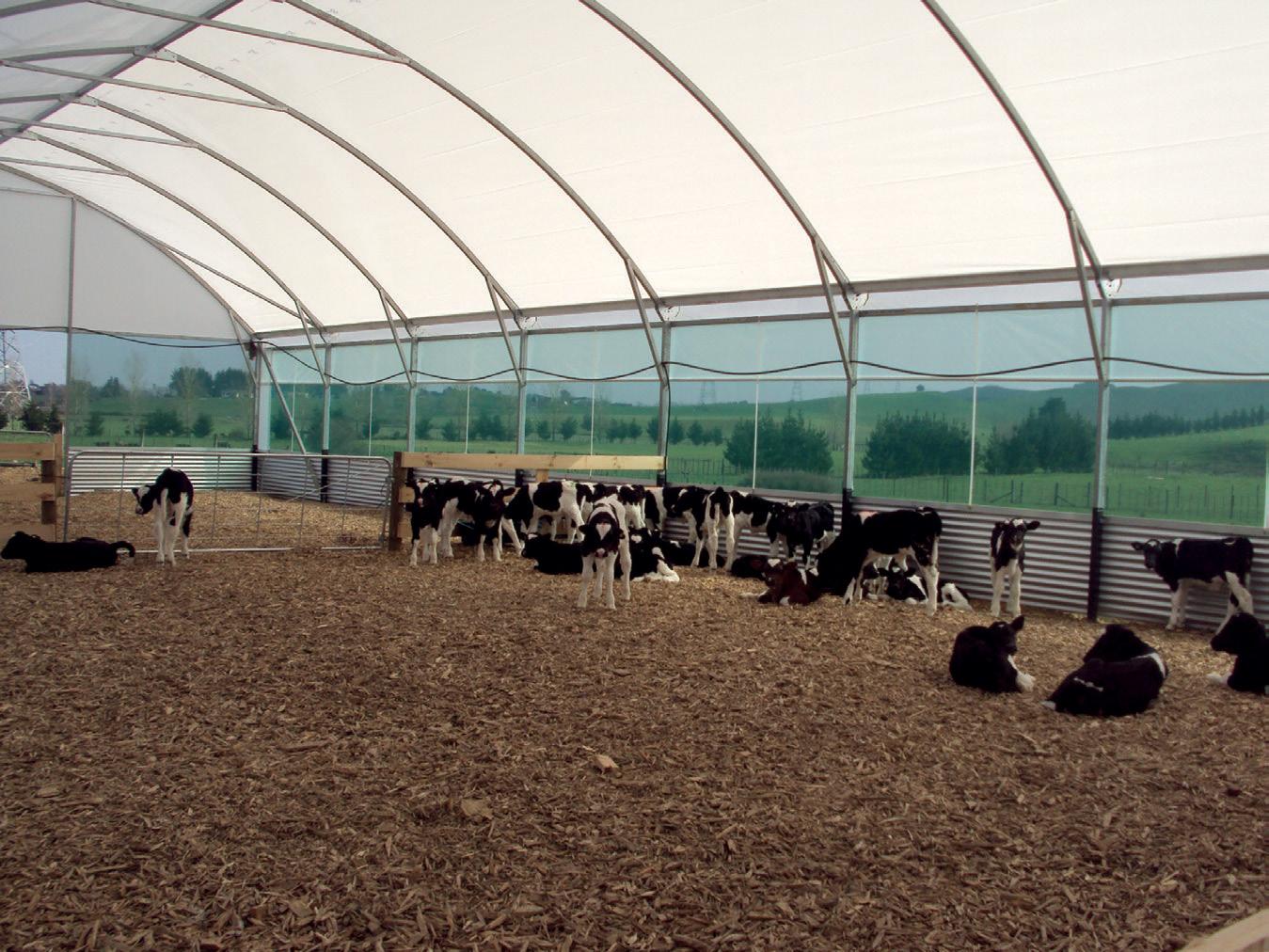
"Generally rural people are honest so there’s naivety about how criminals work and what they get up to..."
Dairy Holdings is selling nearly 3000 hectares of dairy farms near the top of the South Island which were all converted by entrepreneur Avon Gillespie, who changed the face of the Maruia Valley to dairying.
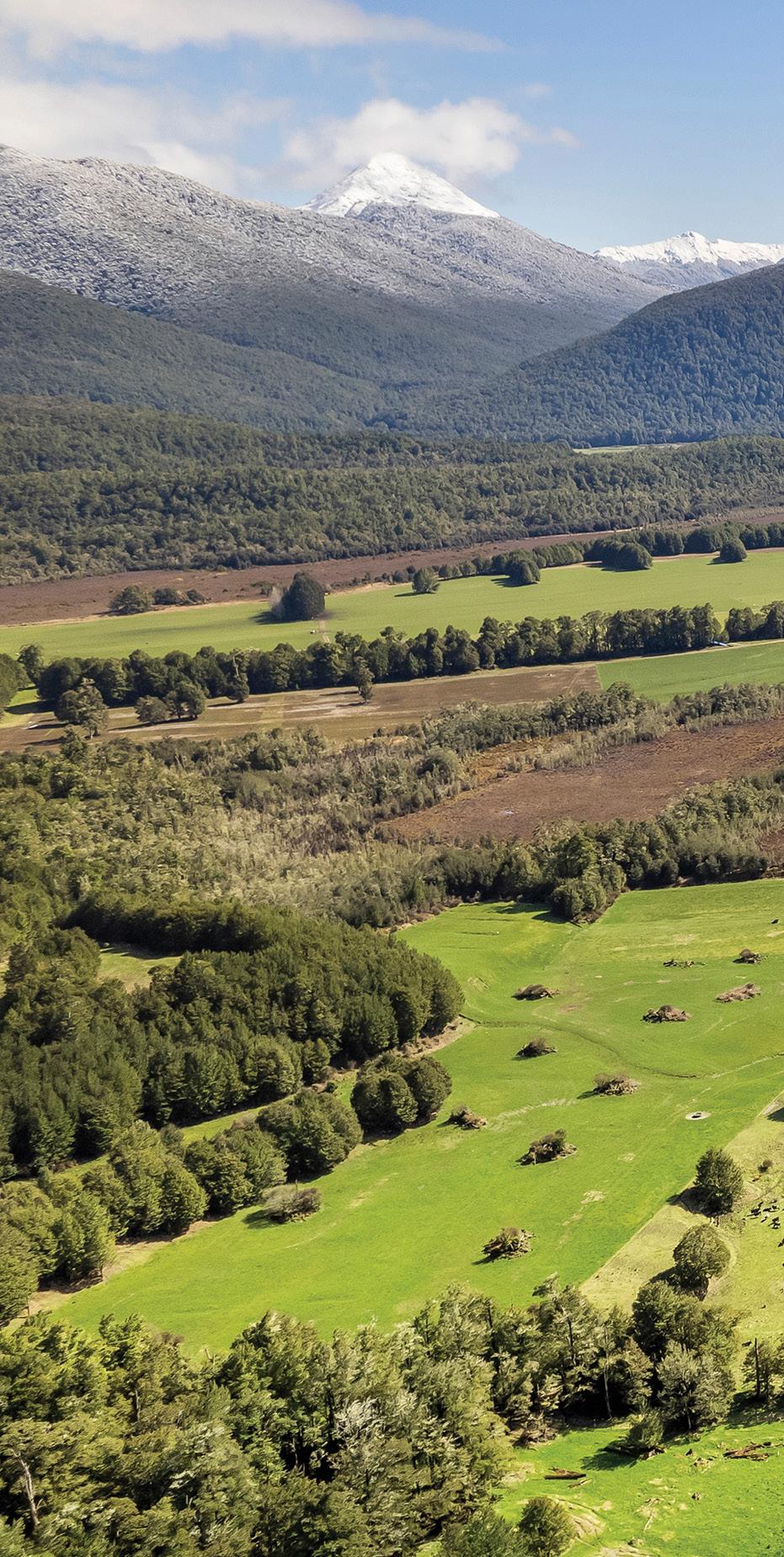
In the late 1990s, Gillespie was a star in the dairy industry – a champion sharemilker - on a farm in the Tutaki Valley near Murchison. In just a few years he converted six large-scale dairy farms between the Tutaki and Springs Junction that each milked between 1000 and 1700 cows.
More farms were owned or leased around Murchison and Westport in his farming enterprises that milked about 10,000 cows before it all went sour. By the end of 2006, eight farming companies that he co-directed were in receivership, owing the Bank of New Zealand about $37.5 million.
He was on a downhill spiral that went beyond financial woes, with crimes involving drugs, violence and weapons sending him to prison and also fraud after he created a fictitious herd to gain more funding.
Despite his spectacular fall from grace, Dairy Holdings’ chief executive, Colin Glass, says Gillespie was generally remembered as a likeable rogue who wasn’t
scared to push the boundaries.
Dairy Holdings, the largest milk supplier and shareholder of Fonterra, bought six of Gillespie’s dairy farms in 2005 when the companies had gone into receivership and he was still in charge of the farms.
The company’s initial contact with Gillespie was in his helicopter, perusing the farms from the air. Alongside a multitude of farms, Gillespie owned the helicopter business, a farm machinery business in Richmond, a limeworks and a Murchison hotel. The businesses were operated through various companies, partnerships and trusts known collectively as the Gillespie Group.
“When we first looked at the farms, he flew us over by chopper and we very quickly realised he had a finger in a lot of pies. He was a very clever man and it all ran away with him a bit. But it was amazing what he put together in a short period of time and when we see what we have, we are very grateful.”
Glass says Gillespie managed to curry favour with the bank and he was very aggressive with buying land to create larger parcels that he then converted to largescale dairy units. A few small dairy farms with walk-through dairies became part of the larger units. Each unit was converted
to a high standard with rotary dairies, good laneways and drainage. Some blocks were leased around freehold land to create larger milking platforms.
“It hadn’t happened on that scale in that area – he was a pioneer.”
The conversions in the Maruia Valley took on the names of Morecow1, Morecow2, Morecow 3, as well as Shingle Creek and one based around Gillespie’s original family farm, Frog Flat. Those names continue under Dairy Holdings’ ownership.
Glass says the numerous pieces of leased land made it difficult to know what was freehold and what was leased, which was part of the enigma of Gillespie’s growth in dairying. Likewise, there was stock leased from various farmers which added to the confusion.
He says the local story was Gillespie had a “run-in” with the bank, which led to the companies going into receivership. However, receivership was the least of his problems. Drugs, violence and
firearms were involved including possession of pseudoephedrine with intent to make the drug P. Gillespie was sentenced to four-and-a-half years in prison on those charges, with fraud charges adding another two-and-a-half years. At the time the Serious Fraud Office’s case was that Gillespie had applied funds for his own personal expenses and to pay creditors not approved by the BNZ.
Glass says there were stories of machinery hidden in the bush from Gillespie’s Richmond machinery business that had also gone into receivership. Even after Gillespie was convicted, the farms had people calling in to see if they could find items that had disappeared.
Meanwhile, Dairy Holdings took over ownership of the six large-scale dairy units, adding more houses, calf-rearing facilities, upgrading drainage and putting irrigation on four of the farms.
The Tutaki Valley farm was sold about a decade ago because of its isolated location, whereas the remaining five lie relatively close together along the valley between Maruia and Springs Junction.
Today, the farms milk a similar number of cows to Gillespie’s time on the farms. The total land area of the five farms is nearly 3000ha and 1713ha is effective. In the 2022 season, the farms milked 3570 cows and the average total production for the past 16 years is 1,006,283kg milksolids.
Glass says cow numbers haven’t changed much over the years, but instead of wintering them elsewhere as Gillespie did in the past, they are now wintered on the farms which removes winter-grazing costs. Dairy Holdings has focused on running the farms as low-cost, fully selfcontained seasonal supply operations.
The remote location of the valley, distant from the company’s other farming enterprises, has prompted Dairy Holdings to put the properties on the market and concentrate on its other properties around the South Island. Glass says there has been interest in the farms which could be bought together – though he admits that is a big ask – or as individual farms.
He says Gillespie never really recovered from his fall from grace and time in prison. Gillespie died in Reefton in 2020 at the age of 57.

‘When we first looked at the farms, he flew us over by chopper and we very quickly realised he had a finger in a lot of pies.’
Composting barns allowed Murray and Gaye Coates to quit winter crops and reduce soil damage, potential phosphate loss from mud and nitrogen leaching on their West Coast farm. By Anne Hardie.

Murray and Gaye Coates are learning how to make compost and are discovering the process is far more forgiving than they feared. Their key message to other farmers new to composting barns, is don’t panic when there are hiccups in the system.
The couple farm 805 crossbred cows in the Haupiri Valley at the base of the West Coast’s mountain backdrop where 3.2-metres of rain falls annually on their 320-hectare milking platform. In the past they had a 400-cow feedpad with
the necessary consent, but they were not satisfied. They needed more space for their 805-cow herd and wet springs could result in significant pasture damage which was stressful.
Environmentally, the composting barns ticked the boxes by quitting winter crops and reducing soil damage, reducing potential phosphate loss from mud and less nitrogen leaching.
They saw how successful composting barns were working in Taranaki which also had high rainfall and after a couple of
years of talking with farmers, consultants and anyone with any knowledge on the barns, they took the plunge. They now have two composting ‘mootels’ that each cater for 400 cows.
Aztec Buildings built the barns along a design created by Headlands Consultancy specifically for the climate and needs of the Haupiri Valley farm. Each shed is 80m in length by 45m wide which includes two 5m-wide feed lanes inside, under cover. That gives each cow 6.5 square metres of space which works well, though the cows are getting bigger because they have better utilisation of feed.
The sheds were built in time for the cows to winter in them and they remained in them until they had calved. The final touches to the project have continued
through to spring and tweaks are ongoing. It is all part of the continuing improvements on the farm to try and future-proof it, environmentally and economically.
Taking a step back, Murray and Gaye bought half of his family’s farm at the end of the 1990s and ran sheep, beef and deer for years. Then, they joined the movement to dairying by converting the farm in 2008.
“Cows got expensive to buy, but by that stage we were at the point of no return,” Murray says. “The first year we started milking we had the clawback from Westland.”
They borrowed more money to clear more land and increased cow numbers to 590 on a 270ha milking platform. Today the farm has a total area of 420ha and uses 320ha as a milking platform, with the remainder in bush. The bulk of the farm is river silt and the high rainfall is delivered in often big events. This spring they had 130mm of rain one night, but the cows were in the shed on their wood chips which will slowly turn to compost, while the pasture and soils were protected.
“It’s the relief,” Murray says. “It’s hard to put a figure on that.”
Their barns are a steel and pole design because the wind can really rip down the valley from the nearby mountain pass. Between wind and high rainfall, they added a few extras to try and keep them intact and keep the rain out.
The strengthened ventilation running the length of the roof ridges is open permanently but is built with a good overlap so rain cannot get inside. As Murray points out, rain can run uphill with wind behind it and the overlap needed to cater for that.
On a hot day, the ventilation is designed to create a draft to cool the barns, as do the dimensions. The barns’ height begins at 4.5m and climbs to 11.8m at their apex, with an 18-degree pitch roof.
Airflow is crucial for successful compost and likewise, keeping excess moisture out. Through winter, the barns did not have the gables attached at each end which let rain drive about 10m inside and wet compost. Murray says water “is the killer of compost” and soil probes showed some of the woodchip was sitting about 20C in the wet areas and 40C in other areas.
“We were panicking because we thought it had to be 60 degrees,” Murray says. “We learnt the biggest thing is don’t panic. Compost is more forgiving than people believe.”
Gaye says they overcame the wet problem by tilling, tilling and more tilling to keep the composting process working.
“I think you have to go into this with the realisation of learning through experimentation and perfection won’t always be attained first up,” she says.
All going well, they hope they will not have to replace the compost bedding for several years. One of the farmers they
Farm Owners: Murray and Gaye Coates
Location: Haupiri Valley West Coast
Herd: 805 cows
Milking platform: 320ha
Annual rainfall: About 3.2m
Barns: Two composting for 800 cows
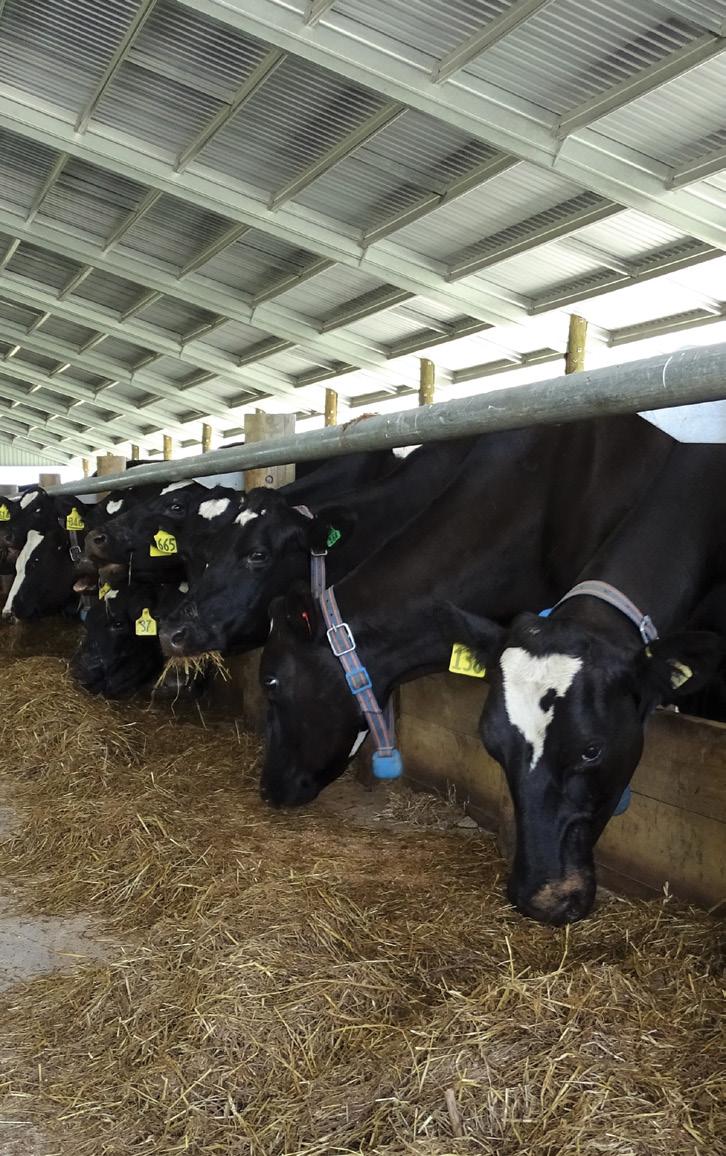
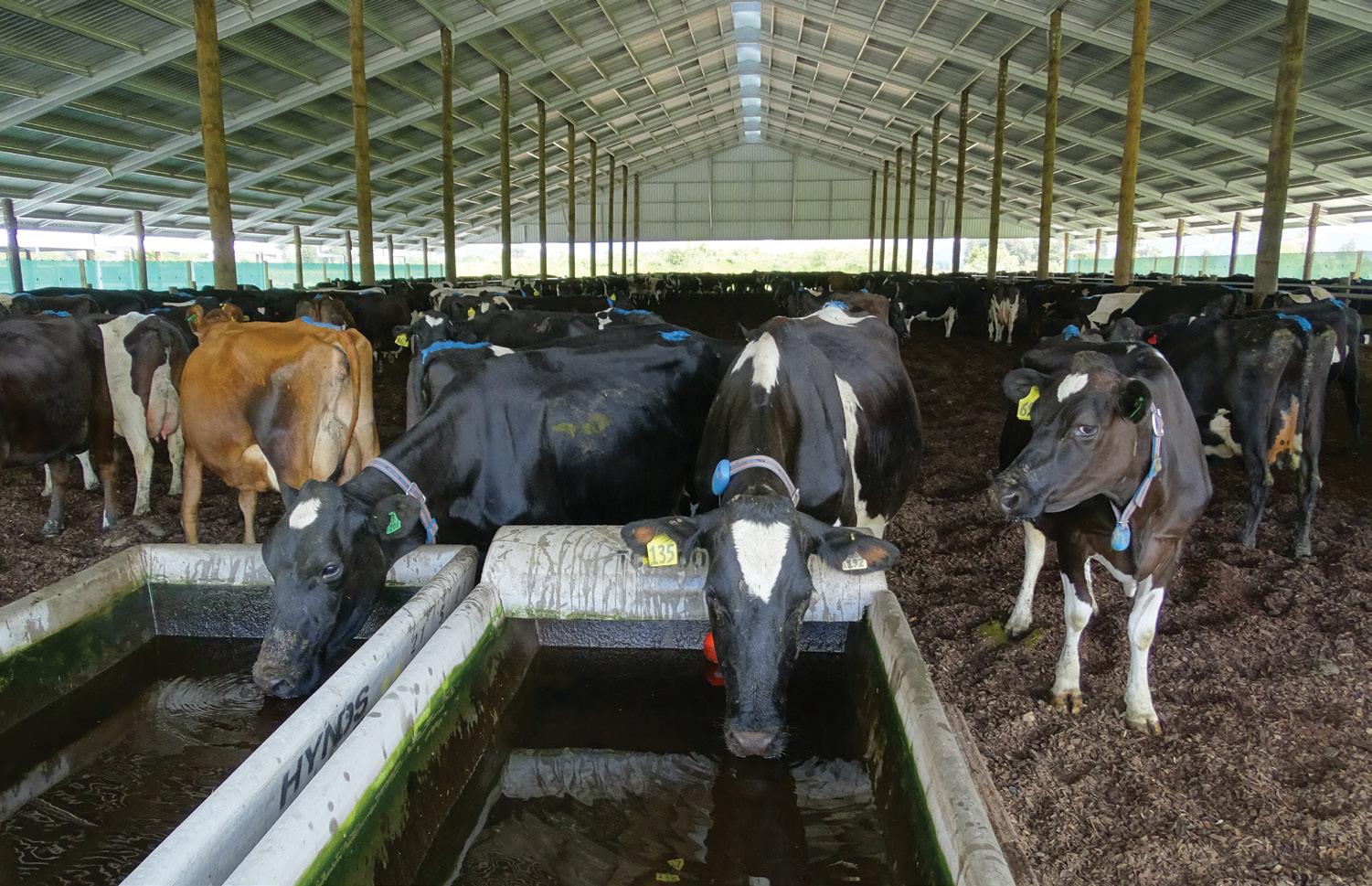
Production: 450kg MS/cow before barns
spoke to in Taranaki has not replaced their compost in seven years. Eventually, the Coates plan to spread the composted bedding over the farm.
Murray and Gaye are keen to point out that the options they have chosen are to suit their own farm and system and other farmers may do their research and choose different options.
Their farm consultant at the time,
George Reveley, challenged them every step of the way to think about how they could create a multi-purpose and flexible space for their farm and weather conditions. He stressed it needed to be safe, practical and pleasant for cows and people.
“He wanted us to think about how a shelter could work in with our existing farming system, rather than change our system to fit a barn,” Gaye says.
That meant thinking about how the space could and would be used at different times, like mating and calving. Also, the strengths, weaknesses, opportunities and threats of various shelter options for seasonal and climatic variances.
“For us, composting barns seemed to be weighted more to the strengths and opportunities presented by our existing farming system within the context of our climate and environment.”
Work on their barns continued through to spring and they now have the gables in place and mesh on the sides to stop rain driving inside. The eight water troughs are inside the barns, so cows do not walk out into rain for a drink and bring that moisture back on to the compost.
The feed lanes are inside which is more expensive, but again it means less water coming into the sheds and the dry feed is more palatable, resulting in less wastage. They polished the concrete after viewing a shed where the cows had ulcers on their tongues from rougher concrete and consequently were not eating their feed well.
The basis for the compost is $150,000 of woodchips that gobbles up dung, while ideally the heat of the compost evaporates the urine. Ninety percent of the 805-cow herd calved in the barns and the placentas just disappeared into the compost, even before it was tilled.
A Rata subsoiler has been converted to do that job. Wings have been added to the points to help turn the compost over. When the cows were housed fulltime through winter, the compost was tilled every day, aerating and mixing the compost to a depth of about 500mm. Murray says the frame of the machine holds it back from tilling even deeper and it ends up levelling the surface. Further adaptions may be necessary to achieve a greater depth. When the cows are not in
the shed, they till the compost twice a week.
As well as tilling, they use a crumbler behind a chisel plough to break up any clods in the compost. Initially they tried the chisel plough for tilling, but it did not get deep enough into the wood chips. The goal is to get everything on to one machine, but that is a work in progress.
In other adaptations, the tyre pusher that pushes feed up for the cows and keeps the area clean, now has two spinning tyres which works more effectively.
Among the unexpected costs, a telehandler is now used to load the BvL feed mixer wagon to make it safer lifting feed to the height of the wagon. They add round bales of balage or silage into the mixer, a bit of straw and can add palm kernel if needed.
Through winter they fed out the equivalent of 9kg/cow/day in the barns, though they fed them every second day, which meant 18kg per cow for two days.
“It’s a bit like Christmas and then you have the pickings on Boxing Day,” Murray says.
Another extra was an older second-hand tractor to replace the tractor now dedicated to the mixing wagon. They may need to build another shed at some stage to cover woodchip waiting to be used. Woodchip has to be dry from the beginning and the
West Coast climate is a risk for a large pile of dry woodchip.
The extras have added costs to the barns, but the barns have already delivered improved returns. For the first time, Murray and Gaye milked cows to the last tanker pick up on June 13 because they had the cows in the barns and did not have to worry about pasture or winter crops. That gave them another 8000kg milksolids (MS) which was “pretty valuable” to them. Their goal is to milk through to mid-June each year which will lift their production beyond the 450kg MS per cow they have been achieving.
On the cost side, the actual barns cost in round figures $900,000 each. Adding on the concrete feed areas and more concrete leading into the barns, plus machinery and woodchip, the total spend was about $3250 per cow. Murray says they were fortunate to have a set price from the beginning as building materials and associated costs have risen exponentially over the building period.
They had to change banks to get the project over the line and found Westpac very supportive of the project.
Financially, the barns stacked up against the status quo and the winter crops of swede were becoming a difficult option with environmental regulations.
The composting barns are a massive
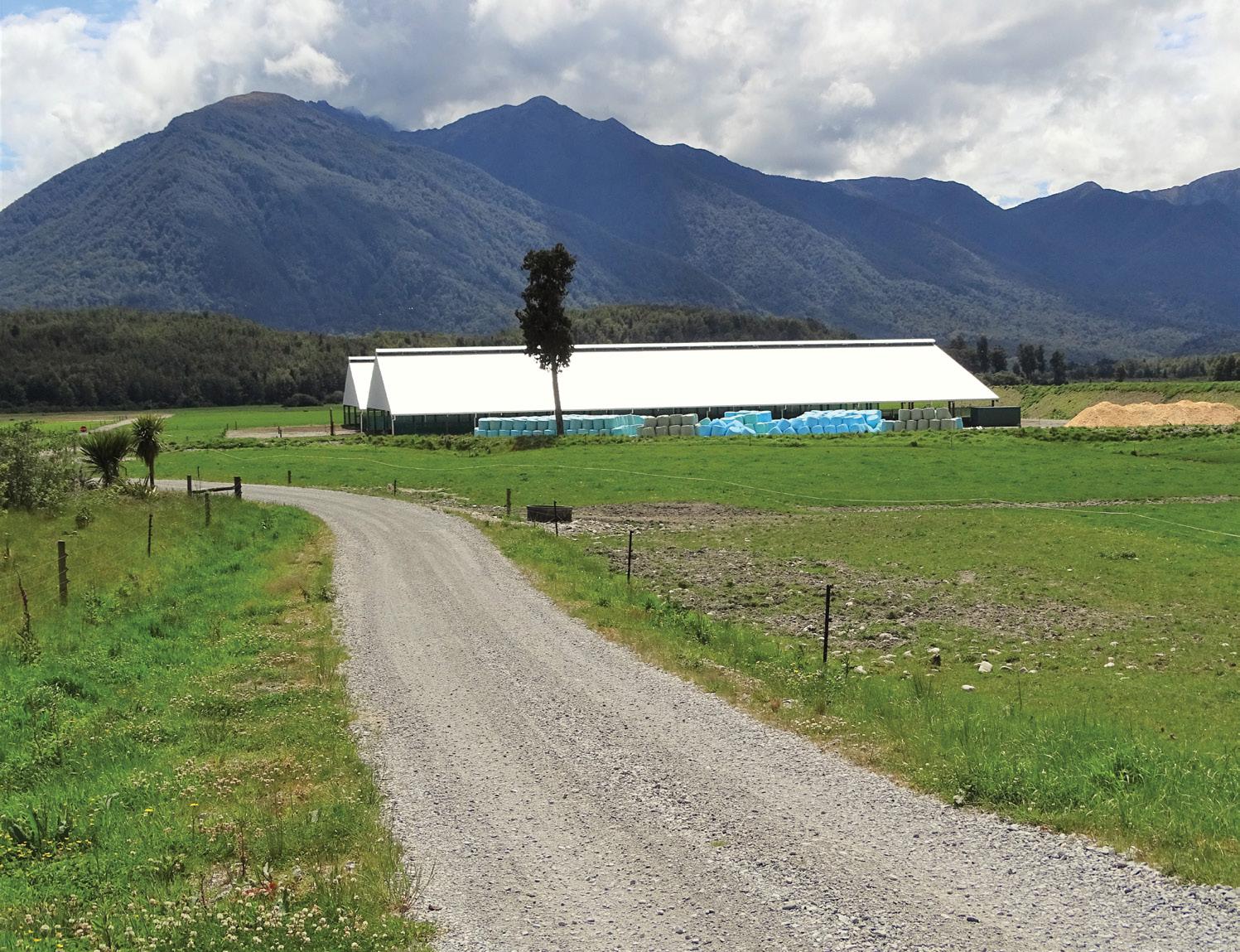
learning curve because it is not just about compost and feeding the cows differently –there is also the effect that has on pasture management. Murray and Gaye say it will probably take a few years to work out the right residuals when they dry the cows off.
By June 13 this year, they had more than 2000kg DM/ha of cover which was too high and Murray says quality was not great. To deal with that, they kept beef stock longer than they intended. The cows calved in the barns so that again altered pasture covers at the beginning of the season.
In future, he says a residual of 1800 to 1900 may be the target going into winter and it will take time and a variation of seasons to work out how to manage their pasture on the shoulders. That will affect other aspects such as calving too.
Next winter, they will buy two-year-old steers in winter for pasture management, run them behind the cows as a topping tool and sell them to the works before Christmas. Murray describes it as “hoof and tooth” which is cheaper than diesel. They already keep beef calves including about 80 Friesian-type bulls and 40 Hereford-cross bulls which they sell weaned at 100kg.
They have used short-gestation Hereford straws in the past, but found the calves too small for animals that were being grown
for meat. Now they use Hereford bulls to go over the last of the cows at mating.
For the cows, the focus will be feeding them well through autumn to meet residual targets. Lighter cows will head into the sheds as soon as they are dried off and the bulk of the herd heading in on June 13 for winter.
The cows calve from August 1 and through the season they will get topped up with feed in the barns if their paddock does not supply their quota. Murray says they are still grass harvesters and will be using grass supplements for the bulk of feed in the barns. They will be making between 2500 and 3000 round bales of balage or silage equivalent.
From calving, the herd will be milked twice a day which will drop to 3in2 as soon as artificial insemination (AI) finishes. This will be the fifth season they have used that milking regime and it has worked well.
The valley reaches temperatures in the 30s during summer and Murray says the cows used to sometimes be panting in the yard. They were also getting high empty rates, so they changed their milking times. Through 3in2 they milk 4am and 5.30pm one day and then 10.30am the next day.
This season, the cows will head to the barn when the heat cranks up. Murray says they will begin monitoring the heat and
identify a trigger point to bring them out of the heat. It may be 25C, or it may be less.
Once inside, the cows can carry on eating in the cool of the barn.
AfiCollars on the cows monitor heat stress, as well as ruminations and head movement which will help determine the right time to head to the barns. They connect with the Afi Herd Management System in the dairy which determines how much feed is given to each cow at milking. A mix of meal, wheat, molasses and mineral pellets is fed to each cow according to the information from the collars.
It is all part of Murray and Gaye’s strategy to weigh, measure and calculate everything on the farm. Their latest tractor has self-steering and combined with GPS on the spreader, enables them to apply everything accurately in their goal to be precision farmers.
The composting barns are part of that strategy. They know what the cows are eating and can minimise wastage. At this stage they can only estimate how much nitrogen the compost captures.
Down the track, Murray and Gaye say it is quite possible that research may come up with a means of using the barn to monitor, manipulate and/or minimise methane.
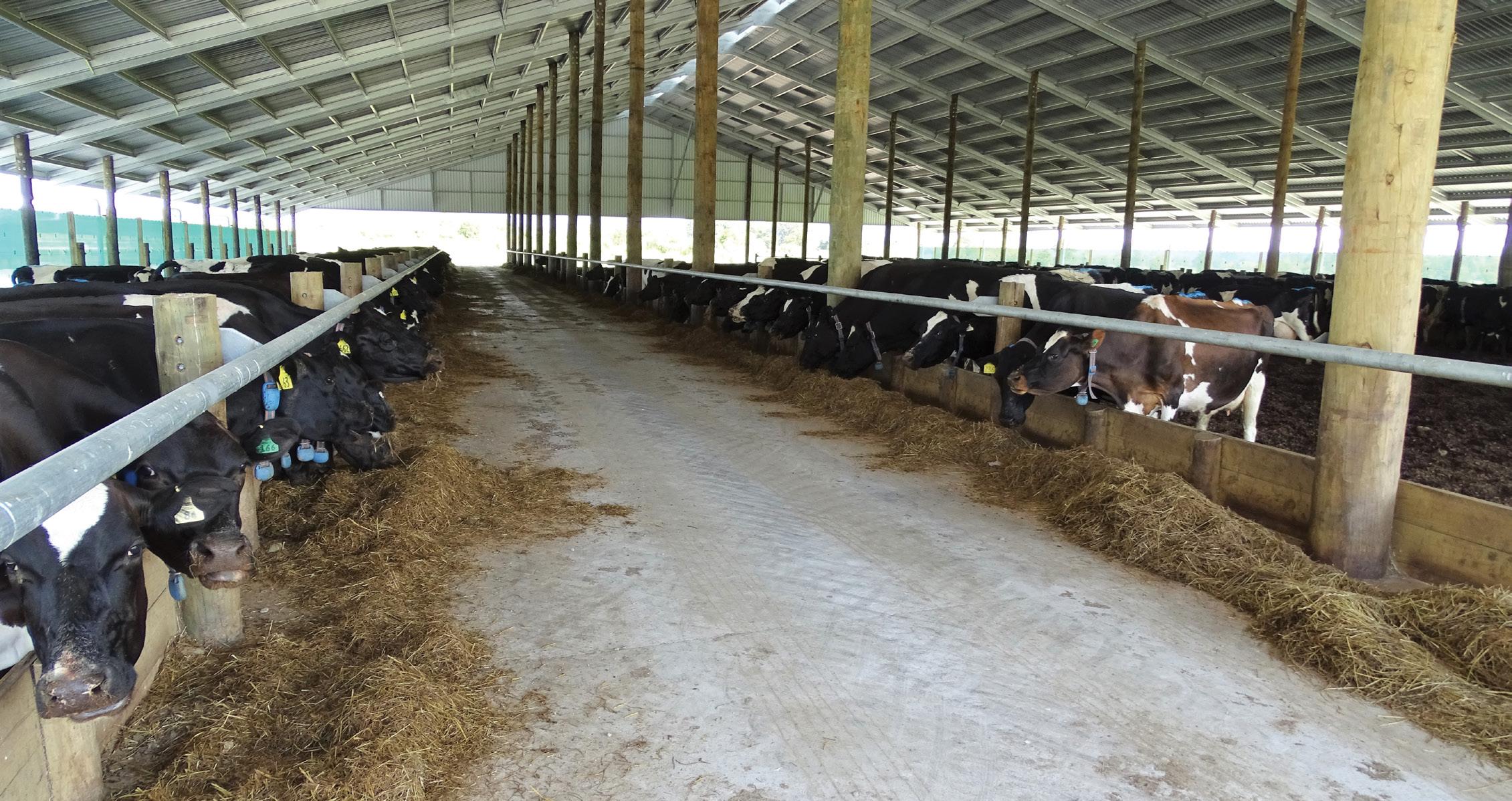
Farming livestock in the shade of solar panel arrays is taking off overseas and offers opportunities in New Zealand.
By Delwyn Dickey.With more solar arrays being deployed in farming areas and more likely in the future, two research projects are looking at different aspects of incorporating the arrays into a working farm.
Solar grazing, where sheep are run under the photovoltaic panels is common overseas, although not universal, with sheep farmers in the United States and Canada having their own solar grazing associations. The sheep are generally run as a separate operation to what is happening on surrounding farmland.
Farm consultant Anna Vaughan with Tambo NZ wondered why the arrays weren’t being used as part of the farming operation instead of as a stand-alone venture.

“Solar panels going on farms seemed to be an either/or situation rather than ‘how could this work for the livestock farms’,” she says.
With decreasing stock numbers to meet greenhouse gas emissions regulations likely, finding ways to increase on-farm revenue is also going to become more of a focus for farmers, Anna says.
To find out how the arrays would stack up financially for a farming operation she contacted Alan Brent - chair in sustainable energy systems at Victoria University of Wellington and along with scientists at Lincoln University, and they applied for funding through the Rural
Professional Fund with Our land and Water National Science Challenge.
Alan reckons he is “stoked” to be involved with the study as he sees agrivoltaics as an important opportunity for New Zealand.
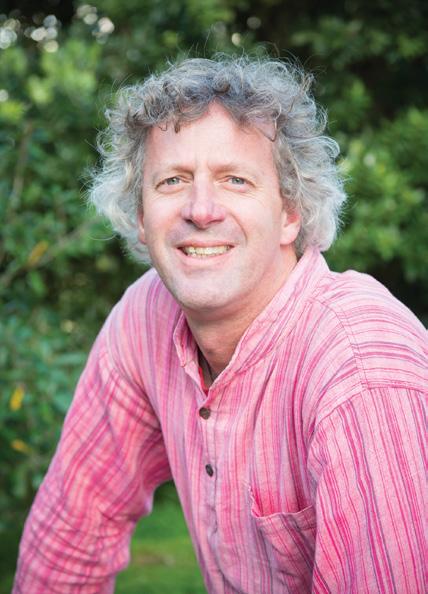
The desktop study will look at both a dairy farm and a sheep farm, in Canterbury, as case studies. http://wgtn.ac.nz/sustainable-energysystems
There will likely be animal welfare gains for livestock as the panels offer good shade, especially for lactating dairy cows, Anna says, with issues around heat stress in stock likely to become more important as the climate continues to warm.
“The aim is to develop a business case for a system on the farm – how much would it cost and what would it look like,” Alan says. “But the project will also be looking at the productivity of the farming itself,” he says.
There are a myriad of things to be considered as far as economics go with the farm being close to a connection point to the national grid probably the key one.
They will be working on the assumption the installation, operation and maintenance of the array would be done by an outside third party rather than by the farmer. High onfarm power use with running dairies and irrigation systems like pivots tends to see dairying operations more likely to benefit from an onfarm solar array, Anna says, although consideration would need to be given to whether you could use pivot irrigators or k-lines with them, she says.
With the panels needing to be raised further
off the ground than is needed for sheep, this also sees bigger installation costs. Although there are solar operations overseas growing crops beneath the panels only a few places have looked into running cattle under an array.
One is a prototype installed at the Farrer Memorial Agricultural High School in Tamworth, New South Wales, which is used to power irrigation at the school.
The 60kW array has panels set at 2.4 metres off the ground with Angus bull yearlings and Illawarra dairy heifers and adult cattle regularly running under them. Ben Wyn owns Wynergy the solar installation company specialising in agrivoltaics in Tamworth that installed the array.
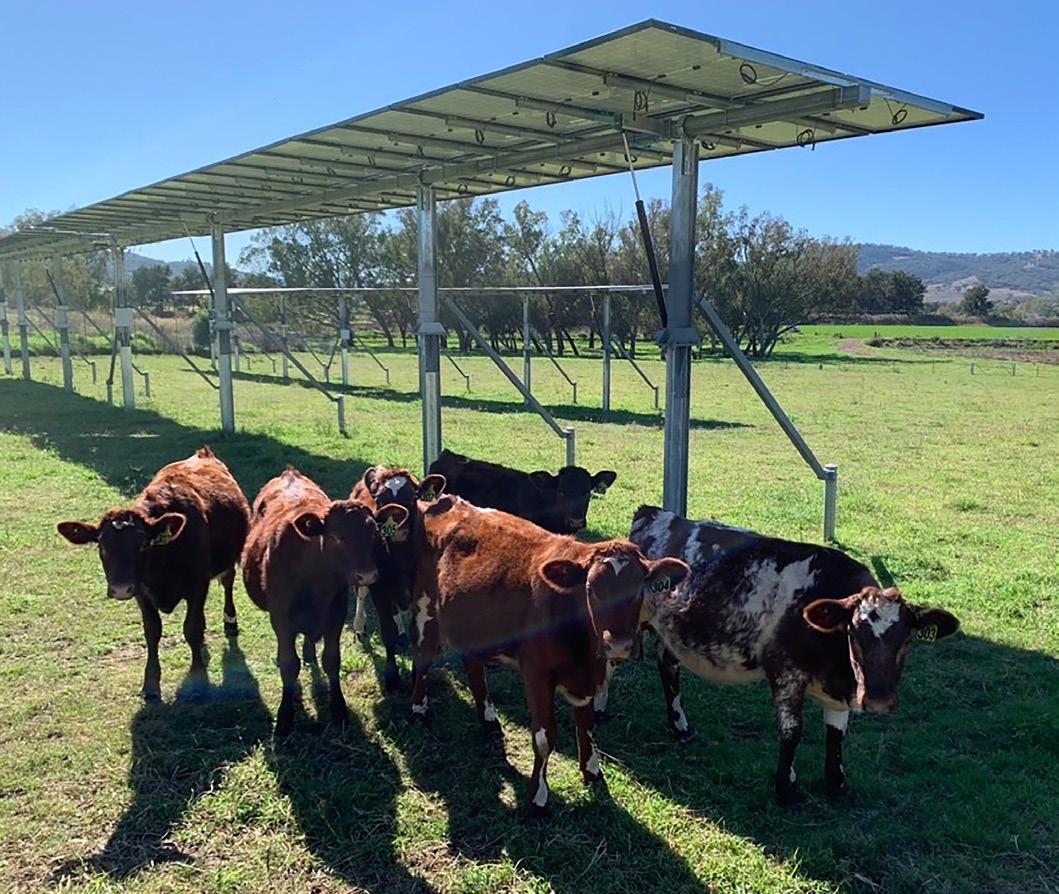
The array is performing well with no issues cropping up from the cattle. The 15-month-old bulls particularly love to scratch on it and give it a real workout, he says.
Despite this the company hasn’t sold or completed any other cattle arrays since this one went in in 2021.
The high cost of installation - an extra 80% compared to one suitable for sheep, may be behind this, he reckons, although with plenty of land and roof space available locally Ben says there seems to be little call for the design.
Higher costs come from the use of more robust materials to withstand the higher winds found at height, the heavier animals rubbing against them, and added construction costs at height.
For his part Ben reckons a smaller 5MW cattle array wouldn’t be economical if it was simply grid connected and earning a low power purchase agreement (PPA) rate.
The effects the panels have on the pasture around and underneath them is behind another year-long project on an existing solar farm in Taranaki.
Aimed at sheep grazing, the research will look at the effects of shade on the pasture to get an idea of carrying capacity under and around arrays.
“Many of the solar farms overseas are installed in areas that have quite dry, arid conditions with very low stocking rates,” Professor Paul Kenyon says. Paul along with Professor Danny Donaghy from Massey’s School of Agriculture and Environment is leading the research, with funding from the Agricultural and Marketing Research and Development Trust (AGMARDT).
As pasture production in NZ is quite different we need to know how much pasture you’ll still grow in any given hectare, which will set stocking rate or carrying capacity, he says.
There is potential for more diverse species to be used around the panels but for this trial, with the Taranaki array set up on standard ryegrass and clover pasture, this is what will be trialled.
“Because of the potential shading from the panels, the composition of the sward is likely to change to potentially less-palatable weed species, which will affect the carrying capacity.
Taking measurements for an entire year will show how the amount of shading and light each area of land receives differs each day and across seasons giving a total picture of pasture production and therefore animal carrying capacity.
In warm environments the shading, which could see warm and moist conditions develop, could potentially lead to increases of facial eczema, he says.
With dairy sheep also showing potential as a lower environmental impact option to dairy cows Paul sees no reason why a dairy flock couldn’t be run under the panels, offering another revenue stream option.
Like Alan Brent, Paul sees a bright future for agrivoltaics in NZ.
“There is a lot of interest in this. Like any new system it’ll just take time to understand how to better manage that system.”
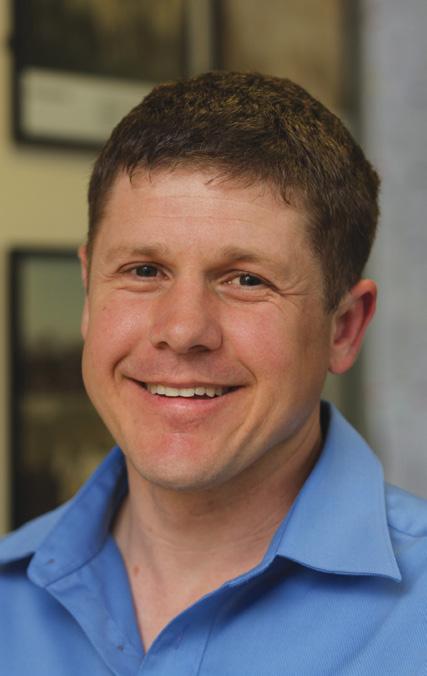
‘THE AIM IS TO DEVELOP A BUSINESS CASE FOR A SYSTEM ON THE FARM – HOW MUCH WOULD IT COST AND WHAT WOULD IT LOOK LIKE.’
Australian research to develop biopolymer devices inserted in the stomach of cattle to deliver a continuous low dose of a gasreducing bioactive could prove useful for New Zealand farmers, AgResearch’s science objective champion for climate change adaptation and mitigation, Dr David Pacheco says.
The University of Queensland and Department of Agriculture and Fisheries (DAF) collaborative project is funded by Meat & Livestock Australia (MLA) and the MLA Donor Company Limited, to help producers meet the target to make the meat industry carbon neutral by 2030. It is hoped the $7.5-million project will substantially reduce methane emissions from cows.
Research lead Professor Mary Fletcher from the Queensland Alliance for Agriculture and Food Innovation (QAAFI) says the aim of the research is to develop biopolymer devices that can be inserted in the stomach of cattle to deliver a continuous low dose of a bioactive.
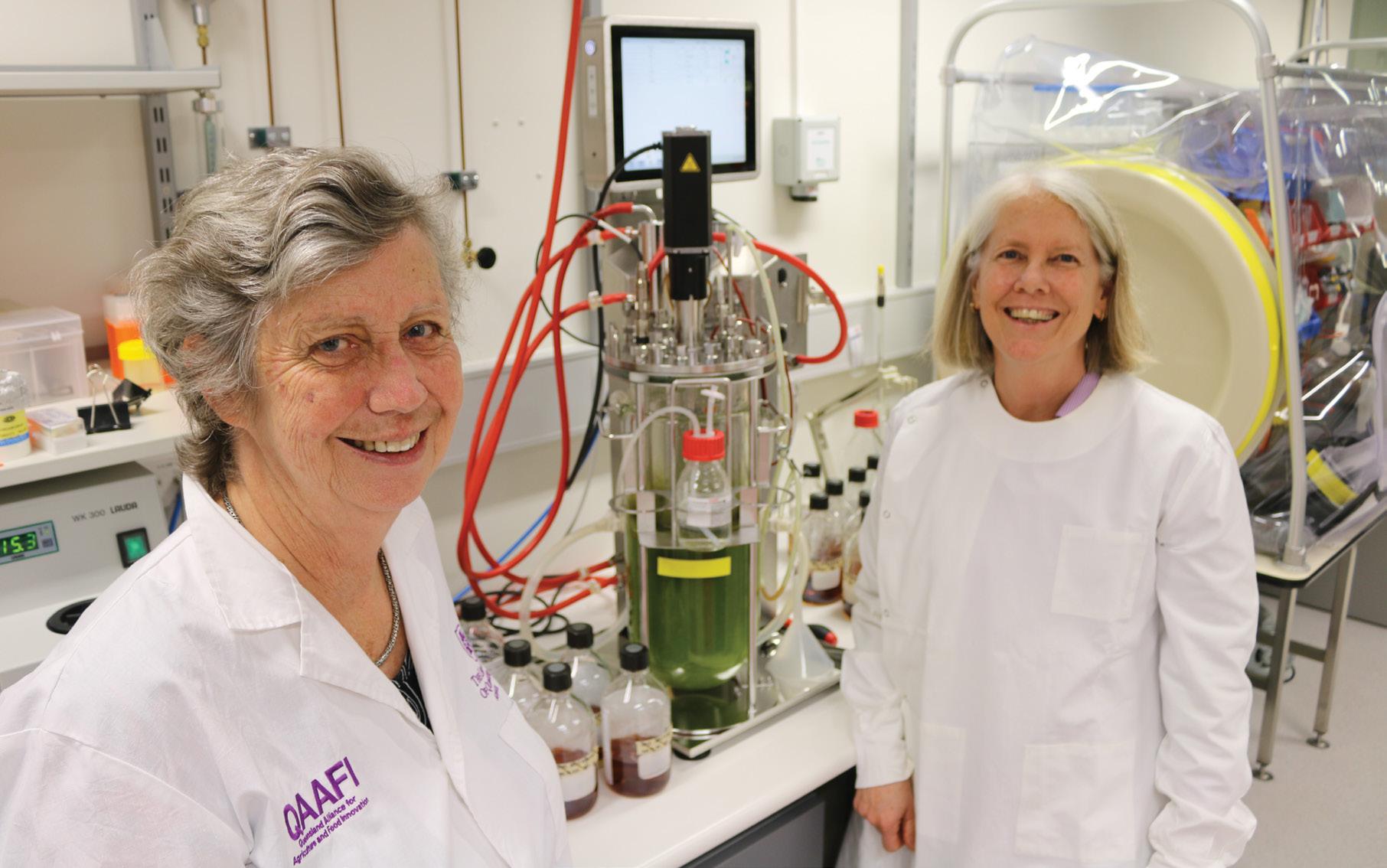
While AgResearch in NZ is not researching biopolymers for delivery of methane inhibitors Pacheco says: “Slowrelease technology is interesting and could
Elaine Fisher reports on an Australian project aimed at substantially reducing cows’ methane emissions.
help expand our options for delivering methane inhibitors, developed in New Zealand and elsewhere, in our grazing systems.
“As part of our research on compounds that could be fed to livestock to reduce methane emissions, we know that technologies for extended delivery of the compound in the animal’s rumen will be useful in Aotearoa’s grazing systems.
“In contrast with indoor feedlot systems where animals can receive additives via their feed throughout the day, in grazing systems the opportunities to offer supplements containing inhibitors are limited.”
Fletcher says researchers want to develop the technology to fit in with the normal management strategies of northern cattle producers. The research team will engage with cattle producers at every stage of the process and is looking for people to be involved to ensure a practical solution for the industry.
“We want to find a solution that doesn’t create a major impost in these extensive pastures where daily dosing is simply not practical.
“We’re hoping that the producers can make it part of their six monthly or annual
programme, so when they bring the animals in for weighing and assessment treatments that this just forms part of the normal cycle.
“The treatment could be administered in the yard before the cattle are returned to pasture without greatly adding to the labour involved.”
The key to the project is the slow-release biopolymer technology, developed in the University of Queensland’s School of Chemical Engineering in a team led by Professor Bronwyn Laycock.
The biopolymer holding the bioactive is used to make a rumen insert — a cylindershaped object the length of a human hand. Cattle will be able to swallow the rumen insert which will then sit within their stomach where it will be degraded by bacteria over time, releasing the bioactive and leaving no residue.
Mary says biopolymers are already used in human medicine for implantable drug delivery systems. “The rumen of an animal is a completely different environment, but we’ve proven that the biopolymers can stand up to bacterial activity for a number of months.”
Before a trial is conducted in cattle, Department of Agriculture and Fisheries
researcher Diane Ouwerkerk will use a laboratory fermenter to mimic the conditions in a cow’s rumen to test the rate at which the biopolymer cylinders will degrade and release bioactive.
Australian Minister for Agricultural Industry Development and Fisheries and Minister for Rural Communities Mark Furner says the biotechnology could be a game-changer for the beef cattle industry.
“In extensive grazing systems, supplements are normally delivered through licks, with little or no control of intake by individual animals.
“The ability to ensure each animal receives a sustained dose of a methanereducing active agent over an extended timeframe would be a fantastic win for the beef cattle industry, helping it achieve its goal to reduce methane emissions –particularly in cattle grazing extensive pastures.
“If successful, this biopolymer biotechnology could be used to administer other types of treatments to cattle.”
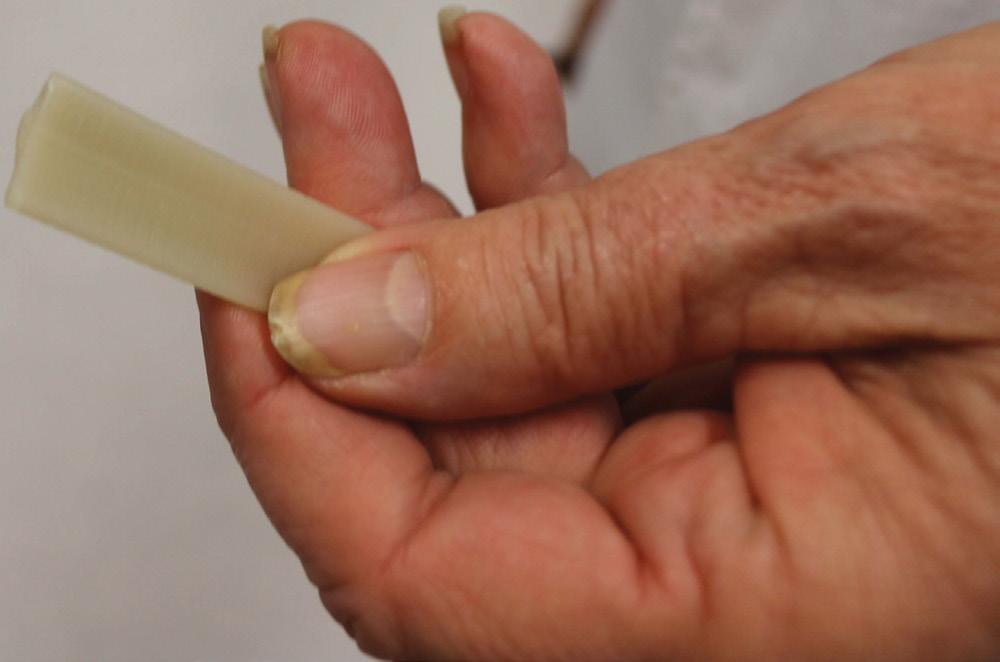
MLA managing director Jason Strong
says the red meat sector in Australia has made tremendous strides towards emission reductions.
“MLA will continue to invest in new technologies and techniques to achieve carbon neutrality by the end of the decade, without compromising livestock numbers.
“The CN30 strategy works hand-in-hand with industry’s vision to double the value of red meat sales as a trusted source of the highest quality protein in the next 10 years.”
Mark Aspin, senior adviser NZGHG and environment research says we are tackling the same challenge with the NZ Inhibitor Development Programme.
“An additive’s ability to reduce methane emissions relies on its potency and how long it is active in the rumen,” Aspin says.
“For maximum effect, it needs to be in the rumen at all times – which is what happens in Total Mixed Ration (TMR) and so blocks the formation of methane by methanogens. “
Methane production follows the animal
feeding - it goes up after they have eaten and falls away as they digest the grass and using the inhibitor as a feed additive will have a narrow opportunity within Kiwi farm systems unless we can make the active inhibitor last several hours in the rumen.
“We have been exploring intraruminal delivery using capsules or bolus and have several inhibitor classes being developed with delivery to grass fed systems the focus.”
Salmonellosis is over 2.5 times more prevalent than in 20131



Salmonella is widespread on New Zealand dairy farms and cases have increased nationwide1
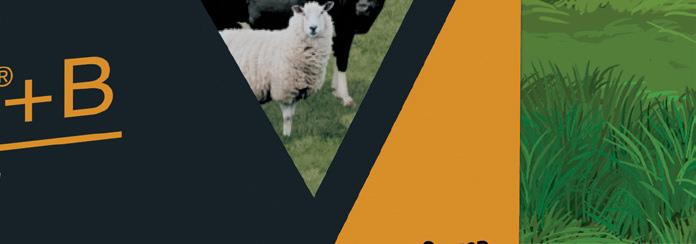
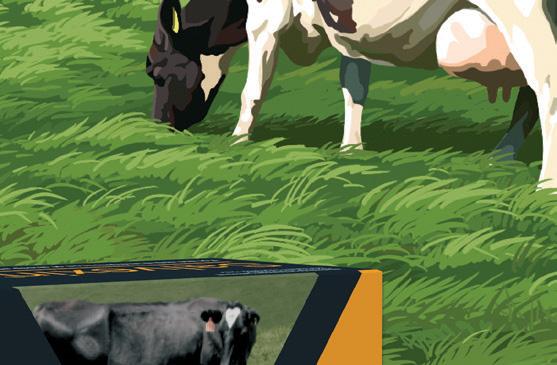
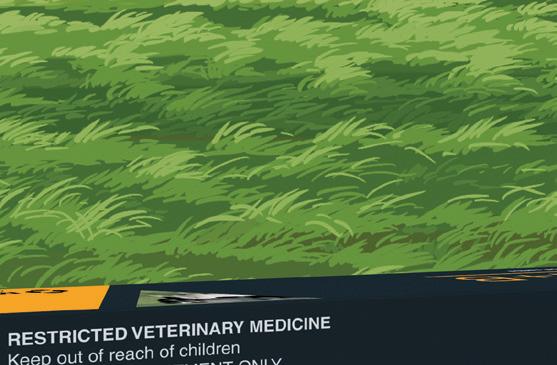

Striking without warning and spreading quickly, Salmonella can pass from your stock to the ones you care about most.


Vaccinate today to reduce the destructive impact of an outbreak*.


By the end of this season dairy farmers in the Selwyn Waihora water zone must show they have cut their nitrogen leaching losses by 30% compared with the annual average loss between 2009-2013, their baseline period.
For Tom and Sara Irving that means their nitrogen loss to water as measured by Overseer must be below 50kg N/hectare on average across their 124 effective ha home block and a 52 effective ha lease block which is part of the milking platform.
They’ve well and truly achieved that drop with their average number coming in at 28kg N/ha.
It’s taken investment in irrigation infrastructure, a slight drop in stocking rate, a big backing off in annual nitrogen fertiliser applications, a cut in boughtin supplement and a stronger focus on pasture management.
Milk production is still sitting at close to annual levels over the past six years at 1500kg milksolids (MS)/ha or 450-470kg MS/cow but back about 100kg MS/ha on the earlier, higher input years.
It’s hard to compare profitability between then and now on a status quo basis because so many variables have changed, not least the significant hike in milk price on one hand and the jump in input costs on the other.
What’s clear from DairyNZ analysis though, is that the Irvings are sitting within the desired quartile when it comes to purchased nitrogen surplus, nitrogen use and methane production - each plotted against operating profit. (figure one.)
Tom says that while it’s a relatively comfortable position to be in as far as water quality regulations go, he’s aware there could always be more asked of the farm with new Essential Fresh Water rules still being worked into Canterbury and nationwide regulations.
The region has been working on water quality improvement for more than a decade through its Canterbury Water Management Strategy, zone committees and zone-specific rules that require seriously significant cuts to Overseerestimated nitrogen leaching numbers.
Farm plans, land use consents and the long-signalled reduction requirements have been part of the landscape in the
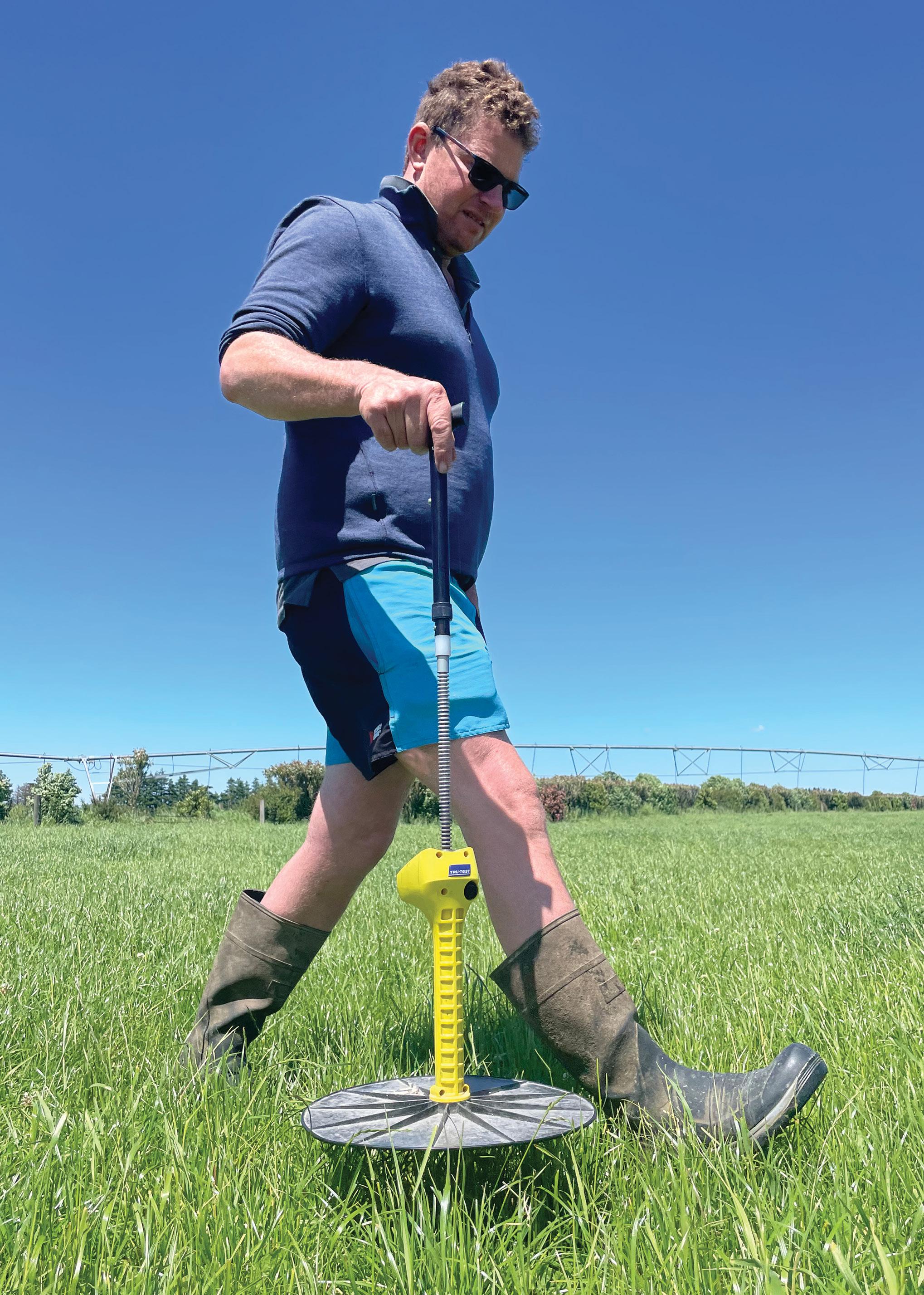
By meeting a range of measures a Cangterbury dairy farming couple have surpassed their nitrogen loss target. By Anne Lee.
region and farmers have been putting actions into place, some incrementally and some making wholesale farm system changes.
For Tom and Sara it’s mostly been a steady march of tweaks and shifts with a couple of significant moves along the way.
“There are still some levers we could pull – like plantain – if we were told we had to make further cuts.
“And the way things are moving that could happen but I’m fairly comfortable because I genuinely think that science and new technologies will take care of us with that.”
Tom and Sara keep their eye on research and development and are confident the efforts scientists are making will see new tools added to the tool box.
Conversion of Westmere began in 2009, the start of the baseline period, and didn’t include the lease block until the 2015/16 season. The addition of the lease land, converted from dryland sheep, has made for slightly more complex requirements in terms of nitrogen loss reduction expectations but the Irvings’ adoption of good and beyond-good management practices have helped them consistently go beyond regulated expectations.
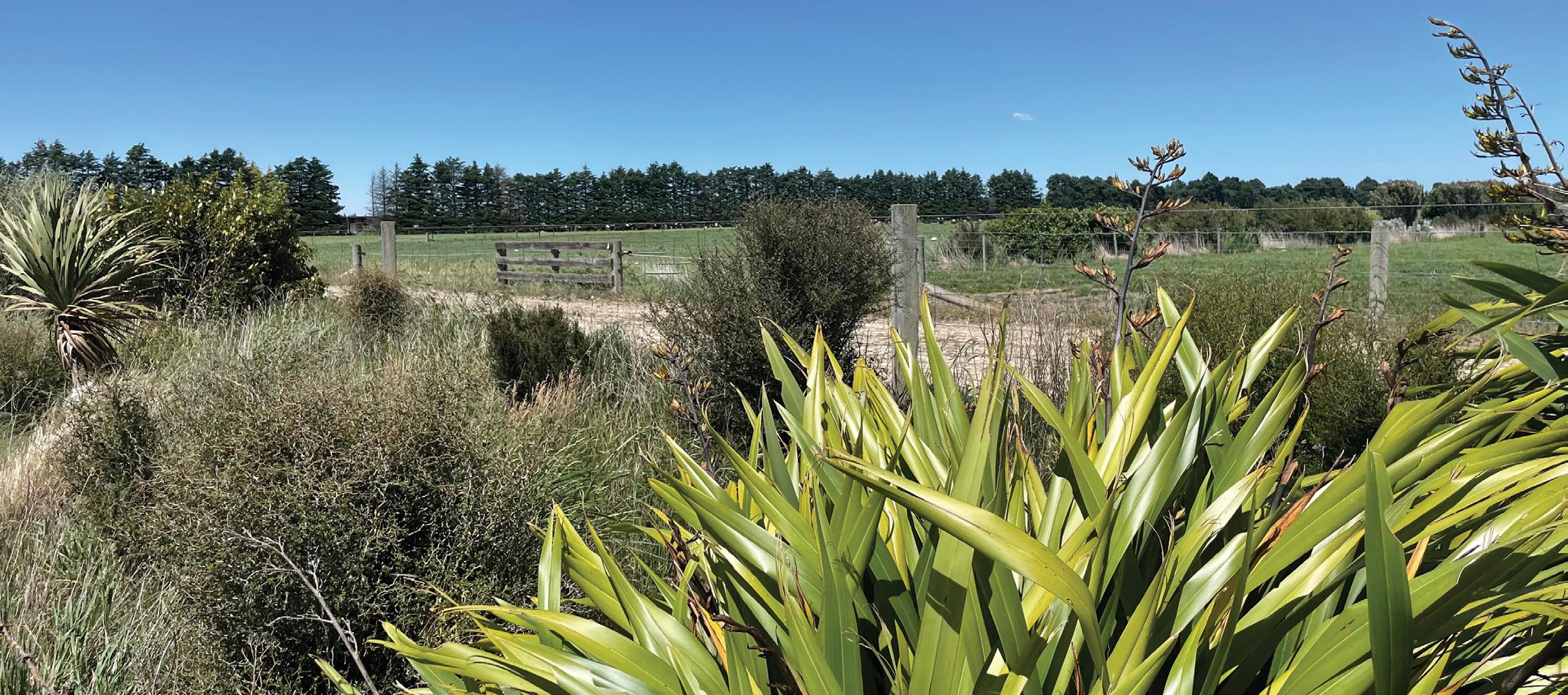
Tom says when the home block was converted the milking platform was irrigated by a centre pivot and a Rotorainer which covered about 70ha.
Water was from a bore but with the advent of Central Plains Water the farm bought shares and switched to taking water from the large-scale scheme that brings water from the Rakaia and Waimakariri Rivers as well as Lake Coleridge, delivering it by gravity as it’s piped down and across the Central Canterbury Plains.
Two smaller pivots were installed to replace the Rotorainer which meant much lower rates of water can be applied over
a more frequent return period. Lower irrigation depths at each watering event mean leaching is less likely. Along with those lower rate applications Tom is also able to apply water based on soil moisture monitoring information.
That means he can actively manage soil moisture to keep it high enough to provide moisture for pasture growth but not too high that they get drainage events - where soil moisture drains beyond the rootzone. That significantly cuts the chances of nitrate leaching further. It’s not a perfect science because it also relies on accurate weather forecasting of coming rain events.
Most years that’s not too much of an issue in the dry Canterbury region but thunderstorms or unexpected localised rainfall can still be possible on occasion.
Tom says in the early years after conversion they ran a higher stocking rate of about 3.6 cows/ha with a big focus on hitting low residuals and round lengths that could get down to 17-18 days during the high growth periods of spring. They bought-in more than a tonne of drymatter (DM) of supplement per cow then and Tom recalls they were
often farming on a bit of a knife edge with pasture supply and demand through the peak growth period finely balanced.
“The cows would be pumping because the grass was like rocket fuel but it only needed a couple of days of colder weather and a small drop in growth rates and things crashed.
“You could be cutting silage one minute and feeding it out along with bought-in feed the next.”
Taking the pressure off a bit, dropping the stocking rate back to 3.3-3.4 cows/ ha helped lower the need for as many bought-in inputs.
The inclusion of Viscount tetraploid ryegrass in the pasture mix during the renewal programme has enabled him to lift pre-grazing covers slightly and lengthen grazing rounds too.
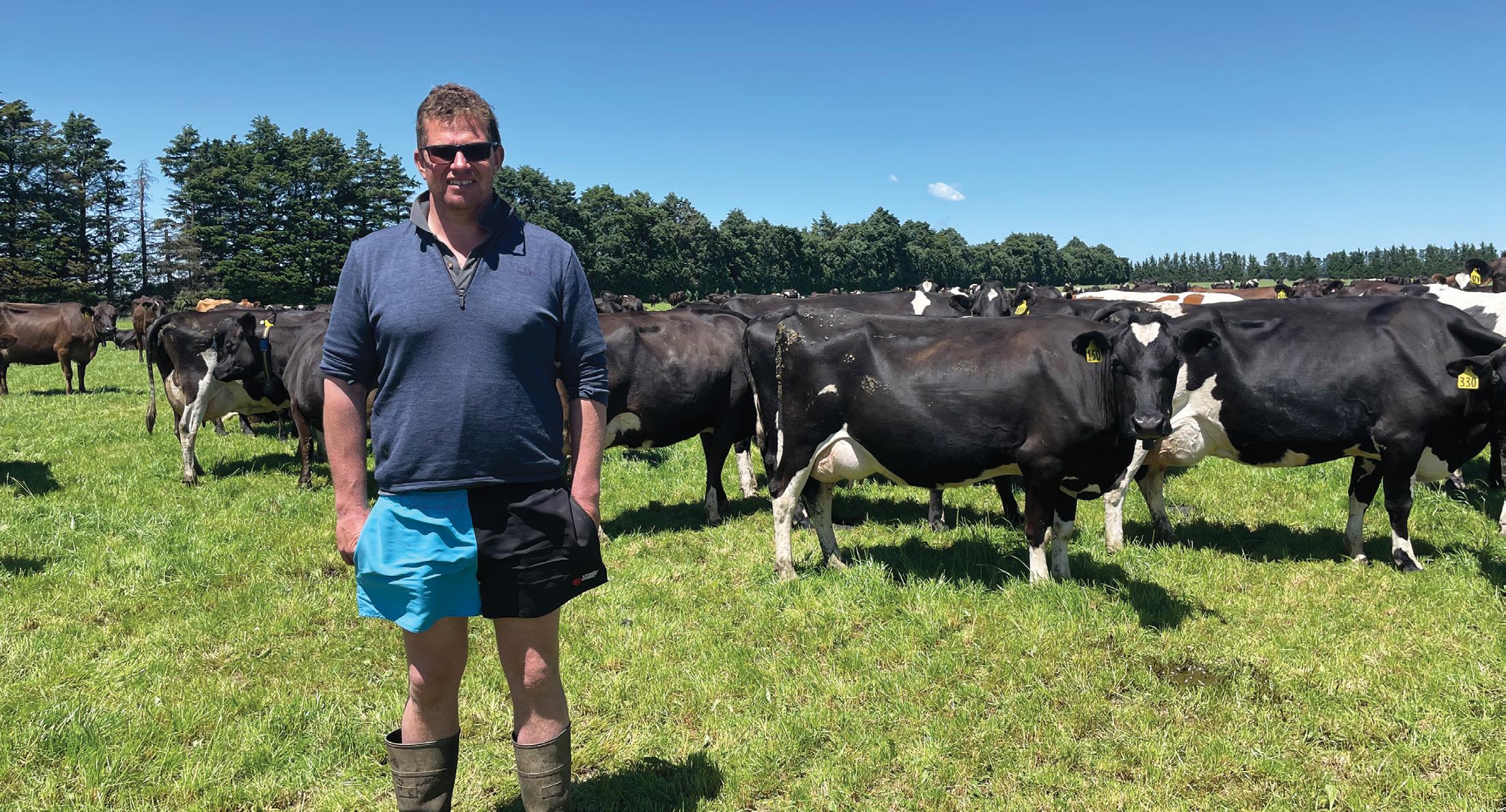
“We were hit with clover root weevil in 2016 and we put on a lot of N to compensate for that.”
Applications got up to 283kg N/ha but as the clover root weevil populations dropped, likely due to the rise in the introduced parasitic wasp, and discussion over nitrogen loss reductions came to the fore, Tom began dropping urea
application rates. In 2019 Tom decided to make a significant drop in urea use.
“We made a big cut in one hit and took out 66kg/ha that year – and yes the farm really felt that.
“Looking back, I would have done it over two seasons not just one because we just didn’t get the growth further into the season and we ended up using more palm kernel to compensate - so it cost us.”
The following season pasture production began to recover, and clover began to increase in the pasture.
Tom says cutting N use has been more about reducing the number of applications than rate per application.
“We went from following the cows every grazing round with an application of urea to putting it on monthly and we’ve cut two to three applications out that way.
“We cut the August application and we never did put it on in May.
“I did try cutting the January application out but that bit us too, so we’ve put that back in.”
Every paddock is below the 190kg N/ha cap and the average for the farm over the whole season is back at 155kg/ha.
He uses N-Protect to limit any losses of N to the atmosphere and the farm team has been “very focused” on good pasture management. They’ve also used gibberellic acid in the form of ProGibb.
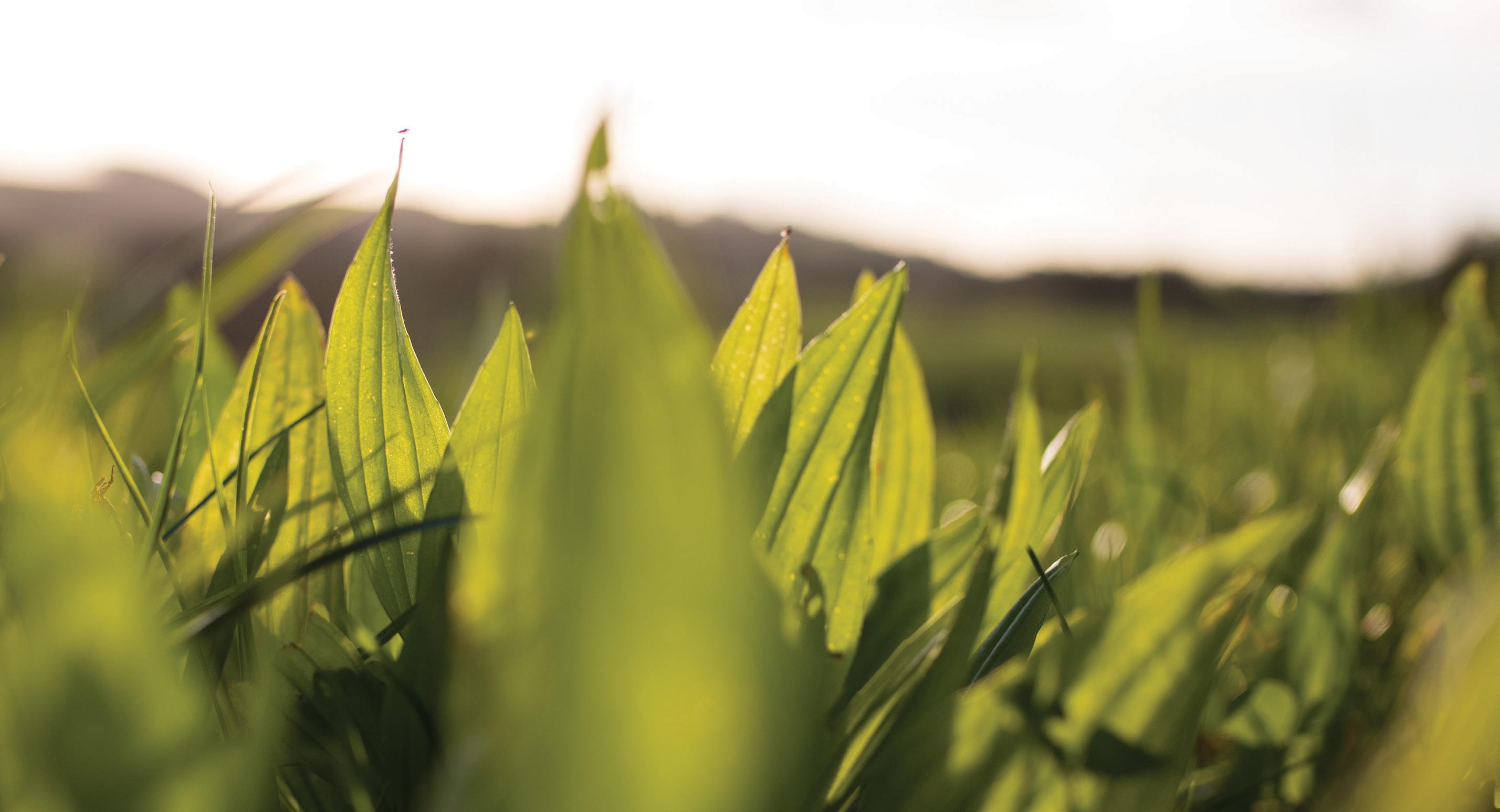
The naturally occurring compound helps elongate cells and promotes growth in the
Tom applies it over spring from midSeptember with about 17kg N/ha and says he definitely sees a pasture growth boost three weeks post application that has helped him over the poor springs of the last two seasons.
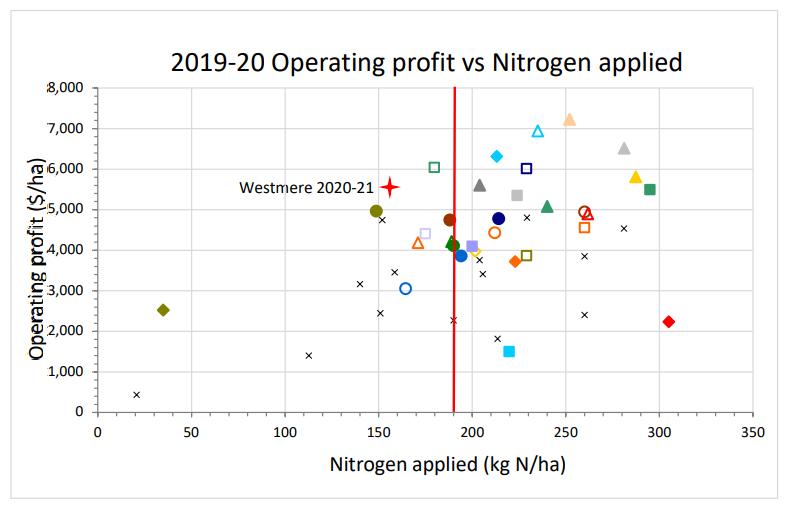
Last season they invested in Allflex collars and are totally depending on them for identifying cows for mating.
The farm has always had a high six-week in-calf rate and low empty rate compared with regional performance.
“I’m very happy with how things are tracking – the return rate is putting us on track to get the in-calf rates we expect.”
Agronomically proven. Environmentally proven. Reduce N with the proven plantain.
IT’S OFFICIAL. ECOTAIN ® . CLASSED EFFECTIVE BY THE DAIRYNZ PLANTAIN CULTIVAR EVALUATION SYSTEM.
This year they’ve gone to all artificial insemination thanks to the collars and their Protrack auto-drafting.
They’ve used short gestation length bulls in week four and Tom is expecting an even tighter calving next season.

They use the spring rotation planner to manage pasture through calving to balance date and get down to about 22 days round length.
Growing and utilising pasture is a top priority.
“The last two seasons have been really tough ones for growth but we’re still hitting that 14 plus tonnes drymatter harvested/ha.
“Hopefully we’ll do it again this year, but it’s been a really slow-growth spring and then all of a sudden a bit of rain and heat and the grass around the district pretty much ran to seed all at the same time.
“In retrospect though, when we look back at those high N use years, we were probably wasting nitrogen and wasting some feed too.”
The sudden cut exposed “the addiction” both for him and the pasture.
“We got into a system and way of thinking that meant it was just part of the programme and I think the pasture was used to it too.
“Clover is coming back now and we’ve adjusted the fertiliser programme to support it with a bit more potassium and trace elements.
“It’s definitely possible to get nitrogen losses down but you need to use a number of levers.
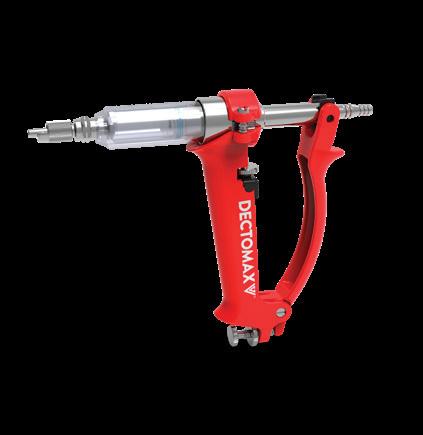

In a lot of cases those levers can have a win:win outcome – such as a shift to more precise spray irrigation giving the ability to grow more grass.
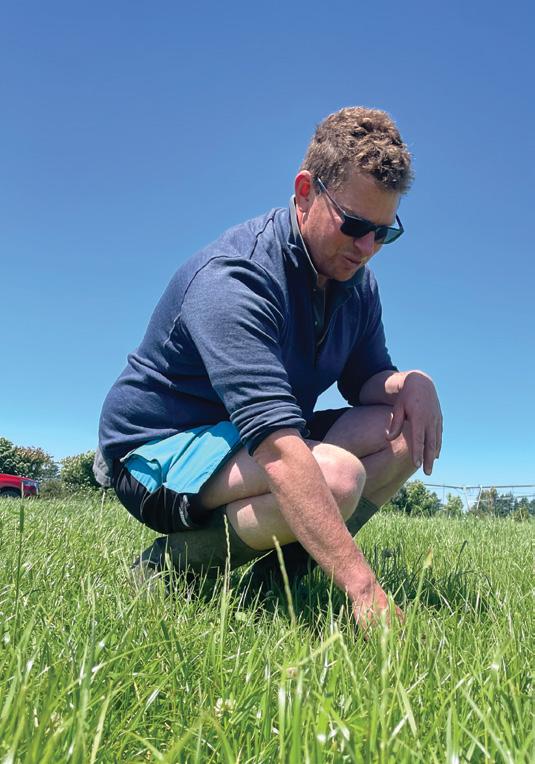
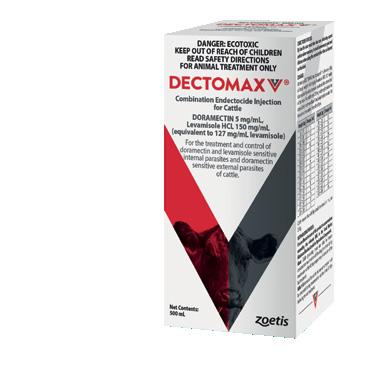
There’s also a greenhouse gas benefit to limiting nitrogen applications, balancing stocking rate and lowering feed inputs – both from a nitrous oxide and methane emissions perspective.
“We’ll keep looking to science for the answers – it has to be proven and it can’t come at a big cost to profitability.”
remains in a form that is less likely to be leached for longer.
“It (the effect) isn’t lasting for a long time, but it is lasting for about a month and that’s quite a long time for a plant to be able to take up that nitrogen.”
Bioactive compounds in plantain appear to be acting like natural nitrification inhibitors scientists are finding.
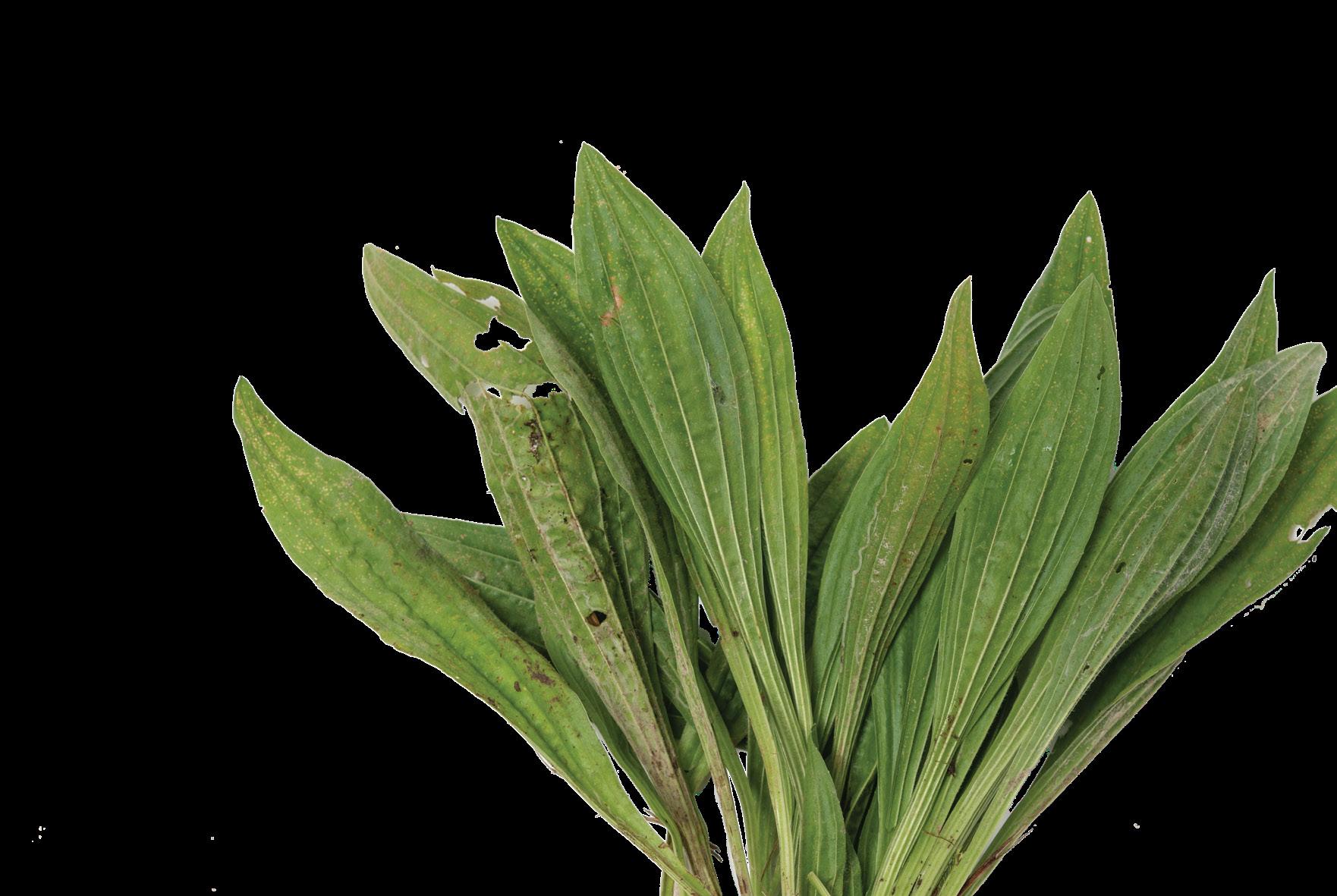
At a recent Lincoln University Dairy Farm (LUDF) focus day, Dr Trish Fraser from Plant and Food Research told farmers scientists have been looking at what’s happening in the soil when animals are grazing plantain.
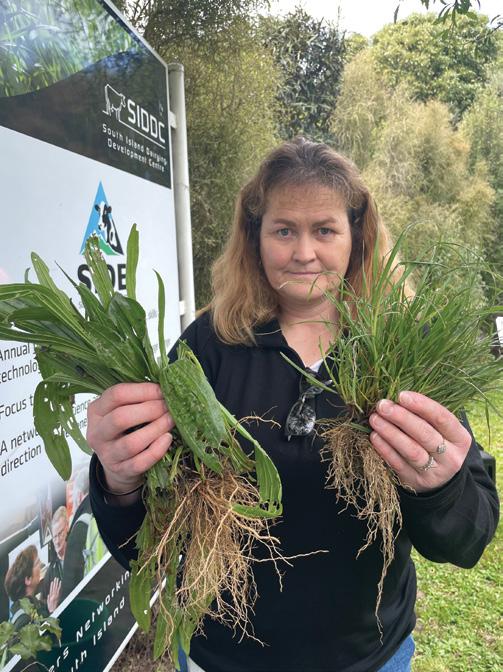
The work is part of the larger plantain potency and practice study being funded by the Ministry of Primary Industries, DairyNZ, Fonterra and PGG Wrightson Seeds.
It appears both the plant itself and the urine of animals fed plantain are helping to slow the nitrification process where ammonium is converted to more readily leached nitrate.
Trish says scientists have looked at the urine of sheep fed plantain or ryegrass. They’ve been able to identify more than 2000 compounds, but they’ve found 75 that are unique to, or are present in much higher concentrations, in the urine of the sheep fed plantain.
Laboratory experiments have been carried out using the urine from sheep fed plantain to compare its effects on nitrate production over time in the soil with urine from sheep fed ryegrass and with the application of urea as well as the natural nitrogen mineralisation in the soil.
The amount of nitrogen present in each treatment was the same, to allow the rate of nitrate production to be accurately compared.
Trish says nitrate production where urea was applied was similar over a six-week period to the rate where grass-fed urine was applied.
But in the soil where the urine from sheep fed plantain was applied, the rate of nitrate production was much slower.
By the end of the six-week period the total amount produced was similar but slightly lower.
She says the slower rate means more nitrogen
The first step after urea is applied - either as fertiliser urea or urea in animal urine – is the conversion of urea to ammonium.
That happens fairly rapidly but that’s okay because the ammonium isn’t readily leached and is available to the plants, she says.
The nitrification process, carried out by soil microbes, converts the ammonium to nitrate which is readily leached.
Compounds found in the urine appear to be acting on the nitrification process, slowing it down. Trish says plantain contains unique secondary compounds such as aucubin, catapol and verbascoside which are known to have antimicrobial, antifungal, anti-inflammatory and anti-oxidative properties.
Those antimicrobial properties from some of these compounds are believed to extend to inhibiting the microbes that carry out nitrification and are therefore acting as biological nitrification inhibitors. Plantain also exudes compounds from its roots such as vebascoside and aucubin and those exudates have also been linked directly with biological nitrification inhibitory activity in the soil around the roots.
“Roots usually do that (exude chemicals) to get something in return, so we think the plant is conserving nitrogen for itself.”
Plant and Food scientists are carrying out further studies to develop a quick test that can correlate the level of biological compounds in the leaves of the plantain with those in the roots to give a good indication of the biological nitrification inhibitor activity in a cultivar.
Trish says different cultivars are believed to have different levels and a quick test will make selection and identification of effective cultivars possible.
Plantain and the action of stock feeding on it has been found to slow the nitrification process.
By Anne Lee.Dr Trish Fraser, natural biological nitrification inhibitor compounds identified.
Fodder beet has been shown to reduce nitrogen losses during winter and early spring, a DairyNZ-funded trial at the Southern Dairy Hub has found.
Research has shown the grazing of brassicas during the 10 weeks of winter when cows are dry is when large nitrogen losses can occur from soils in the south.
Dung and urine deposited as winter crops are grazed, and the soil then left bare until sowing in October or November, causes nitrogen to leach into waterways instead of being used by a growing plant.
As well, winter and early spring is when there is the most rain, making the problem worse.
Researchers Ross Monaghan and Chris Smith, both of AgResearch, spent three years sampling porous ceramic cups, which collect leachate, after winter crops on the research farm near Invercargill had been grazed or harvested.
“It was thousands of samples that were analysed,” Ross, a senior scientist, said.
Compared with wintering on kale, it was found cows on fodder beet would cause about 50% less leaching of nitrogen into waterways. Earlier trial work had shown cows eating fodder beet have less nitrogen in their urine than cows on more proteinrich feeds such as grass or kale.
The lower nitrogen, or crude protein content, of fodder beet, contributed to the lower losses.

“Our work supported the hypothesis of cows eating less nitrogen per cow per day resulted in less
leached into the soil profile.
All the leaching did not occur in the winter as the crop was fed. The research found winter-deposited urinary N took 12 to 16 months to leach below the 600mm depth of the ceramic cups, peaking the following autumn and winter.
Compared with the hub’s total N loss for the year, if only fodder beet was used for the 10 weeks of winter, it would contribute 33% of the farm’s loss. If kale was grown as the winter feed, it would account for 50% of the farm’s N loss to water.
“This highlights the large contribution of winter crop grazing to N leaching losses from these types of dairy production systems.”
Ross said no roots were found to extend to the 600mm drainage zone.
“At that depth the soils were quite tight. It was hard work digging down to that level.”
The study also looked at autumn-lifted fodder beet with the ground left bare afterwards through the winter until soil conditions allowed it to be resown in late spring.
Grazing cows in winter on fodder beet has been shown to significantly reduce nitrogen losses onfarm.
Story and photos by Karen Trebilcock
“This practice was expected to reduce urinary N returns to the plots, and thus leave less N in soil that would be vulnerable to transport in the drainage,” he said.
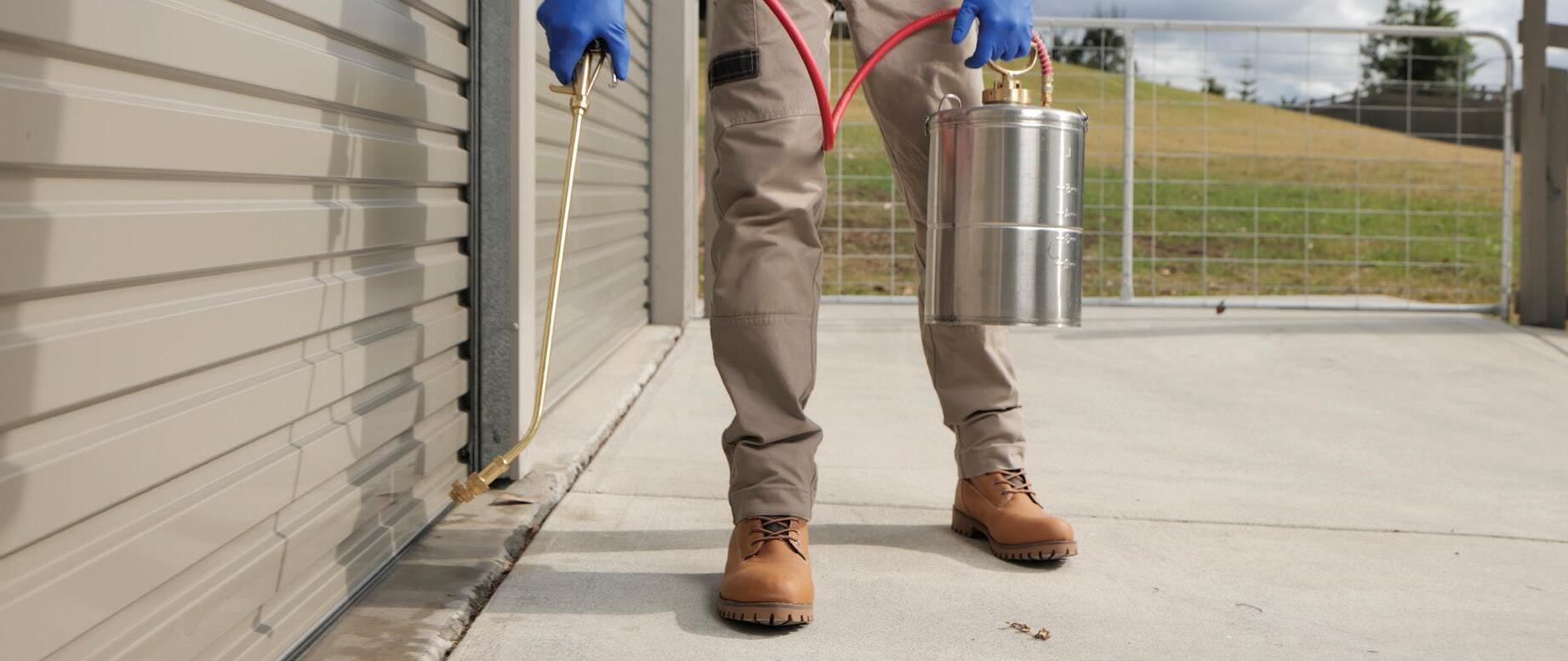
However, it was not the case with observed leaching losses remaining relatively high.
“It suggests that urinary N returns were less important in the autumn fodder beet treatments than we anticipated.”

Instead, the residual soil N that had not been taken up by the crop when it was growing was leaching, due to the soils being left bare in late autumn, winter and early spring.
“Our findings indicate that any benefit arising from a reduction in urinary N excretion due to feeding fodder beet in late lactation was outweighed by the risk posed by leaving soil bare over the following winter.
“It shows how leaky bare soils are.”



If fodder beet was planned to be lifted or fed in late lactation it should be done at a time when soil conditions and temperatures allowed another crop or pasture to be planted in the paddock before winter.

Ross was not sure why there was so much nitrogen left in the soil in the hub paddocks when the fodder beet had been lifted.
“Maybe the amount of fertiliser applied following the recommendations was over cooked, or maybe it was from a flush of N from the pastoral soil that had been cultivated when the paddock was sown with fodder beet.”

In what may be a world first, Lincoln University scientists have identified specific groups of naturally occurring fungi that can help cut nitrate losses and lower nitrous oxide gas emissions, all while helping boost pasture production and potentially improve drought tolerance.
The findings are a result of almost 10 years of work by Professor John Hampton and Dr Hossein Alizadeh who are continuing to research the effects of these specific fungi with the view to developing commercially available, biological products with Ravensdown that could be available to farmers by 2026. The products are expected to be a seed coating for pasture species or a prill that can be drilled into existing pasture.
It’s part of Ravensdown’s N-Vision NZ suite of nitrogen loss management technologies that will also include new, next-generation nitrification inhibitors and a nitrogen decision support tool.
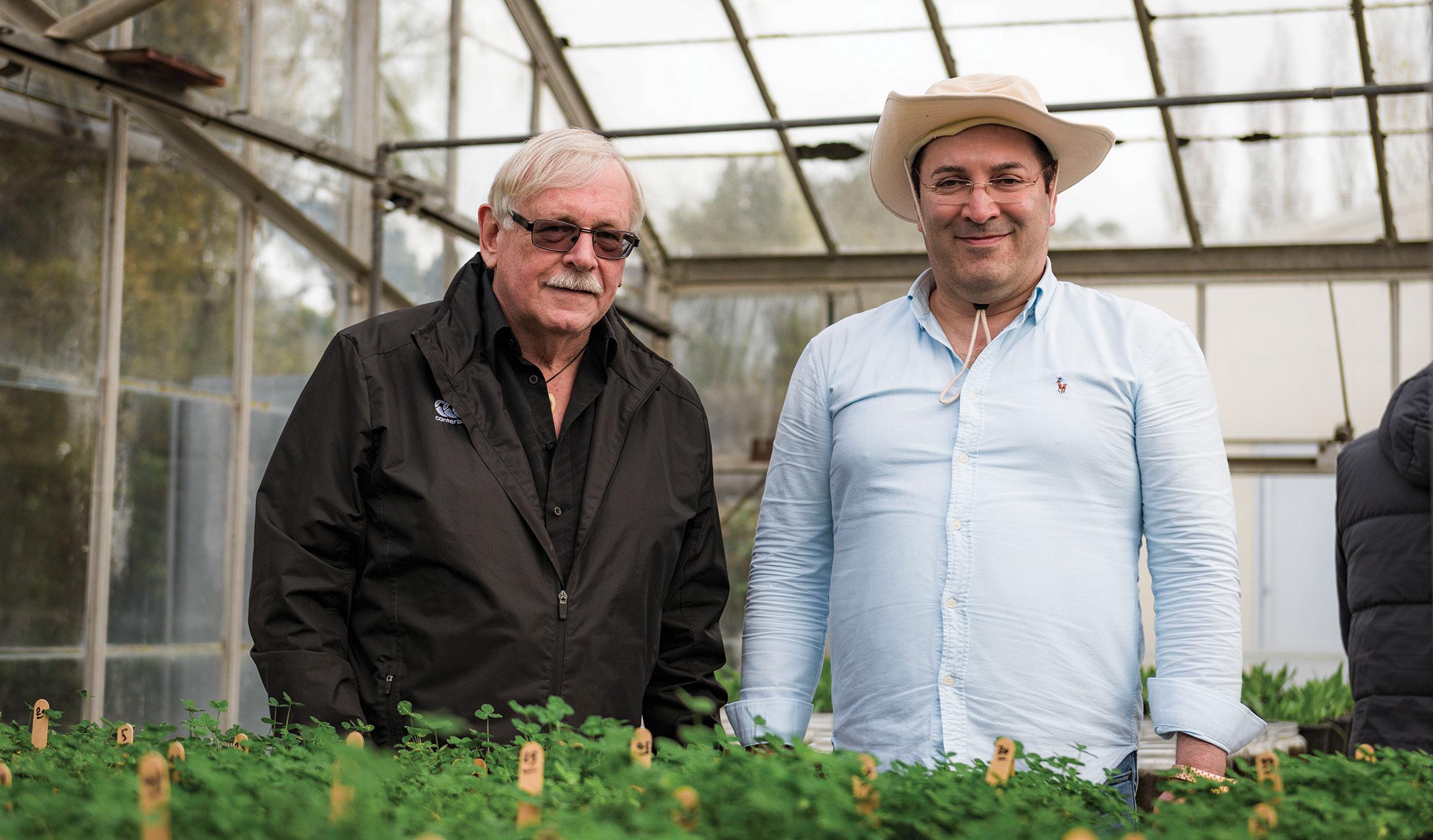
The nitrification inhibitor work is being carried out by Lincoln University soil scientists led by Professors Hong Di and Keith Cameron. While more details on the nitrification inhibitors are yet to be
revealed, the scientists working on the fungi have been able to share their results so far on what the tiny microbes can do to significantly help farmers lower their environmental footprint.
Indications are that the microscopic microbes can pack a powerful punch to other soil dwelling bedfellows of the bacterial kind involved in the nitrogen cycle. Those bacteria produce urease which is an enzyme that’s critical for the very first step in the nitrogen cycle - the breakdown of urea to ammonium.
They don’t completely stop the process because of the sheer number of urease-producing bacteria but they do slow it down which is why they can create a win:win situation.
Win one - Less nitrogen is lost either as nitrous oxide to the atmosphere or as nitrate through leaching. Win two - Urea-N remains available longer so plant growth is improved.
Hossein says studies have found that the urease producing bacteria are involved in other important steps further along in the nitrogen cycle: -
• The nitrification process – the step in the nitrogen cycle where ammonium goes to nitrite and then readily leached nitrate.
• Production of the potent greenhouse gas nitrous oxide from nitrate.
John says the results have consistently been within the ranges they have found in field trials
A naturally occurring group of fungi shows promise with nitrogen reduction and other pastoral benefits. Anne Lee reports.
(Urease producing microbes)
The specialised fungi act on the urease producing microbes slowing down transformation of urea to ammonium. Although not the main players in nitrification to turn ammonium to nitrite and nitrate or the process involved in producing nitrous oxide, urease producing microbes have been found to play a role.
from across the country and across soil types.
One study has found responses right out to 15 months but research is underway into how often applications need to be made.
John and Hossein’s studies have found applications of the specific fungi can:
Reduce:
• The soil nitrate content by 1727%
• Nitrous oxide production by 30-42%
• Ammonia volatilisation by 18-40%
Increase:
• Pasture drymatter production by 15-21%
Indications are that it could be annually, John says.
The work to find the beneficial fungi started way back in 2013 and likening it to finding a needle in haystack is severely diminishing just how gargantuan the task has been.
AGMARDT funding for a post-doctoral study back in 2013 enabled Hossein to begin his quest by first establishing what urease producing microbes were in dairy pastures. The Ministry of Business, Innovation and Employment (MBIE) then came on board to help him continue his studies into narrowing down fungi species which could help slow the process down.
He’s dug into dairy pastures across the country, hunting out strains of fungi from a specific species in a huge screening project to find out effects they could have on soil bacteria.
John says they isolated about 300 beneficial fungi and screened them one by one.
So far they have three to four strains that they’re confident can produce the beneficial results.
“It’s been a huge amount of work to find them,” Hossein says.
Over the past four years they’ve been following up glasshouse studies with research out in dairy pastures in regions such as Southland, Canterbury, West Coast, Manawatu, Waikato and King Country looking at the effect on the breakdown of urea in the nitrogen cycle following application of the beneficial strains of fungi.
They’ve used urea where the nitrogen has been “tagged” with an isotope so they can follow its progress and be sure it has come from the urea
they applied and not nitrogen that was already immobilised in the soil.
The next phase of research, being funded by the Ministry of Primary Industries (MPI) Sustainable Food and Fibres Futures fund and Ravensdown, will check if similar reductions in nitrogen loss from urine patches can be achieved and what happens with pasture production. It will look further into other beneficial effects of the fungi and delivery systems into pastures.
John says having spores inoculated into the seed coating is an ideal way to get good establishment of the beneficial fungi populations because it puts the fungi into close contact with the new plants’ roots.
“Sowing” prills into the soil also has the effect of depositing the fungi close to the roots.
Drought tolerance is another “line of inquiry” for the team at Lincoln. In a separate $10.7 million funded MBIE Endeavour project they are looking at what effect the presence of certain volatile compounds produced by fungi have on pasture plants’ activation of their defence systems.
“There’s some evidence that in the presence of certain microbes plants can change their defence systems against stress.
“We know that microbes can use chemical signalling picked up the plant roots that induce a defence response to an impending attack – that could be from insects or pathogens, heat or drought stress,” John says.
The scientists will be looking at the volatile organic compounds produced by the microbes and how they interact with pasture plants, developing an understanding of what happens in the plant and then working on how this could be used to ensure pastures are more resilient.
Results from a Rangitikei beef and cropping farm spurred a Dannevirke couple to install a woodchip bioreactor on their farm to extract excess nitrate from drainage water.
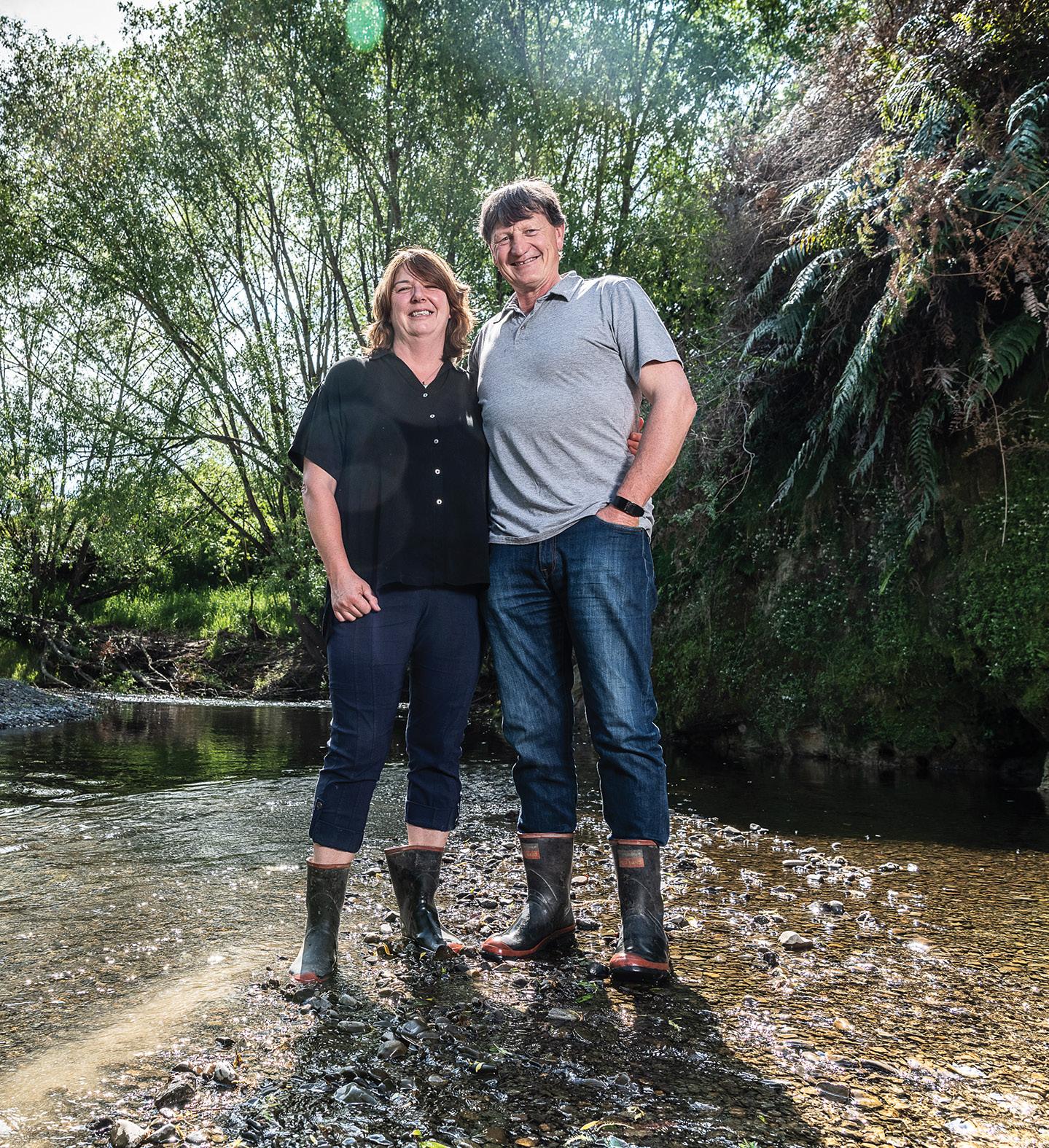 By Jackie Harrigan.
By Jackie Harrigan.
Research on a suite of nutrient mitigation options is getting to the point of results and finding a low-cost option for farmers to extract excess nitrate from their drainage water.
Dannevirke dairy farmers Andrew Hardie and Helen Long were tracking the results of the Massey University research at Hugh and Roger Dalrymple’s Bulls beef and mixed cropping farm and decided to install a woodchip bioreactor on their Te Maunga once-a-day (OAD) dairy farm.
The Bulls bioreactor has been monitored over the past three years and from a site of 90 cubic metres of pine woodchips in a lined pit, the nitrate removal rate was measured at 0.85g/cu m/day, about 28kg N per year.
That rate of outflow/inflow of nitrate-N
showed a 64% removal rate of the nitrate by passing through the bioreactor.
While this performance in real terms was lower than Massey University researchers
Ranvir Singh and Dave Horne expected, they said the sand country running cattle finishing had a relatively low level of nitrate flowing into the bioreactor and they were heartened by the rate of removal. For Andrew Hardie and Helen Long, the bioreactor offered another tool in the toolbox of nitrate removal and mitigation from their 429 hectare farm which is bordered by the Manawatū and Mangatewainui Rivers.
With a 258ha milking platform milking 700 cows once-a day, the couple, Ballance Farm Environment winners in 2018, have spent the past 22 years developing, draining, establishing wetlands and riparian plantings, production woodlots and retiring native planted land and considered themselves environmentally proactive and good guardians of the rivers and water quality.
A Massey conference piqued their interest in bioreactors for removing nitrates and after the Massey field day they received a grant from Horizons regional council to test the drainage water travelling into a wetland area, draining the artificial drainage system on 65ha of intensive dairy land and the effluent application area. They were shocked at the amount of nitrate-N, up to 25g/cu m in a rain event that included runoff from the races.
“We know that the Manawatu River has not been overly affected because Helen has been testing the river for the catchment group, but we realised that the drainage water is a potential risk as a point source of pollution.”
A $10,000 grant from the Manawatu River Leaders Group helped them convert the wetland into a bioreactor that would be monitored by scientists at the university to capture data on the rates of nitrate extraction.
“Being proactive people, we saw that we could add some good science-based data to the argument, and maybe influence some regulation,” Andrew said.
“Farmers aren’t scared of regulation if it’s based on fact - most farmers have a genuine desire to improve their environmental impactit’s good for their business. And with a practical mitigation and an independent source of monitoring through Massey University it only adds credibility to the project and the results.”
In 2022 we renamed some of our existing maize hybrid products using the PAC naming system. We understand that may have been confusing for those who were familiar with our previous names. We also understand that the use of “PAC” may be confusing because it is associated with Pacific Seeds.
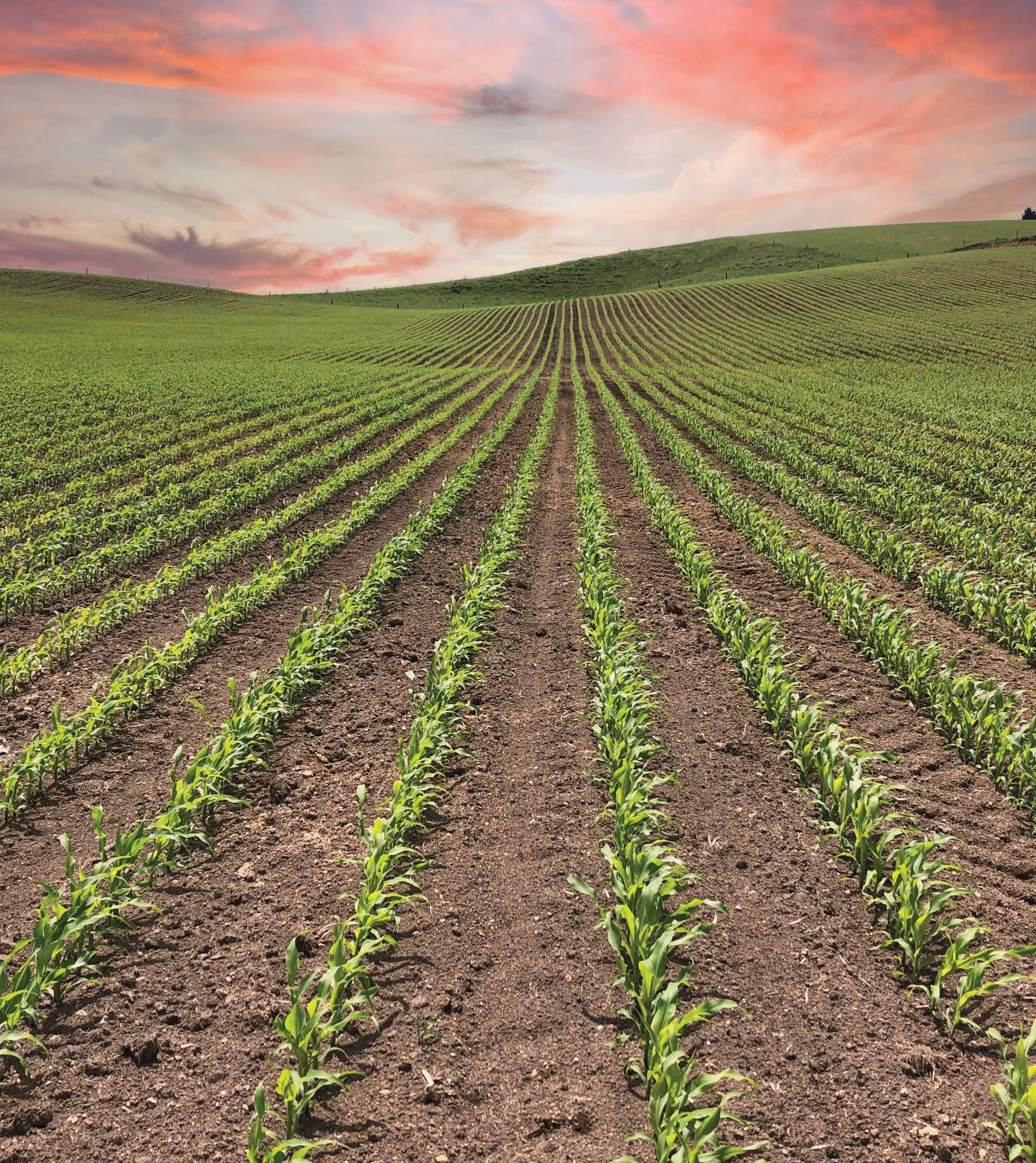
To clarify the changes we have made, we wish to make it clear that not all our hybrids are sourced from Pacific Seeds, and that we have adopted the Pacific Seeds (PAC) naming convention to meet market requests and simplify the names we use. The table alongside sets out the new PAC name and the previous names of each hybrid.
We also described a group of hybrids as “Dairy Platform Specialist Maize Hybrids”. They were also advertised as a new group and newly introduced. The hybrids in this group are existing Corson hybrids that were selected by us as suitable for use on dairy platforms.
Come on over and grow with us.
0800 4 MAIZE (62493) or visit corsonmaize.co.nz
With their own digger and tractor, Andrew and Helen are a great team on a project - he dug the hole with the digger and she moved the fill away with the tractor. They conferred with the Massey researchers, got an idea of the volume required and dug a big hole, lined it with a geotech fabric to cushion any stones, then recycled a couple of old polythene silage covers and filled it with 170 cu m of wood chips.
Their plan to chip forestry slash from a pine woodlot they had harvested was derailed by Covid and the chipper not being available so they bought the wood chip in and spent the grant money that way.

The researchers installed monitoring equipment and covered the bioreactor with a windbreak cloth (to protect the monitoring instruments), but Andrew said overseas the bioreactors are often grassed over. They hope the chip will last 10 years and plan to scrape out the compost and apply it to a crop paddock.
The science behind the bioreactor is simple, Andrew said.
Essentially the hole filled with chips fills up with water and in the anaerobic environment (without oxygen) the bugs take oxygen from the NO3 -N in the water and use the oxygen to eat away at the carbon in the woodchips. The inert N2 gas is released from the bioreactor into the
environment and the carbon breaks down over time into composting material.
After a year of monitoring, the results from the bioreactor show nitrate-N in the drainage water has been reduced by 40% by passing it through the bioreactor, and 188kg nitrate N is removed each year, from the 65ha treated.
The efficiency is highest at a flow rate of 2-3 litres/second. At higher flow rates the extraction is less efficient and when the water is flowing faster, after rainfall, the excess water bypasses the
bioreactor.
Only 27% of the drainflow was captured through the bioreactor, but Andrew and Helen have a plan to increase that.
“The other thing we are looking at doing is building a retention dam (earthwall dam) to hold up the water in a large rainfall dump to allow it to all be slowed down and treated through the bioreactor.”
There is the potential to have a bioreactor at the end of every artificial
drainage area on the farm, Andrew said, and he and Helen have identified a further three areas to drain through a bioreactor, lifting the areas treated from about 25% to about 60%.
“Now the technology is proven, we could potentially have a small bioreactor at the end of each of the drainage areas before they reach the river.
“One of the things that we like to think might happen might be that good policy will be made, based on sound science to actually enable us to carry on farming sustainably, reducing our impact on the environment but meeting regulations.”
Next steps for the research is to expand the number of bioreactors monitored and
build capability around designing and specifying the size required to remove a certain amount of nitrate from artificial drainage water.
A suite of three projects investigated with Sustainable Farming Fund Project funding explored the potential to remove contaminants from drainage water before they reach streams and rivers:
• Woodchip bioreactors installed and monitored in Bulls and Dannevirke

• Controlled drainage in Bulls, coastal Rangitikei sand country
• Drainage water recycling in Bulls, Rangitikei sand country.
HIGHLY PROFITABLE TURNKEY IRRIGATED DAIRY FARM Warrnambool District – 1224 Acres / 495.5 HA
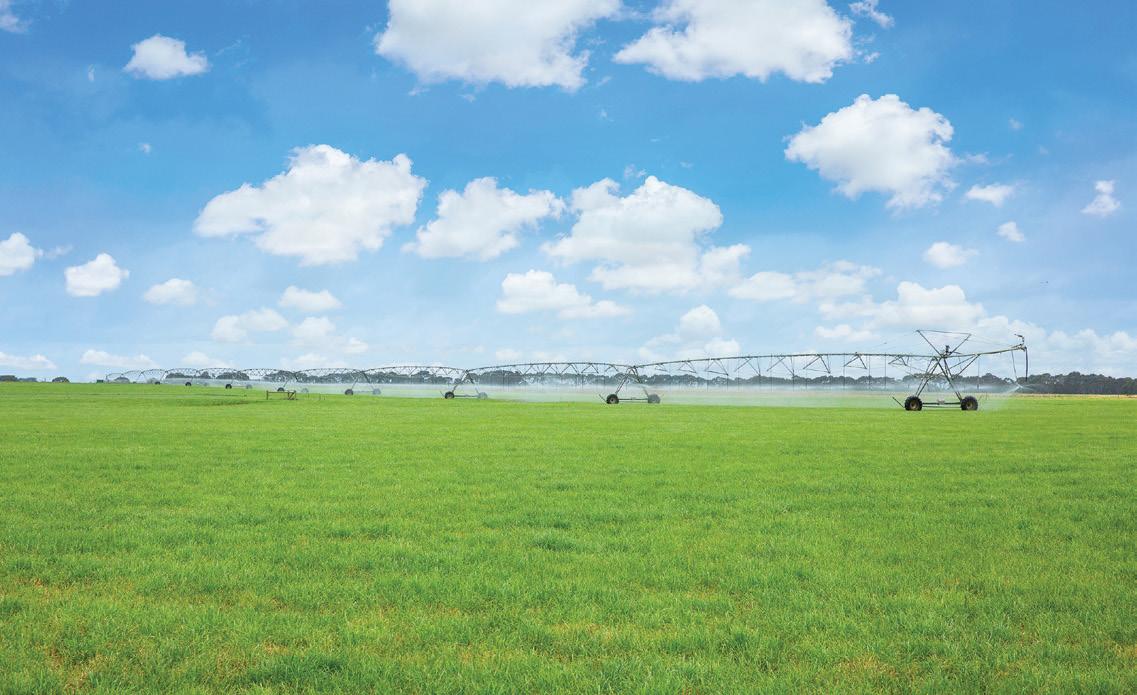
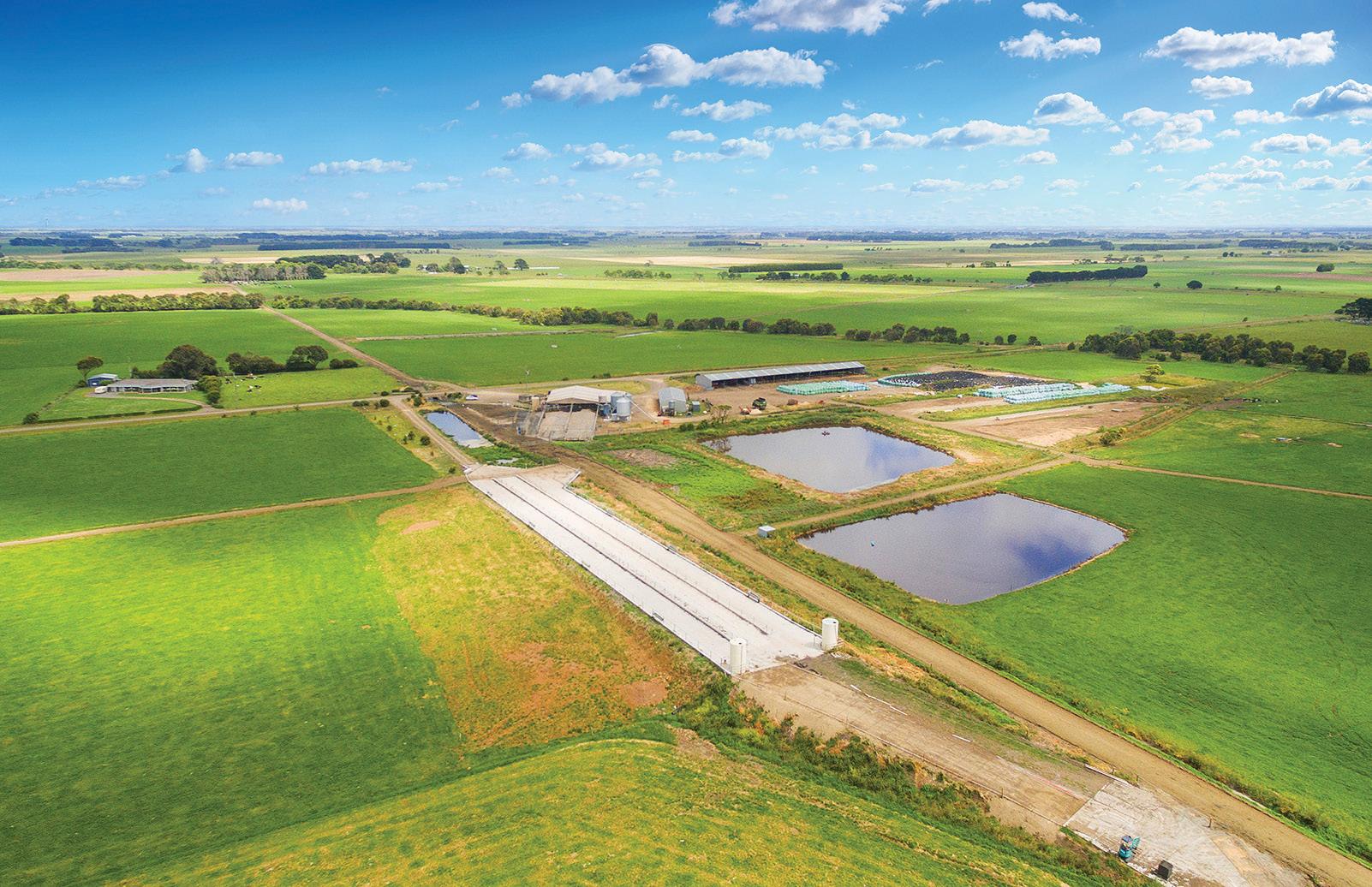
LARGE SCALE: 872 Acres freehold, 352 Acres leasehold (4 + 5 yr term) ideally situated 5 km to Koroit and 25km to Warrnambool.
PERFORMANCE & PRODUCTIVITY: 7.3M litres of milk and 553,367kg of milk solids produced in the 2021/2022 FY, from award winning cow herd - Top 100 highest quality milk produced nationally - Dairy Australia, October 2022.
SECURITY: 346 Acres Pivot irrigation - 132 Acres freehold - 214 Acres leasehold. Effective low cost irrigation operation. Situated in the centre of the blue ribbon dairying district - Number 1 nationally.
SUPERIOR INFRASTRUCTURE: Fully automated and computerized one man fifty unit rotary dairy, 19,500L vat, 500 cow yard capacity, 3 phase power. 750 cow capacity feed pads. 13 bay purpose built calf shed and machinery shedding.
QUALITY RESIDENCES: Spacious fully appointed 4 brm grey brick homestead (c.1995) plus 4 brm home and 2 brm cottage.
WALK IN WALK OUT PREFERRED OPTION - 900 head cow herd, conserved fodder, plant and machinery allows purchaser to "hit the ground running". 188 Acre outpaddock available if required.
An exceptional opportunity to acquire a large scale turnkey highly profitable and cost effective operation in a sought after dairying and desirable lifestyle location.
Nick Adamson +61 418 571 589
E: nadamson@charlesstewart.com.au

ooking at running large-scale solar arrays onfarm and selling power into the national grid could potentially be a new revenue stream for some farmers.
But installing big arrays is not cheap and most interested farmers will likely look at leasing their land to energy companies with deeper pockets and more expertise.
There are also limitations to where largescale solar arrays can be installed.
One of the key constraints is proximity to the transmission line network that makes up Transpower New Zealand’s national power grid.
Large-scale solar farms are often found in clusters, around connections into grids.
But if you just want to provide for your own onfarm energy needs you can still sell off smaller amounts back to the grid through your own power connection.
Running a smaller scale array could be worth looking at particularly if you have high energy demands outside the milking operation - like powering irrigators.
A study done recently by government-run EECA (Energy Efficiency and Conservation Authority) looked at commercial-scale solar in NZ and analysed the financial performance
of onsite solar for various business types and in different regions. This covered 144 different businesses around the country from big box retail to warehousing and corporate offices. www.eeca.govt.nz/insights/eeca-insights/ commercial-scale-solar-in-new-zealand Included in the analysis was a single “quite large dairy farm” in Canterbury.
Internal returns on investment for a food and beverage production site and a corporate office in Auckland got returns of 7.2% and 7.6% respectively, and a wholesale food market in Christchurch 6.8%. But surprisingly, the dairy farm only notched up a 4.4% return.
Large Canterbury farms are likely to be drawing a lot of power through the dry summer months running irrigators, including some running 24 hours a day.
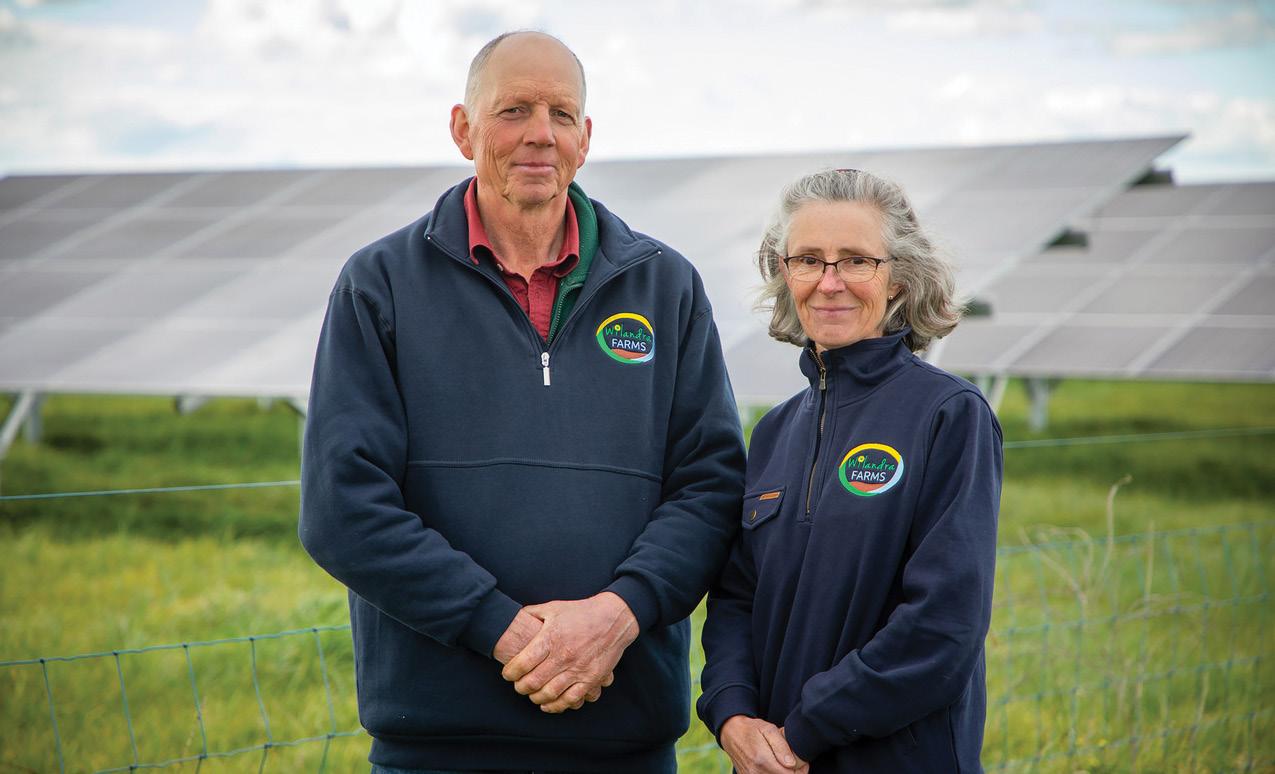
And many farms south of the Rakaia River also don’t get pressurised water to their property and have to pump even more.
But summer power consumption didn’t increase in the report data.
When EECA was queried over the dairy farm in their report, it turns out there was an irrigator onfarm but it had been on a different power meter, and not included in
Farming the sun and farming with the sun has significant potential for many New Zealand farmers.
Dickey.Wilco Droppert and Sandra Jefford had been looking for a cheaper irrigation option.
the report. The results were from power usage at the dairy shed, although this isn’t stated.
“As you’ll see from the report, the IRR for the cow shed wasn’t great in comparison to other business types that we looked at, but I’d expect solar powering an irrigator would be a reasonably good match,” Gareth Gretton, senior advisor at the authority says.
To see how an onfarm solar installation might perform we look across the Tasman.
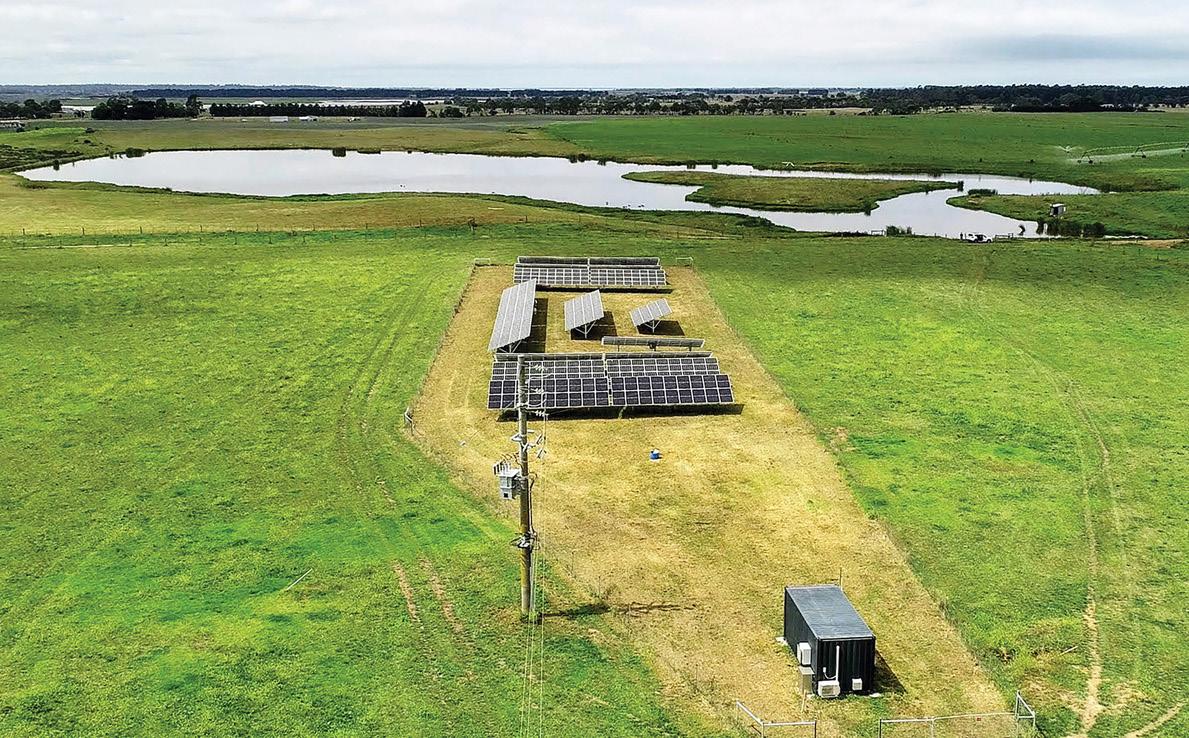
When Sandra Jefford and husband Wilco Droppert moved on to their 350-hectare dairy farm near Sale in Victoria, 11 years ago, they found themselves having to run centre pivot irrigators during warmer months.
“We came from a farm in a high rainfall area so when we came here, I thought the bills were just ridiculous - 70% of our energy cost was going into running the irrigators.”
There is a large dam on their farm, two bores and they also pump from the Avon River. Three pivot irrigators on the homeblock water their best pasture.

They took up a subsidy on energy audits for irrigation systems which saw them changing some aspects of their operation to make it more water efficient, then looked at solar arrays to power their system. Their business - Wilandra Farms is made up of several titles.
Regulations in Victoria make using renewable energy on larger farms, with multiple land titles, complicated. Ideally a microgrid would be set up where power from renewable energy would be fed into the electricity grid and used wherever it was needed around the farm.
But power generated on one title can’t currently be taken across title boundaries.
This saw the couple installing solar at two sites on the farm and saw them replace a large diesel pump with two electric ones. The panels across the farm are all bi-facial, collecting the sun’s energy on both sides. The bigger 150-kilowatt (kW) array does much of the heavy lifting on the main farm title including for two electric pumps at the dam, a power line to another bore and two electric pivots (the last pivot - diesel operated - will also eventually change to an electric one). Here the panels are tilted and placed to collect early morning and later afternoon light, as well as the traditional north-facing for the rest of the day. Another 50kW array is used for another pump.
A smaller 29kW array is used for the dairy shed but isn’t as effective. The panels are only north facing, producing most power during the middle of the day when the dairy isn’t in use. Some additional east and west-facing panels too would be better here, Sandra says.
The management system, using AEI SmartBoxes, that coordinate the available power with the need to pump water, is a critical feature, Sandra says, with the mix of fixed and variable loads that are stopped and started
as power changes, also important. Using solar power has seen them change their operation including doing most of the irrigation during the day, rather than at night when off-peak power prices are lower, so they get a much better sleep. Any pivot problems can now be sorted out during the day. Overall, the change has seen them save 15 hours of labour a week, in peak irrigation season.
Instead of pumping a lot of water directly from the bores to the pivots they now find it more cost effective to pump water into the dam using the free solar power generated, then pump it out when they’re ready, again using renewable energy. They might still use imported power during weekends during peak irrigation season.
Variable speed drives on the pumps mean they can run at very low levels of power.
“They may be 37kW pumps but once they’ve got 10kW of solar power – perhaps in the early morning, they can start automatically if we need water at the dam.”
Other changes included replacing a 150mm pipe with a 200mm diameter pipe to reduce the amount of energy needed to pump the water around.
Top:
facing east and west, as well as north, capture sunlight all through the day.
Bottom: Electric water pumps have replaced a single large diesel pump.
The 299kW solar system cost A$348,000 (about NZ$376,000) - about A$1740/kW - but can only operate when it’s sunny. This should reduce power from the grid by 90% and see irrigation power costs during irrigation season drop from A$100,000 to under A$15,000. There are also plans to install two 15kW Britwind turbines, which Sandra reckons should produce a lot more kW power than solar panels.



The two turbines will have a 30kW output and cost A$279,000. This equates to A$9300 per kW.
“Because turbines can work during the night, you’ll get a lot more power out of five kilowatts of turbine in the long run. They may be more expensive per kilowatt to buy but the output is a lot higher,” Sandra says.
• The Wilandra Smart Power Project was part-funded by Victoria’s Agriculture Energy Investment Plan. Anyone keen on a trip across the ditch to see how it works can book in to a field day on February 2bookings at www.ivvy.com.au/event/wilandra2023
Sorting out a hybrid solar irrigation system can be tricky as Kiwi-born Karin Stark, director of Farm Renewables Consulting found out.
Four years ago cotton and wheat farmers Karin and partner Jon Elder were spending about A$350,000 each year on diesel to pump groundwater from bores for their summer crops at Narromine, New South Wales. Karin was working for the NSW government running courses in renewable energy at the time, including a few on solar irrigation after farmers had shown some interest to cut costs.
“We got 60 or 70 farmers in the room at Warren, which is a little town in the middle of nowhere, for example,” she says.
When a neighbour put in a 100kW solar/diesel pump – possibly one of the first commercially viable
pumps in the country, Karin and Jon were keen to get something similar up and running on their place. Their 500kW solar/diesel hybrid system sees an electric water pump run partially off the solar array with the diesel generator kicking in when solar input, on overcast days, reduces. At night the diesel generator works by itself to fill their reservoirs for irrigation. The array has 1550 solar panels and is installed on one hectare of land. With three-quarters of their water coming from bores, the system pumps 15 megalitres of water a day with solar contributing up to seven megalitres of that. In their first year it cut their diesel bill nearly in half, saving about A$180,000 along with eliminating 500 tonnes of carbon emissions per year.
As early adopters of a hybrid system Karin says their experience may help other farmers iron out issues. It
was hoped the savings would pay off the new system in five years. But blending the diesel generator with the solar has proved problematic and set the payback period by a couple of years.
The problem lies with the big 500kVA Cat generator they have, Karin says, and why batteries would make a big difference.
“The Cat generators are made to work on their own.” When it’s cloudy, the solar starts to drop its power to the pump, and the generator isn’t quick enough to replace that lost solar. The whole thing will switch off, she says.
“My partner Jon was going out there turning it on and off. Also, you don’t want that water to be going up and down the shaft because it stirs up the silt at the bottom.”
The other problem is calling on the massive diesel generator to just trickle in a light bulb’s worth of power at sunrise or sunset when the solar setup starts to reduce the power it’s providing. Because they are made to be working at 60% efficiency, not 10% it can cause glazing on the generator, Karin advises.
Battery storage would use the battery instead of the diesel generator for those little bits where you just need to blend a little bit to provide the power that’s required for the pump, she says.
Because they use a lot of energy they have been quoted between A$400,000 and A$600,000 for a battery big enough for the load. For her part, while seeing batteries work at household scale or really big storage scale that sees Tesla batteries used by Australian national power companies, Karin thinks it may take a few years yet of technology development before battery storage will work for that mid-scale high-irrigation agricultural scene they operate in. For some less power-hungry
farms, solar arrays and batteries are already being used in rural Australia. In Western Australia, energy provider Western Power has started removing power lines to some farms and replacing them with standalone power systems - solar arrays and batteries.

Their solar arrays of about 60 panels provide nearly 20kW of energy - about four-times the amount of a standard rooftop array. Supplying the systems is cheaper, they say, than the cost of maintaining some long-distance power lines with few residents connected, which are also vulnerable to things like falling trees or bush fires. Western Power has installed 100 solar systems so far but is looking at 4000 in the next 10 years and up to 6000 in the following 20 to 30 years.
Back in NZ principal technical advisor with Irrigation NZ, Stephen McNally can see advantages for farmers having more control over their power supply.
Some energy companies have been trialling power shedding in the southern Rakaia area, which could be an indicator of where things may head.
Voluntary shedding works like a lower-priced energy plan where hot water cylinders are turned off when the loading gets too high. In this instance it could mean the irrigator turns off for a time. Last year, Stephen recalls the Ministry of Business Innovation and Employment and ECCA were discussing bringing in a similar star rating for water pumps as is used for appliances to show how energy efficient they are.
“Pumping accounts for quite a lot of the connected load in New Zealand,” Stephen says. “Farmers have to pump their irrigation water – so anything that gives them a little bit of independence on energy production is likely to be a good thing.
“In the future people may well look at putting in more renewables like solar and small hydro schemes. If you’re storing or moving water for farming purposes you’ve got a stored energy source so you could be running it through a mini or micro turbine.
“With some areas getting drier in the summer – the east coast of the north island from Wairarapa, Hawkes Bay, Gisborne, right up through the Bay of Plenty could become more significant irrigated areas in the future.”
A regional response may be needed to tackle this increase in water and energy needs in the future, but it may also lead to a national collective water and energy balance being looked at.
“If you’re going to supply water storage for irrigated areas (as with the combined Northland councils’ Kaipara water scheme and its new reservoir to supply 7000 hectares of new horticultural land), then you have the opportunity for renewable energy options,” he says.
“We talk about New Zealanders being resilient. That doesn’t mean toughing it out, or sucking it up. It means having a quiet sit down and a think. We can solve these issues – sometimes we just need the time to think about things in a calm and considered way. And that’s resilience.”
Ed Jackson is a former dairy farmer now dairy heifer grazier, and he has kept a lot of his old dairy farming tricks to maximise growth and make sure his young charges reach their targets.
As a grazier he is just one cog in the wheel of getting the heifers to the stage of productive cows, he says, and the growth journey starts on day one in the calf shed.
“If you send me something that’s too small and it’s then impossible for me to grow it to 500kg - I only have 365 days on a May-to-May grazing contract.”
Ed ran the participants at a recent SMASH South Taranaki heifer grazing day through the how and when of his operation and keeping the heifers growing and the owners happy on his Manawatu operation where he runs 300 R2 heifers on May-May contracts and a handful of steers and weaner heifers. Ed grazes calves through Vet Care (Wanganui Vet Services) and for a handful of private clients and says the target for most of the heifers to arrive is 220-250kg on May 1.
Targets are important, Ed says.
“The grazing journey is a matter of hitting all the small steps on the way through - if you hit all the targets, you will get to the main target - and if they meet the main target they won’t fall out of the system at three years of age.”
“If you send me animals under their start weight I will struggle to get them to the finish weight - I only have 365 days.”
Too many heifers are falling out of the national herd at age three, when they fail to rebreed because they are not grown well enough, Ed says.
“Why are so many farmers rearing 20-25% replacements? It should be down at 18% and if the heifers go home at their target of 450 or 500kg then they won’t need to be still growing as an in-calf two year old when they don’t rebreed and then drop out of the herd.”
Pasture basics: once a dairy farmer
“The basics are to feed anyone else’s stock like you are milking cows and so it’s imperative to have high ME grass,” Ed told the crowd.
“We don’t expect them to do any cleaning up - and we don’t push the post-grazing residual down past 1500kg drymatter (DM)/ha.
“You can’t ignore winter and then think you will catch up the growth rate - you will never catch it up.
“Even if you are doing 1.2kg liveweight gain (LWG)/day at the moment (late spring) but if you have only done 0.3kg LWG/day during the winter, you will never catch that up.”
“This winter was the hardest we have had in the Manawatu, and we were down to 0.6-0.7kg LWG/day.”
But, he says he can’t count on the summer as grass quality drops off so the heifers need to be putting on weight the whole way through. Planning is crucial, he said, managing the grass by setting the round lengths.
“In winter I plan out the whole year - starting at the spring rotation planner in spring - planning how I will get to balance date?”
He plans for 90 days’ rotation through the winter, then enacts the spring rotation planner, down to a 20-day round in November, pushing out to 40 days in December and then 50 days over January-February.
Trace minerals:
On everything that arrives on the farm: a B12 as they arrive, a selenium shot, and all the way through, Cu if they come from a low area, is Ed’s ‘minerals mantra’.
“Do the basics right and they will put weight on.”
Parasite control:
“I am not a fan of drenching religiously, it’s a task that shouldn’t be done,” Ed says.
A basic quarantine drench as each mob arrives is obviously important and then it’s done on a needs basis.
Ed uses oral drenches until the heifers get too big to hold, and then moves to pour-on products.
“After mating the heifers only get a pour-on treatment if they have a grubby tail or are not meeting weight gains.”
He went on to tell the crowd that his most important piece of kit is a weigh scale that tracks daily weight gain (DWG) or loss from the last weighing - so that while the heifer is on the weigh scales he can be proactive and draft her out for treatment.
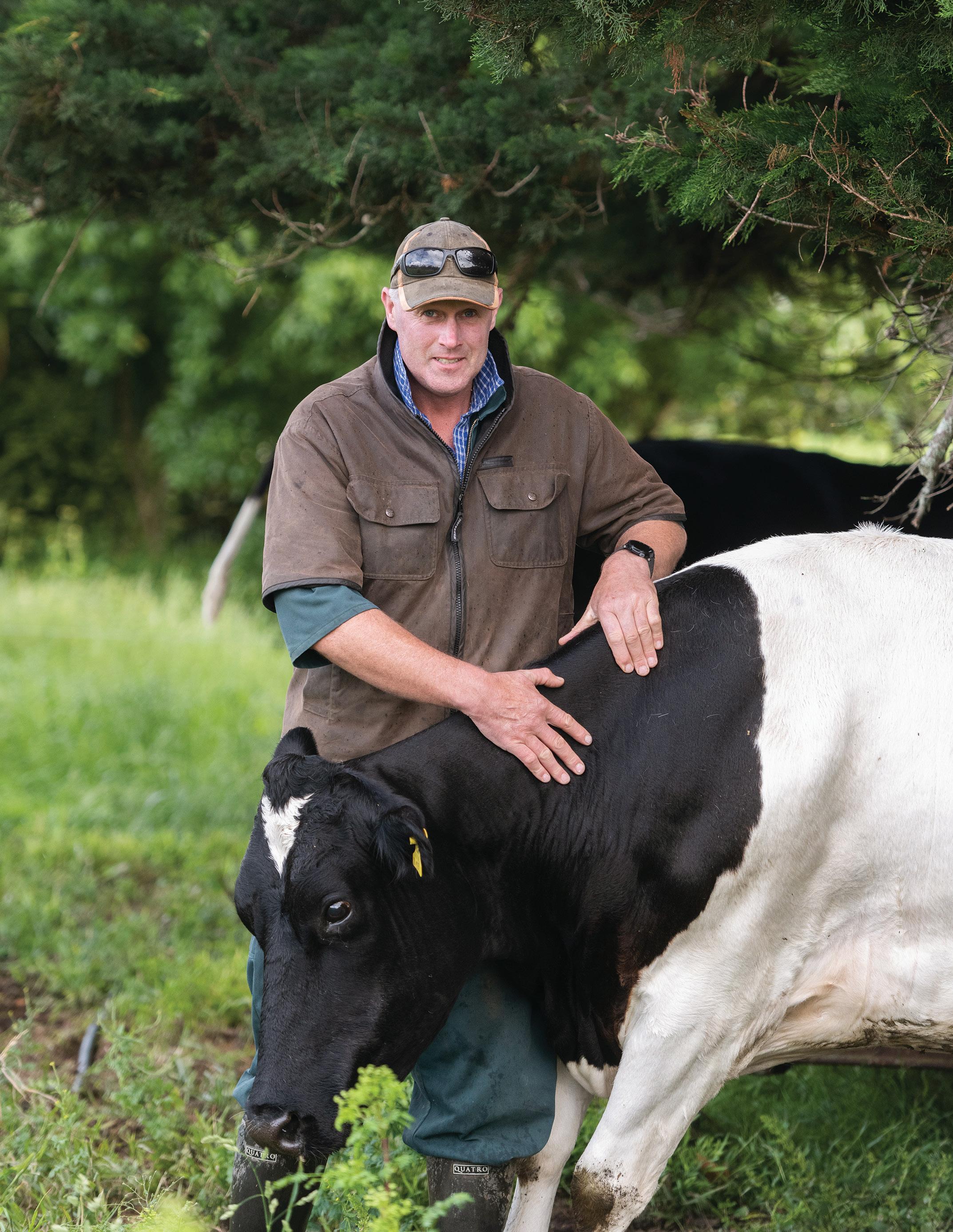
“For every animal we need to know if she is ahead of target or behind target for her - because it depends on her breeding.
“We can only manage what we measure, I need good data like DWG since the last weighing to think “ am I drafting her out” on the spot?
“Then I can decide whether she needs a vet, bloods taken or does she have a shitty tail and just needs a pour-on?
“If I don’t get instant DWG data I have to go home, download the data, make the comparison, and then go back and find her, separate her and treat her - it’s too hard.
“Get some weigh scales that tell you the weight gain - it’s the best investment I have ever madebetter than buying drench.”
Mating:
Ed says it’s all about good bull management, and that the bulls must be inspected as sound.
“I don’t want big teams of bulls, no more than four in a group or you tend to get dominant bulls that bully the others.”
For bigger mobs you need to rotate the bulls and watch them for dominance also.
Biosecurity:
Ed runs more than 300 heifers on his farm and has it planned out so that there are never mobs beside each other and different mobs never able to contact each other over the fence.

“Each mob has a specific area of the farm and are all run separately.”
There can be a weight difference of 10% due to gutfill so whether you weigh on a full gut or empty heifers out, be consistent, Ed Jackson said. “They tend to be easier to weigh with a full gut as they are easier to handle, not so flighty.”
Charging schedule: For Ed’s grazing services, all costs are included like drenches and animal health, as he says that way he knows what the animals are getting. He charges a flat weekly rate of $3.60/head for maintenance plus a weekly price per kg weight gain of $2.25/kg.
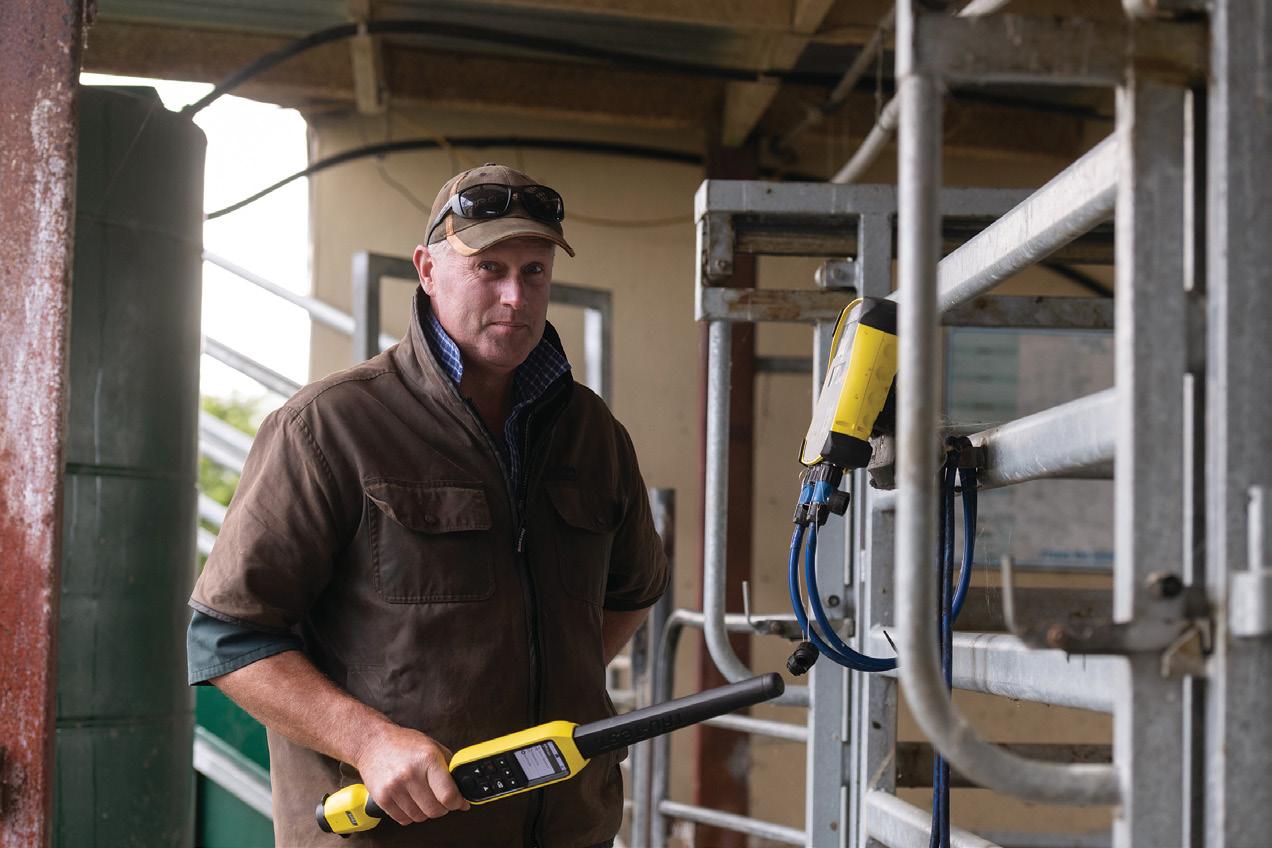
“The weight gain basis is the fairest system to charge,” Ed says, “but you have to weigh regularly.”
He tends to weigh everything every six weeks, and at least, on arrival, mid-winter, pre-mating and pregnant weight. The heifers he grazes for VetCare are weighed seven times each year.
Below: Running his heifer grazing enterprise like a dairy farm means putting lots of emphasis on pastures and fulling feeding the heifers. Ed Jackson says his favourite bit of kit is his weighing gear that allows an instant daily weight gain reading.So depending on growth rates, the heifers charged from $12.50 to $17.50 per week.
The mob he grazed from December as weaners and then weighed 253kg at May 1 were charged for a DWG of 0.69kg/day and by putting on 257kg by May 1 finished at the target of 510kg and were the cheapest to graze, Ed says.
In contrast the mob that came on at 175kg and added 295kg, end up at 470kg on May 1 but with a DWG of 0.81kg/day were the most expensive. (Both groups had a finish target of 500kg).
Choosing the target based on the specific breeding of the animal is the only way to set the end target, Ed says.
“It depends on the genetics - you need to look at the figures of the mature weight of that breed, cross and % of purebred - as a grazier you need to know.”
Ed also warned farmers present against keeping the heifer calves from their later calving cows, saying they will struggle to reach targets and won’t be in the herd as three year olds as they will not rebreed successfully.
Steve Forsman from LIC also addressed the issue of liveweight targets, saying some farmers are not targeting the right weights for their weaner heifers
and will be undergrowing them because of that.
The target live weights for planned start of mating and May 1 are influenced by the genetics of each animal.
All animals have breeding values (BV) for multiple traits inherited from their parents, and one of the more highly heritable traits is liveweight, Steve says.
Crossbreds average estimated mature liveweight (MLW) used to be quantified as a fixed figure of 450kg, but in recent times the industry started using the breeding value for LWT added to a base of 500kg because of the huge variety that exists in the Kiwi cross animal. This was when the BV was around zero BV(0) + 500kg = 500kg, but Steve says the calculations for BVs are changing and the 2022 born BV for LWT is 9kg so BV (9kg) + 500kg = Crossbred MLV 509kg average.
Friesian and Jersey targets have changed too, and farmers should be thinking about that when they inform their grazier of what weight they want the animals to grow to by the time they come home for calving.
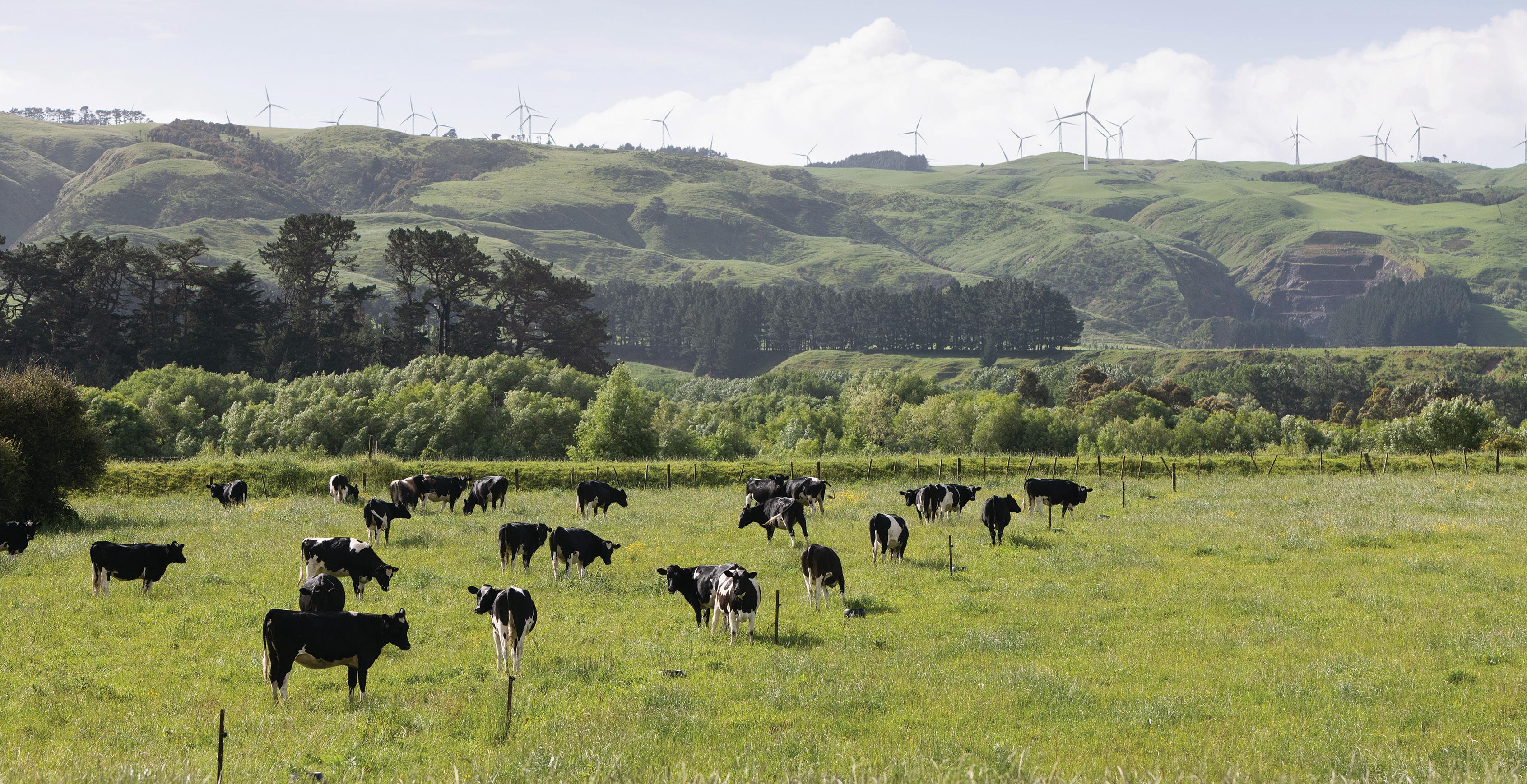
‘There can be nearly as much variation within the breed as there is across breeds these days, and you can get a 100kg difference between a ¾ Friesian and a ¾ Jersey.
“So it can be misleading to simply use breed as the marker for growth rates for the grazier.
“Every animal has its own estimated mature
Ed Jackson gave up dairy farming in favour of grazing dairy heifers but he kept his two favourite oldest cows.
“They are crucial - a good toolbecause I don’t use a dog, I like to call animals through the gate. So when the flighty dairy heifers arrive I put them in with my two pet cows in with the mob and I call the cows and the heifers follow. They learn what to do from them.”
Ian Wickham has had 50 years in the dairy industry and has cared for more than a million heifers since establishing the NZ Grazing Company in 1987. He spoke on working together and building strong grazier/owner relationships. He gave dairy farmers a 10-point list:
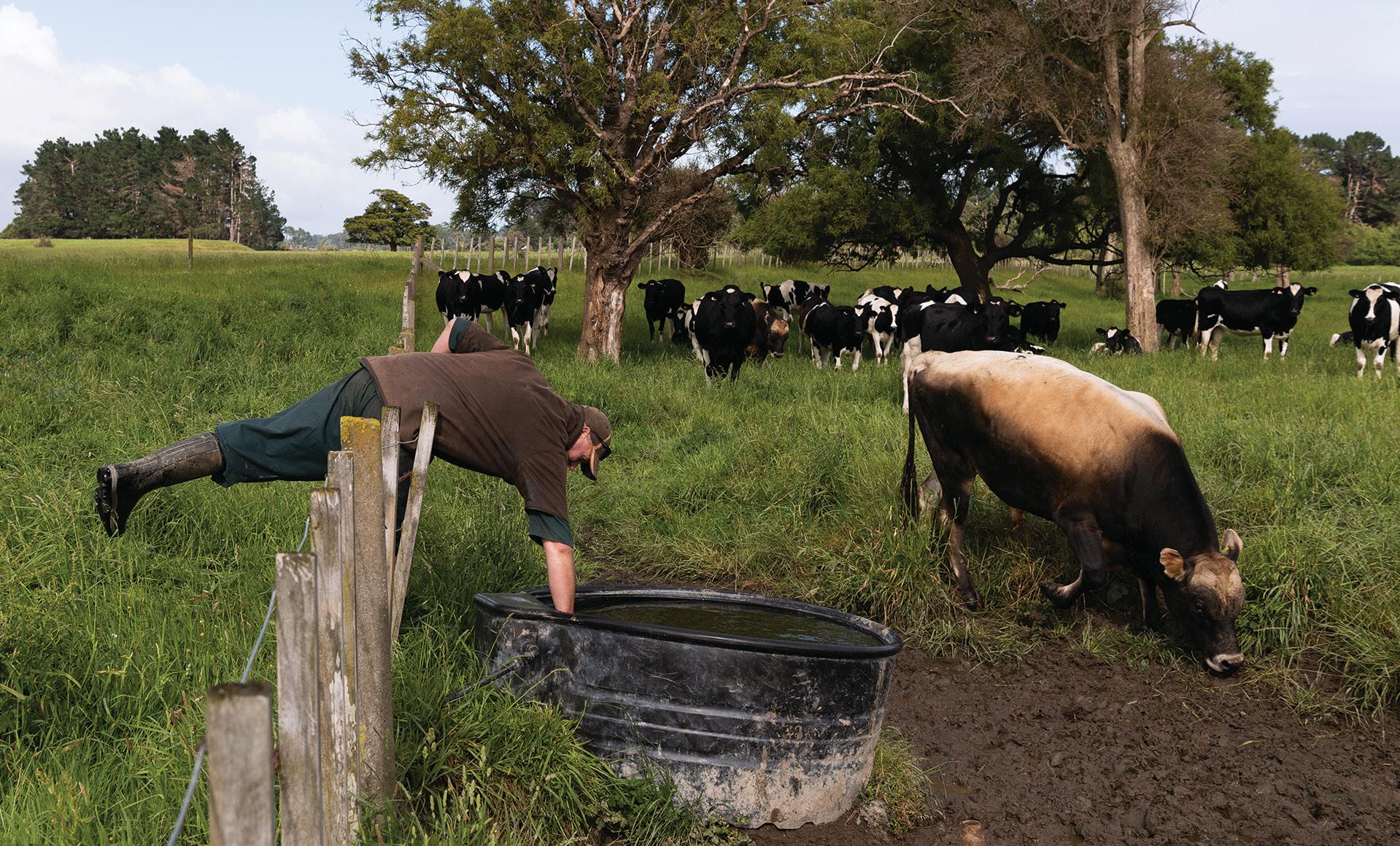
1. Define your expectations then find the best grower or owner who will endeavour to meet your expectations.
2. Document the details of the arrangements you have agreed on.
3. Measure and record all events relating to the animals.
4. Benchmark and review progress against those benchmarks - the more often the better.
5. Communicate regularly and meaningfully.
6. Prepare to hold to account any poor performance.
7. Reward and recognise good performance fairly.
8. Plan to have a successful herd entry for first lactation heifers. They are likely to be the highest genetic merit group in your herd and also the largest group by age.
9. Audit and verify your results against what you planned to achieve. Pregnancy results/first lactation milksolids performance/incalf results for second lactation?
10. Be prepared to put a lot of thought, planning and effort into this project if you want to achieve the best result.
liveweight based on its LWT breeding value, therefore it has its own target weights and its own guideline set as MINDA targets for heifers.
“Farmers can find these BVs for each animal on their MINDA records and add to 500 to get the mature live weights guide for that group of animals.
“You could very quickly make up a custom report based on the twoyear-old group and add the LWT BV attribute to that which you can export as a .csv file and add a 500 to that figure,” he says.
“Alternatively there is a file available in the Manage Animals section of MINDA-Weights that they use in MINDA and as long as they have recorded two or more weights that file contains the PSM target which can be divided by 0.6 which would render the full estimated mature LWT figure.”
These industry targets are used commonly around the world because growth of the animal and therefore the weight determines the start of puberty for the heifers and farmers need them to be cycling before the planned start of mating.
The target is to be at 20% of mature liveweight (MLW) at three months, 60% at planned start of mating (15 months) and at 90% of MLW at 22 months.
“The MINDA weights guideline
is just that - a guideline that runs through these target weights - a bit like your kids’ Plunket weight gain line,” Steve says.
“It’s not just about putting on weight - it’s actually consistently growing good heifers and using liveweight to monitor it.”
“It can get out of whack - if you have a hard winter and the animals’ growth is compromised for a long period, you might be able to pile weight on them quite quickly but you can’t make them grow up faster to compensate.”
It is estimated that cows produce 2kg milksolids (MS) less for every 1kg under their 22-month target liveweight.
In an earlier large heifer study, Steve says, 70% of heifers were on average 11% under their 22-month target.
“That’s millions of dollars of milk not going into the vat because the heifers were undergrown and still trying to catch up on their growth.”
Steve suggests getting the grazier to import the weight data into MINDAWeights or sending the owner the weigh session files to load in if they don’t have data entry permission to MINDA and then the weights can be compared against regional or national trends.
‘IF YOU HIT ALL THE TARGETS, YOU WILL GET TO THE MAIN TARGET - AND IF THEY MEET THE MAIN TARGET THEY WON’T FALL OUT OF THE SYSTEM AT THREE YEARS OF AGE.’Checking on a trough …or lining up for a quick swim?
The old rule of adding nine days and nine months to get a calving date from the mating date is no longer working on New Zealand dairy farms.
A dairy cow’s biological gestation length is 282 days but Premier Sires calves born last year and this year, according to MINDA, were born on average only 279 and a half days after mating.
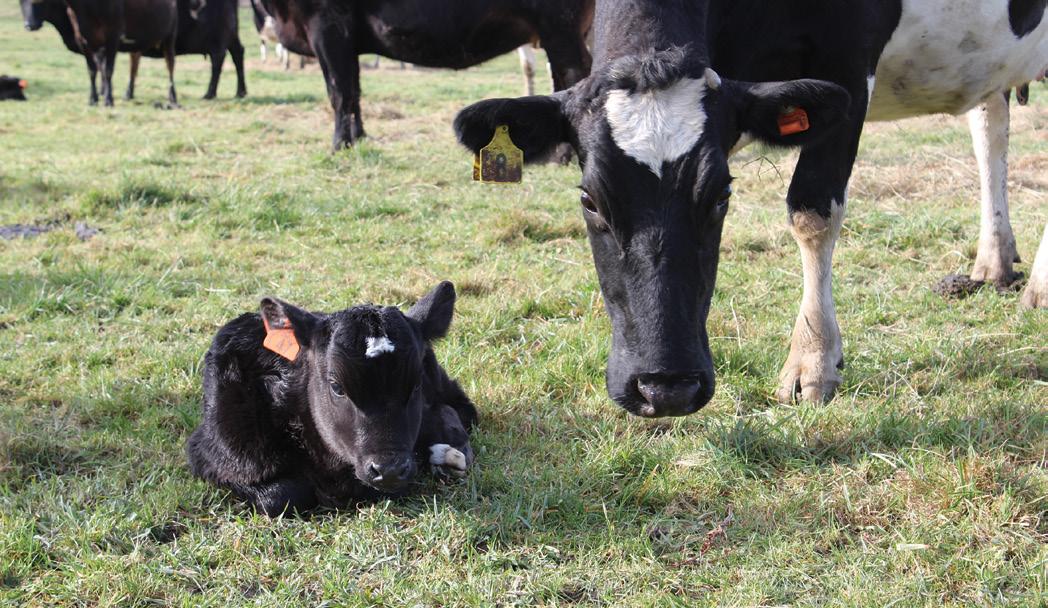
LIC NZ Markets general manager Malcolm Ellis said older cows, aged four to eight, calved after 280 and a half days.
“So there seems there is a general creep towards shorter gestation lengths in the national herd with younger cows calving earlier.”
However, it’s not a trait LIC is specifically selecting bulls for.
“We have never had a primary selection criterion on gestation length but it is highly likely that females with shorter gestation lengths will have positively impacted reproductive performance and therefore fertility breeding value (BV) so there will be a degree of natural selection.
“The fertility BV measures how quickly a cow cycles and gets in calf so if it has had more days to recover after calving then it is more likely to get back in calf.”

While beef breeds tend to have longer gestation lengths, the shorter gestation lengths observed were across all dairy breeds.
LIC’s Premier Sires bull teams available this year for mating had a weighted average gestation length of between -0.6 days to -6.3 days less than the biological average.
Half of this is transferred with the mating so if a bull with minus six days gestation length was mated with a cow ranked at 0.0 days, then the gestation length for that mating would be three days shorter than the biological starting point of 282 days.
Although bulls’ gestation lengths were known, either through daughters born or predicted through genomics, a cow’s ranking could be uncertain if she had not been recorded correctly.
The gestation lengths of the bull and cow from an individual mating feeds into MINDA’s Expected Calving Report so farmers are aware if their calving dates will be earlier than expected.
“We do have farmers ringing us up to say these two cows were mated on the same day but their expected calving on the MINDA report is days apart,” Malcolm said.
“It’s because of the gestation length of the individual cow and the bull.”
Checking the report was becoming essential to make sure cows were home in time for calving from runoffs and off crop and staff were on hand.
Farmers also had to understand cows could calve 10 days earlier or later than the expected due date.
Although some farmers were already shifting mating dates backwards because of the shorter gestation lengths, there was also the possibility of taking more days in milk.
“If you have your spring pasture management finely tuned with wellbalanced pasture growth/feed on hand and cow requirements, then you should perhaps be looking at delaying the start of mating by the estimated impact of gestation length.
“However, two and a half days is a lot.
“If you keep the start of mating the same and if you are calving two and a half days earlier and you have a 1000-cow herd, then that is 2500 extra days of milk you’re getting each season.
“Whatever you decide to do, a shorter gestation length helps the cow get back in calf as it gives it a longer time to recover from calving. This in itself can positively impact cow fertility.”
‘THERE SEEMS THERE IS A GENERAL CREEP TOWARDS SHORTER GESTATION LENGTHS IN THE NATIONAL HERD WITH YOUNGER COWS CALVING EARLIER.’
More commonly referred to as ‘woody tongue’, Actinobacillosis a wellknown condition affecting cattle. From the classic presentation of a drooling cow with a rigid, swollen tongue, this infection less commonly presents as unsightly, granulomatous masses bulging from under the skin
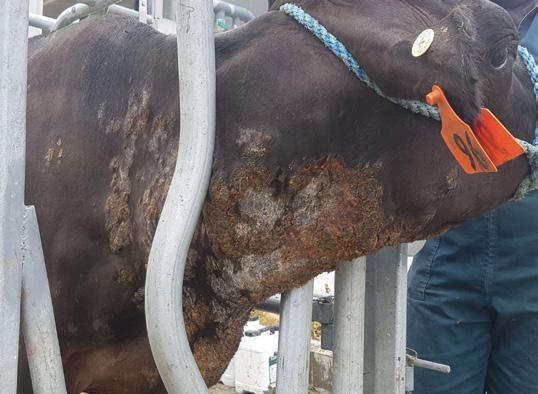
The causative bacteria is Actinobacillus lignieresi. This bacteria is a normal inhabitant of the mouth of cattle, but will take advantage to colonise areas beyond this location when trauma of any surface allows the bacteria to gain entry through the mucous membranes or skin, particularly when an inoculating dose is introduced through exposure to cattle saliva. The cheeks, neck and flank are areas where masses may erupt from. Treatment is with either antibiotics, sodium iodide (given in the vein) or potassium iodide (given orally).
PROGNOSIS : Excellent, particularly if detected and treated early.
Skin cancers are the most common type of cancer in cattle. Melanoma and squamous cell carcinoma (cancer eye) are the two types regularly encountered in New Zealand. Skin cancers are aggressive and capable of spreading to other locations on the body, as well as to internal organs. Treatment is best attempted early – deal with cancerous lesions while they are small, and chance of cure is much greater. While not necessarily obvious, tumors are painful and they are also prone to being damaged in the day-to-day activities of cows. Surgical removal is the only practical option in most cases. Wide margins are necessary, hence why treatment attempts should be made while masses are small.
PROGNOSIS : Fair to poor – if skin cancers are not detected and dealt with early, the prognosis is poor.
Bites from insects can result in unsightly rashes of lumps and scabs on the skin. Frequently complicated by self-trauma from scratching on whatever is handy, insect bites can turn into extensive, scabby, infected areas of skin. The most common sites are under the neck and either side of the tail - areas where selftrauma is easy to achieve. Chemical control of biting insects such as sandflies, biting flies and ticks are useful preventative measures in the herd. Once bites become traumatised and infected, it may be necessary to treat individuals with antibiotics, antiinflammatories and antihistamine to stop the itch-scratch cycle.
PROGNOSIS: Good – it is unlikely to kill an animal but it is a painful condition as it progresses with serious self-trauma.
This skin infection is caused by the bacteria
Dermatophilus congolensis. Typically, infected areas form on the back and are usually noted for having a thick crusting scab interspersed around the hair coat. As the scabs and hair come away, moist, pink, infected tissue becomes apparent underneath. Calves appear to be most commonly affected.

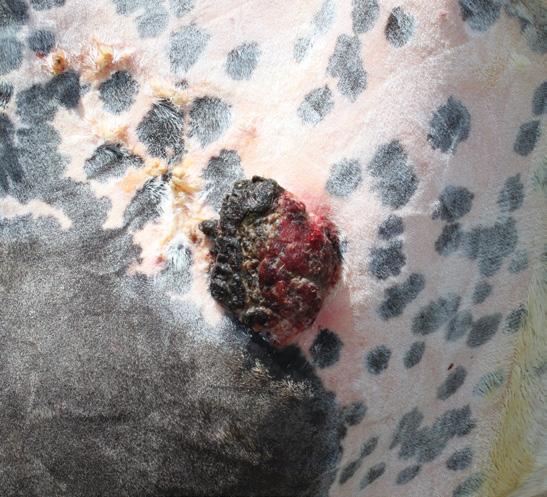

Treatment with antibiotics is required to clear the infection. Thick crusts can take some time to break down and occasionally an iodine wash may be required. Skin in affected areas will be tender, so consider giving pain relief as well.
PROGNOSIS: Good – treatment with a long course of penicillin-based antibiotics usually clears up the infection.
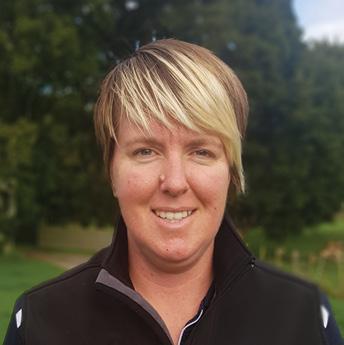
Ringworm is a fungal infection of the skin of cattle, usually caused by Trichophyton fungi. It presents as grey, hairless circles, most often on the head and neck. Generally this disease is considered harmless. It is rare for this disease to require intervention and treatment, however, it is a zoonotic disease so take care to cover your own skin when handling affected
Also known as papillomas, warts are caused by a viral infection with Papillomavirus. The disease presents with dry, fleshy masses erupting over the surface of the skin. Intervention is rarely required as animals will mount an immune response to the virus and clear the infection themselves. Occasionally,
animals. Outbreaks typically occur in young stock. Occasionally a herd outbreak will occur in mature cows when heifers return from grazing.
Very occasionally, an individual may not be able to mount sufficient immune response to clear the fungus, and she will become overrun with plaques of disease all over her body.

PROGNOSIS: Excellent: after about six weeks affected animals usually clear the infection without any intervention.
if the immune system of the cow fails to react strongly enough to the virus, papillomas can become chronic and may continue to grow and interfere with normal functions. Masses around the eyes are particularly troublesome if they rub on the surface of the eye.

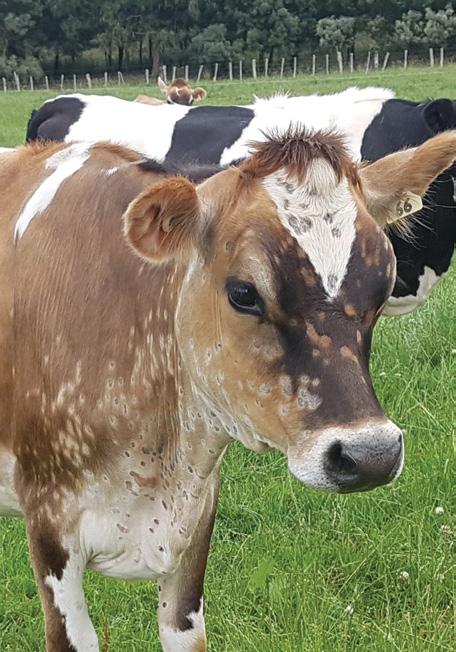
PROGNOSIS: Excellent: generally selfresolving in six weeks in most cattle once an immune response develops to the virus.
• Lisa Whitfield is a Manawatu-based production animal veterinarian.
The New Zealand Diploma in Primary Industry Business Management gives you the flexibility to study while you are working.
Course modules:
Financial Planning and Management
Environment and Sustainability Management
Strategic Planning for Primary Industry Business
Human Resource Management (Staff Management)
We have all heard people say some days are too hot for cows, but have you ever considered how much the heat is impacting them?
Historically, understanding heat stress has been based on noticeably reduced milk production, but now we understand that cows experience discomfort before production drops.
Cows’ stoic behaviour means their discomfort is not as obvious to us. Things like increased standing, aggression around the trough and increased breathing rates are easy to miss when we do not spend our whole day in the paddock with them.
Increased milk production means cows have more metabolic heat to manage, and therefore require more support to get through summer in comfort.
To understand the effect of heat stress on your farm, do two easy things:
1. Count how many breaths your best cow for production takes in 10 seconds
2. Research how many hours of risk your cows might face.
You might still feel sceptical about the impact of heat on your herd, and you might be right. The best way to find out is to get out and look at your cows, between 1pm and 3pm on a summer day.
Respiration is the earliest and easiest
indicator we have on how a cow is coping, and it only costs a stroll through the paddock. High production increases susceptibility, so use your best cow rather than your smallest heifer.
Once you have selected a cow, count how many breaths she takes in 10 seconds. The normal rate of breathing is 26-40 breaths per minute, or four-to-seven breaths in 10 seconds. If she takes more than 10 breaths in 10 seconds, she is experiencing enough heat stress to reduce her feed intake and affect milk production.
The hours of heat that will affect milk production differs regionally, ranging from two hours a day around Gore to 11 hours a day around Whangarei.
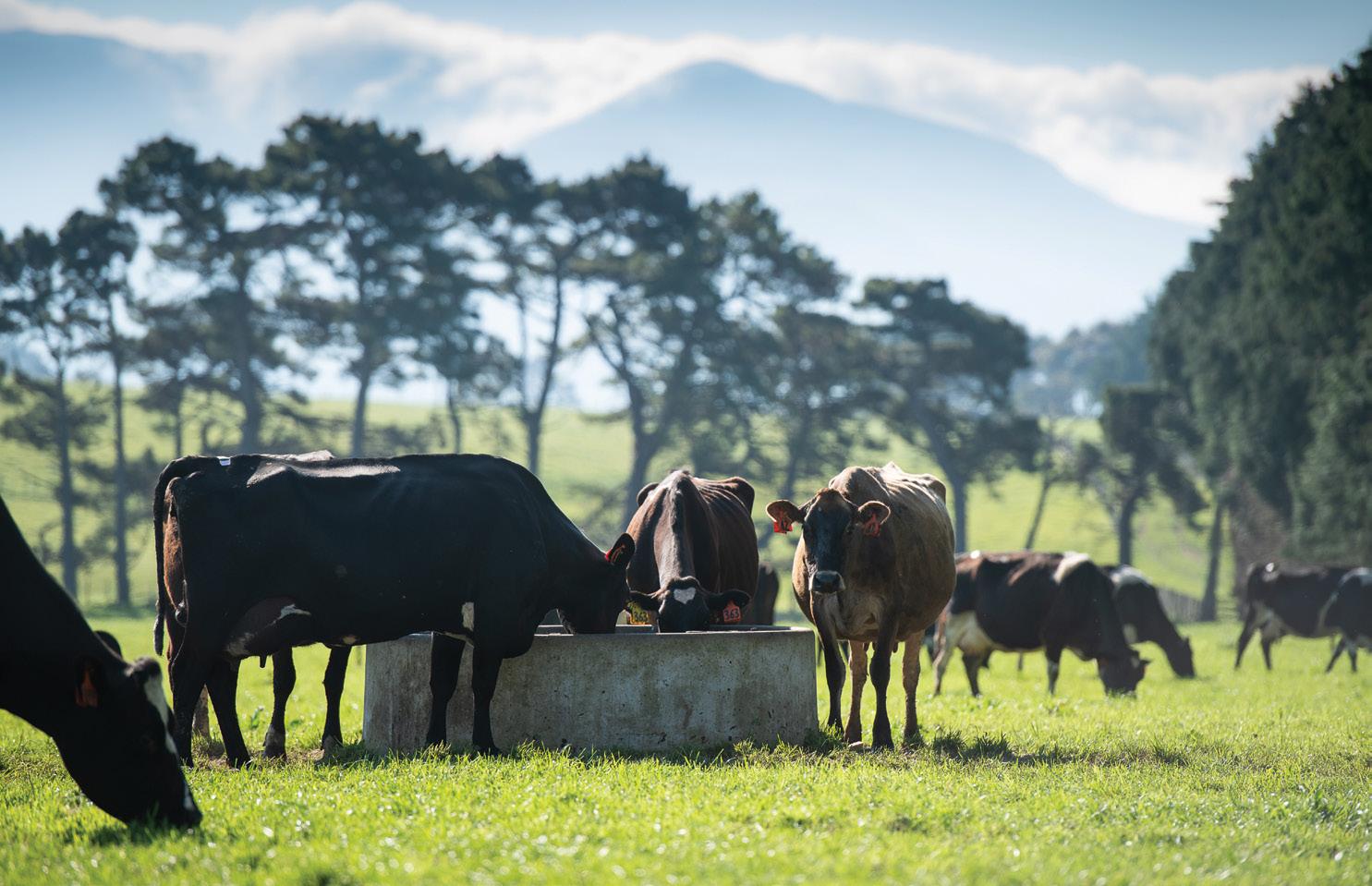
However, the hours that affect their comfort levels are an additional four to six hours a day, in every region.
If cows are exposed to all that heat, the estimated impact on milk production ranges from 1.5kg milksolids (MS) to 7kg MS per cow between December and February.
Many farms already have systems that reduce the risk for at least some of that time, but it is good to assess what you are already doing in each of those risk hours and whether you can apply some of the tips below.
For more information visit www.dairynz.co.nz/heatstress
• Jacqueline McGowan is DairyNZ senior solutions and development specialistWhile producing milk, cows require more support to get through summer in comfort.Aggression around the trough is an indicator of heat stress.
A training programme designed to give university graduates from an appropriate background a boost on progression towards farm management has proved a success. Anne Lee reports.
The inaugural Dairy Grads programme has just drawn to a close for this year with graduates and farm employers roundly declaring it a success.
Five university graduates with an eye to quickly reaching manager level (and beyond) have taken part in the year-long graduate programme this year.
Another eight are due to start in the programme in February next year.
The programme was set up by a group of Canterbury dairy farmers with the aim of developing recent graduates, equipping them with additional skills and knowledge and setting them up for a fast track to progression.
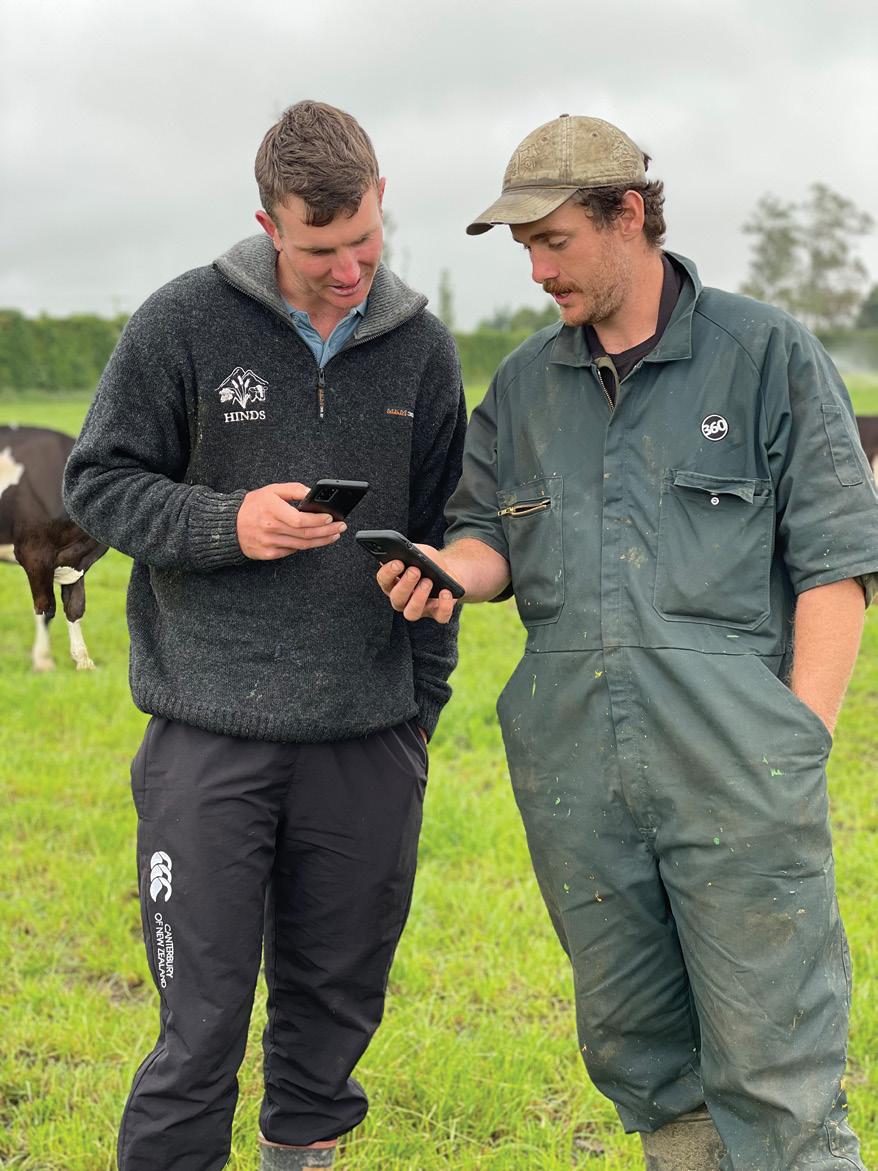
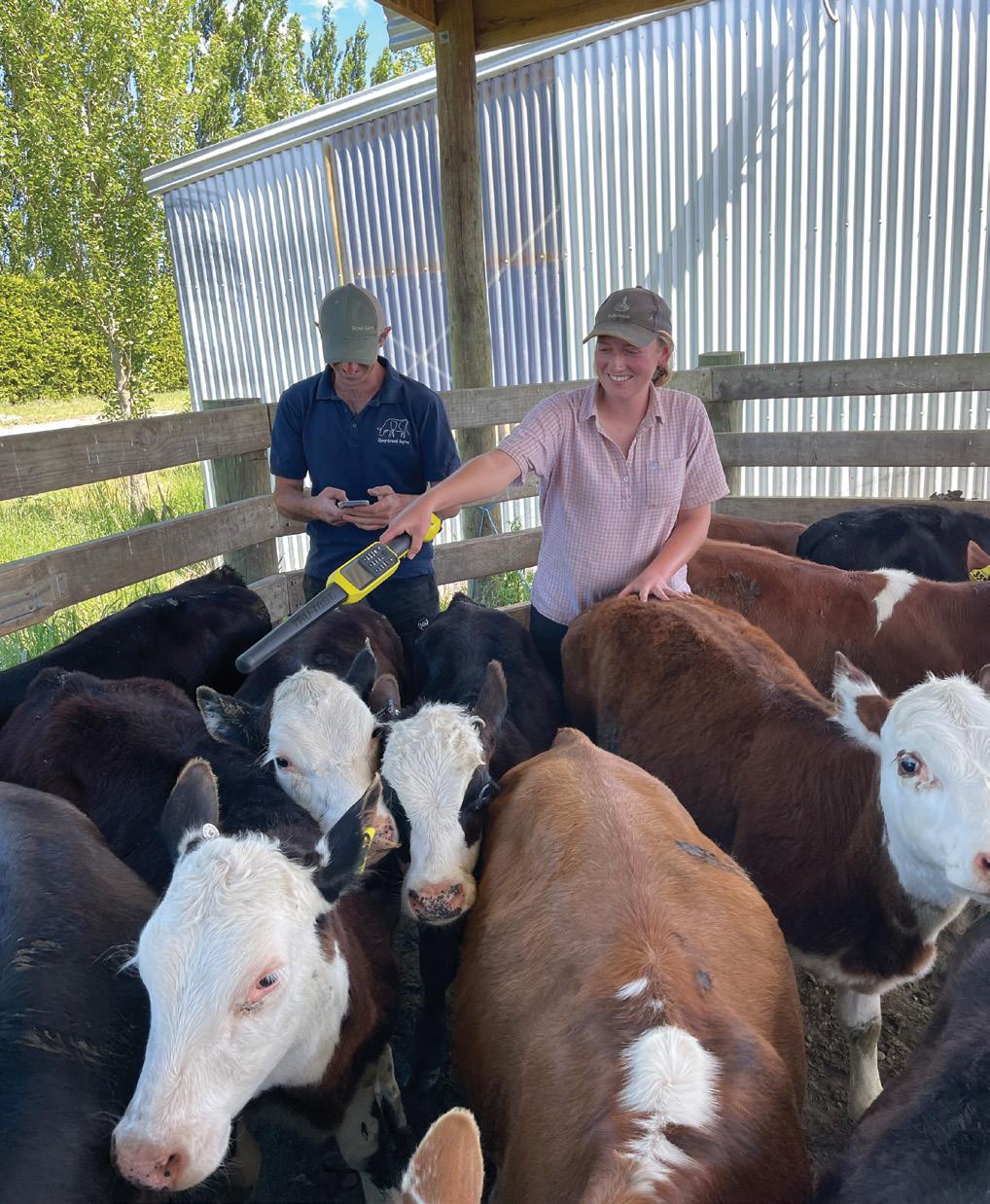
“Other businesses, such as banks, have graduate programmes but dairy farming didn’t have anything to help bridge the move from the technical and theory of university to the practical aspects of actually managing and running a farm,”
organising committee member Kim Grayling says.
Graduates can be from any university with the majority coming from Massey and Lincoln Universities having completed agriculture-related degrees.
The programme has a limited number of places each year with successful applicants either securing a job themselves with an employer who is supportive of the programme or the organising committee members putting them in touch with farmers involved in it.
There’s no shortage of employers wanting to be part of the Dairy Grad programme and take on a graduate.
They pay $1000 to help cover costs and are also expected to contribute their time by facilitating one or two of the more than 20 modules.
The development programme centres on these modules with the graduates attending three a month – each run on a
Wednesday afternoon throughout the year which runs from February to November but excludes a few weeks over the peak of calving.
THIS YEAR THEY COVERED A COMPREHENSIVE RANGE OF TOPICS INCLUDING:
• Pasture management essentials.
• Financial development.
• Banking basics.
• Being an outstanding employer.
• People management when establishing a team.
• Winter feeding.
• Animal health at calving.
• Onfarm technology.
• Health and safety.
• Environmental compliance.
• Nitrogen use.
• Managing a simple pasture system.
• Managing a more intensive system with a barn.
Many of the modules are presented by expert rural professionals but always in conjunction with a farmer who is skilled in the particular topic to ensure it stays relevant to onfarm situations.
The modules are mostly run out on farms where practices are relevant to what’s being discussed in the module but occasionally at other locations.
Organising committee member Campbell Tait says the success of the Dairy Grad programme relies on farm employers taking ownership of it.
“It relies on us committing our time to it.
“We’re the ones who need top quality people coming into our sector – we can’t rely on others to solve this for us.
“If we want to attract and develop these keen young people in the skills that are relevant to eventually managing our businesses we have to be involved in setting and running the programme,” he says.
Feedback from all the parties involved this year has been positive with strong interest for future years coming from both graduates and employers.
Although it’s a Canterbury-based initiative at the moment, it could be expanded to other regions.
But both Kim and Campbell say any expansion must be done at a regional, farmer-run level.
While the Canterbury module topics could serve as a basic template, farm employers in other regions would need to decide on specific module content relevant to their situations.
“As dairy farmers we’re very good at working cooperatively, but staffing is one area where we do compete with each other.
“This is about working together to set these keen young people up for success.
“We need them and by working collectively together we’re also creating a networking opportunity – for us as much as them.
“Even if I didn’t have a graduate on my farm, by being involved in the programme and helping run modules I’m going to meet the whole group and they’re going to get to know me.
“Down the track, those connections are going to help – both parties.”
Campbell and his wife Martine milk 820 cows on a 250-hectare family dairy farm at Hinds where the business also owns a 123ha support block.
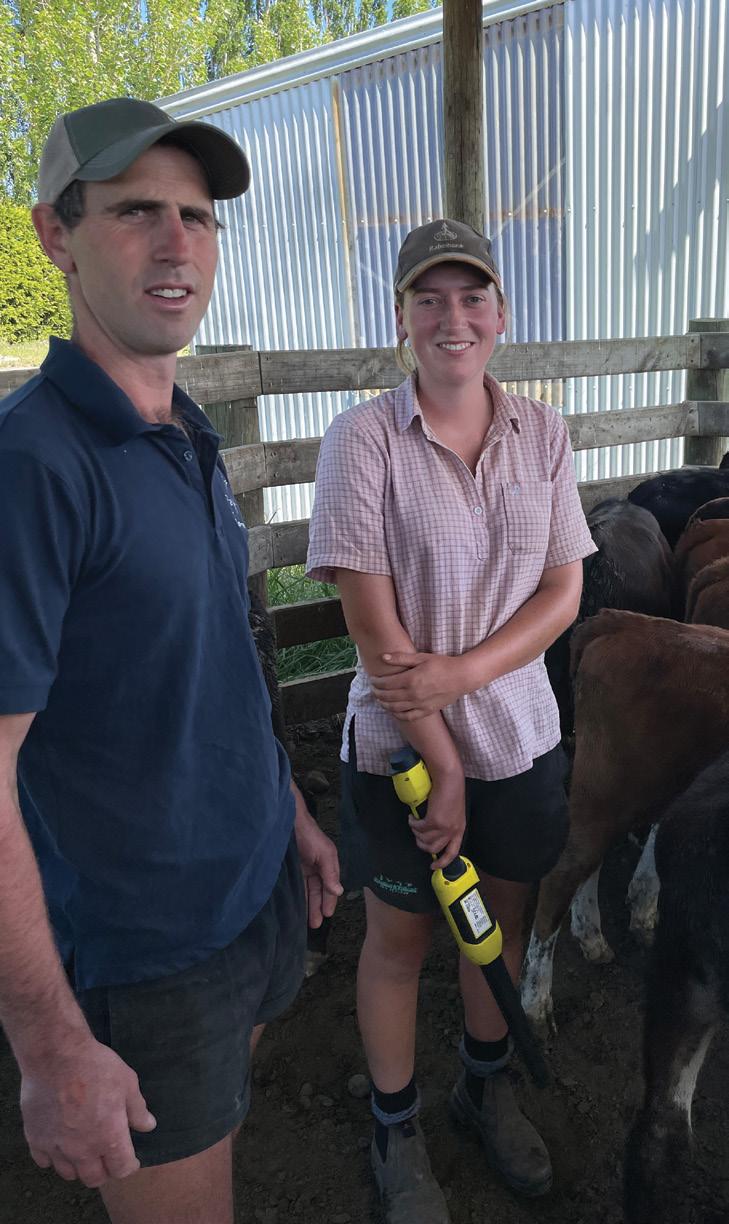
The couple has employed Abby Cook this year as part of the graduate programme.
She didn’t come via the usual Lincoln or Massey Universities route, instead coming from Otago University where she graduated with a degree in applied science majoring in forensics and pharmacology.
“At the end of my degree I was desperate
to get out of the lab and felt like I needed to go farming.
“My parents and grandparents have been dairy farmers and I think it was always in my head,” she says.
Her Mum and Dad are Elaine and the late Wayne Cook – 2006 National Sharemilkers of the Year.
She says her Mum had spotted the Dairy Grad programme promotions on social media last year and alerted her to it knowing Abby wanted to get into the wide open spaces.
“I had a zoom interview with Campbell, Tony Dodunski (Canterbury dairy farmer and original organising committee member) and Mark Grenside (ANZ) and soon after that they let me know I’d been accepted.”
She started out as a dairy assistant in February and is now working at closer to a 2IC level.
“I was a bit of an outlier in the grad group because I hadn’t worked on a dairy farm or completed an ag degree but the modules were so good I’ve learned a huge amount in a short time.”
The modules coupled with her eagerness to ask questions, learn on the job and employers committed to helping her progress already have her feeling that managing is a realistic goal within the next couple of years.
“Now it’s a matter of keeping that continuous learning going,” she says.
The personal development module with Sarah Watson from People Mad stood out to her.
‘I WAS A BIT OF AN OUTLIER IN THE GRAD GROUP BECAUSE I HADN’T WORKED ON A DAIRY FARM OR COMPLETED AN AG DEGREE BUT THE MODULES WERE SO GOOD I’VE LEARNED A HUGE AMOUNT IN A SHORT TIME.’Campbell Tait and Abby Cook on the DairyGrads programme.
“It was a good one at the start of the year because it set the base and opened up your mind to being self-aware when it came to learning styles and how different personality types communicate and learn.
“All the modules were so full of information – all of them were good.
“I’d 100% recommend it to other grads going farming.”
Hamish Kidd and Peter O’Connor both work for Canterbury contract milker and 50/50 sharemilker Steve Ketter.
They too fully recommend the programme with both a bit gutted it’s come to an end.
Hamish grew up on his parent’s Dargaville dairy farm and is the fifth generation of the family to go dairying.
He completed his Bachelor of Commerce Agriculture (B. Com. Ag) in 2020 and spent last year on a dairy farm near Burnham in Canterbury and the summer on a sheep and beef station up the Rakaia Gorge.
He heard about the Dairy Grad programme through Peter and signed up to it and a job with Steve this year.
Heading back home to farm is in the back of his mind but right now he wants to get as much experience as he can.
Canterbury irrigated dairying and the Dairy Grad programme have opened his eyes to some new ideas particularly around irrigation and pasture management.
He’s now a trainee manager on the 887cow Barnscroft Dairy Steve contract milks for the Pye Group.
There are three other staff on the 241 effective ha farm.
Hamish says modules such as the banking basics gave him an insight into what was needed for the next steps in progression and getting that ahead of when you’re actually taking those steps meant greater opportunity to prepare ahead of time.
The people management modules and learning efficient time management were some of the modules that stood out to him.
“That’s a massive learning curve but really rewarding.”
Having modules well timed for what was seasonally happening onfarm meant they could put what they had learned into action.
Getting the opportunity to mix with and
learn from top farmers was a huge bonus, he says.
“You hear people talk about the importance of contacts and networking but you don’t realise just what it can do until it happens.
“Everyone has reiterated that if we have any questions we don’t feel comfortable asking our employers we can give them a call. They’re all genuinely wanting to help us.
“It was nice too having people at the same stage of their careers in the group –we made good connections and we’ll keep in touch even though the programme has finished now.”
Peter had been 2IC on Barnscroft Dairy last season when he won the 2022 Canterbury and New Zealand Dairy Trainee of the Year title. He’s now managing Steve’s 400-cow sharemilking job half an hour away at Lauriston.
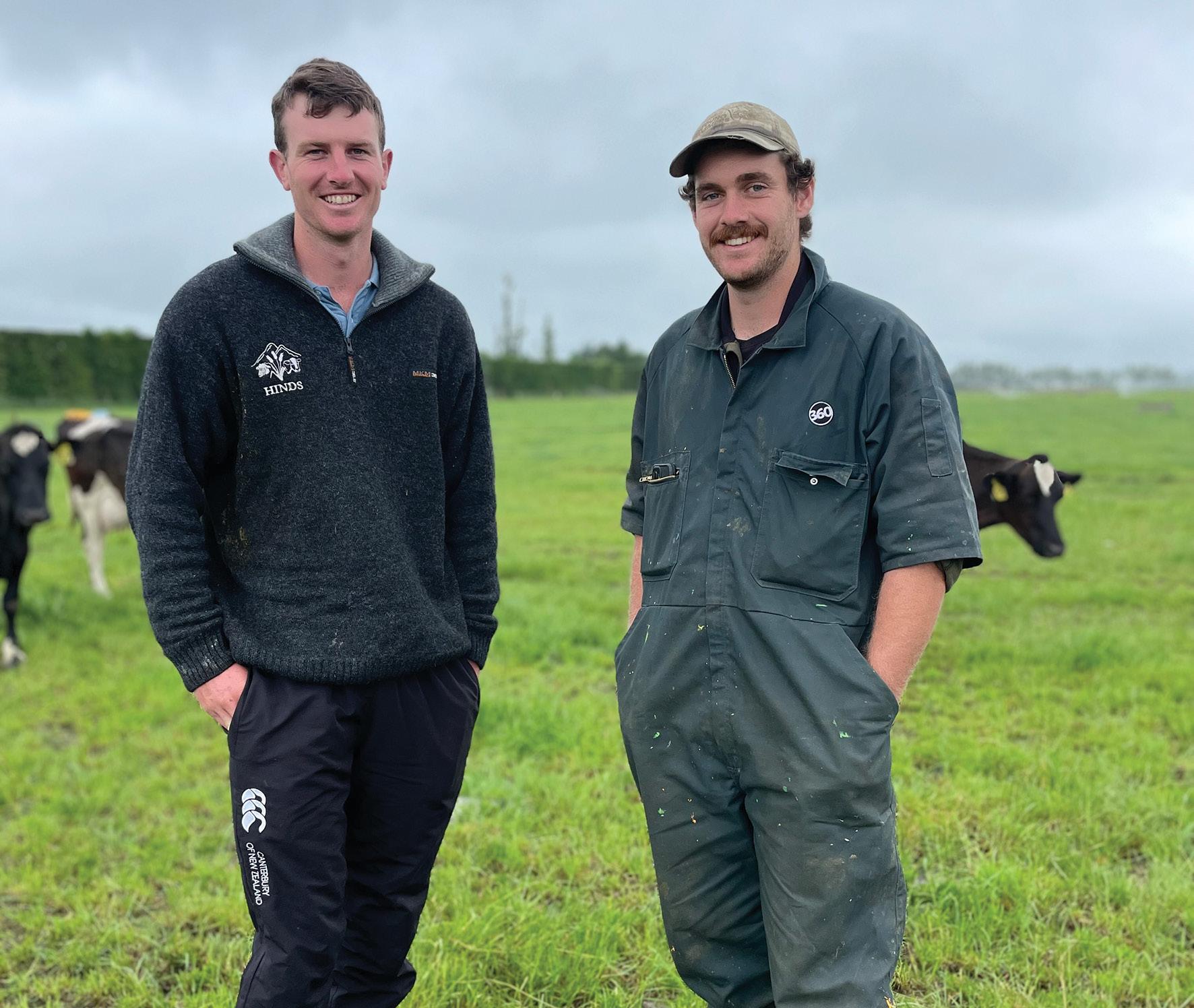
He too found big benefits in the programme even though he’d already had onfarm experience working for Steve.
Being able to spend a whole afternoon drilling down into a subject, asking questions and having both the theory and the practical applications teased out built his skills and knowledge.
“Having the farmers we had there was good because they could talk about how they were applying the theory – it gave you some practical tips for how to do it yourself and made it all a lot more real.
“The farmers involved in this see the real value in upskilling their people – they see the big picture and can see there’s going to be a problem in the future with having people to run their farms or grow with so they’re doing something about it now,” Peter says.
Steve says there are big benefits to being part of the programme – not only are the graduates building skills they can put to good use straight away on their employers’ farms to help run them more efficiently and productively, they’re also making connections with top young people who they can work with in the future.
“It’s a great concept. It helps get good keen people into the industry, thinking ahead and ready for the next step.
“If it wasn’t for these two we wouldn’t be doing what we are doing now – we wouldn’t be growing our business as well,” Steve says.
More? See www.dairygrads.co.nz
Teaching English in China helped broaden a young Australian’s horizons, leading to scholarship and a specialist role with Dairy NZ.
By Elaine Fisher.When Melburnian Odette Chauncy decided to give dairy farming in New Zealand a go, she didn’t ease herself into it gently. Instead, she got a job rearing calves on a Taranaki farm.
“I hadn’t grown up with cows, so the plan was to get a taste of the industry, so I threw myself into calving and had so much fun. I have such cool memories from that time and felt challenged in all the right ways,” Odette says. Today she works for DairyNZ based in the Waikato and is the recipient of the 2021 Colin Holmes Memorial Masters Research Scholarship. After a four-month stint on the Taranaki farm Odette returned to Australia in 2014, determined to become involved in the NZ dairy industry.
“I had fallen in love with cows, dairying and New Zealand and wanted to return.”
As a teenager, a career in dairying was never on her radar, Odette says. It was five months teaching English to students in China’s Yunnan province in 2011 as an 18-year-old with Lattitude Global Volunteering which completely changed her focus.
“As a teenager growing up you tend to be thinking more about your needs than others. I can’t quite explain what it was about being in China which changed my thinking, but it helped me see there was so much more to the world than I had previously realised. I knew I wanted to do more than I was.
“It felt to me that the food and fibre sector was so crucial to both now and the
future and I saw how important it would continue to be as our world population grew.”
Although she spent her teenage years in Melbourne city, Odette was born in rural New South Wales on a broad-acre familyrun farm.
“We farmed predominantly rice, wheat, oats and sheep and I grew up surrounded by family. I remember spending hours on the tractor and loved farm life.”
After returning from China Odette studied for a Bachelor of Business Marketing at Swinburne University of Technology, Melbourne, but the lure of dairy farming in NZ was still there. “I kept telling people that I wanted to be a dairy farmer until one day my sister said – well why don’t you just do it? And I did.”
Undeterred by a Taranaki winter, lack of sleep and the hard work of calving, Odette returned to NZ in 2016 to a 1000-cow farm in one of the coldest places she could have chosen – Oamaru.
“The farm was on the coast, and I loved being near the sea.”
Her next job was on DairyNZ’s Scott research farm in the Waikato where she and Brendan Graham raised Hagrid, a 232kg calf which won a competition between two DairyNZ research farms to produce the heaviest calf as a fundraiser for IHC.
It was also while working for DairyNZ that Odette decided to further her education by undertaking a Master of Science – Animal Science, Massey University.
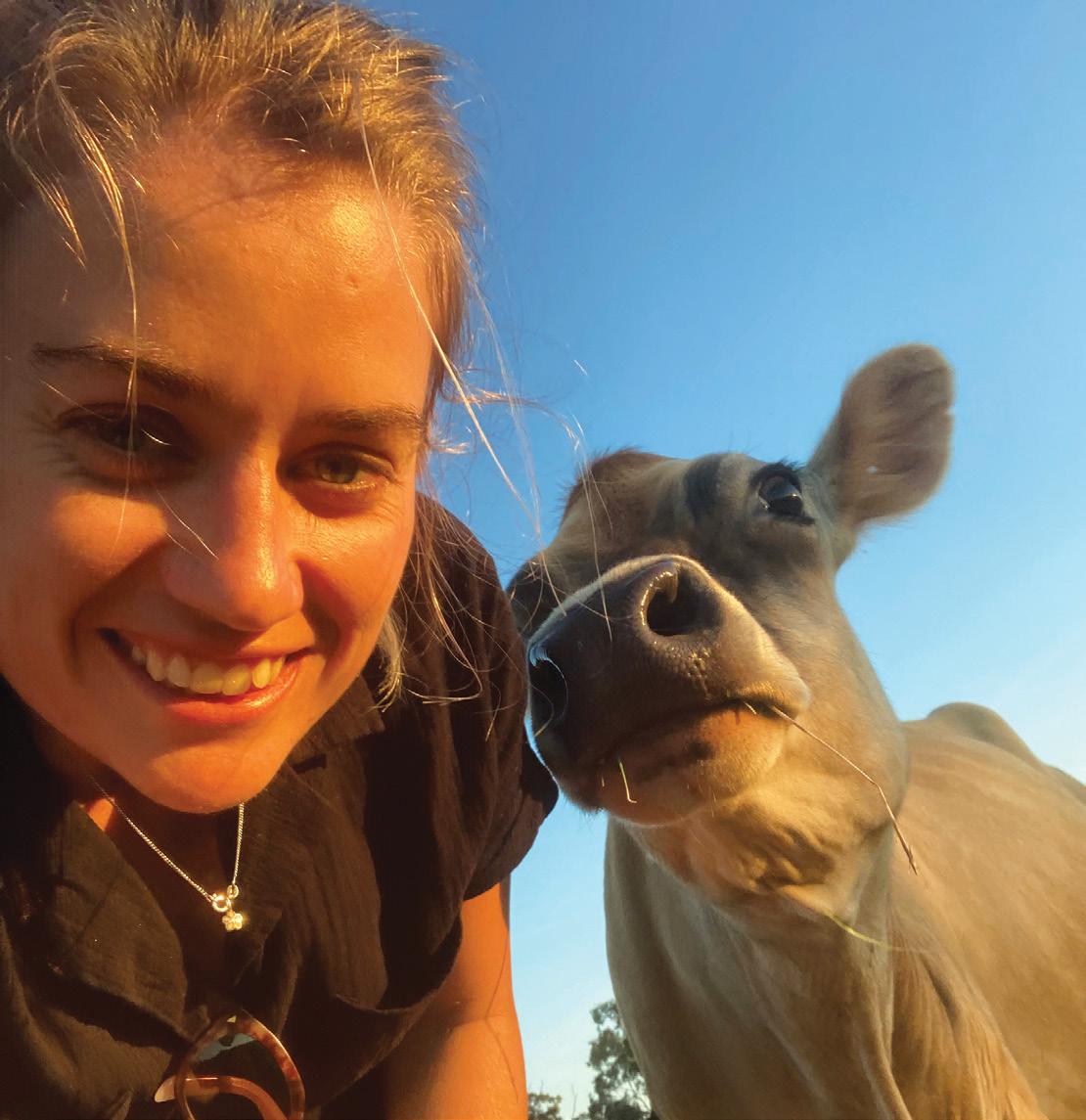
“I found out about the Colin Holmes Master Scholarship on the DairyNZ website and applied for it. I felt so privileged and fortunate to be awarded the scholarship and would strongly recommend others in the industry to apply for it or other scholarships.
“When you are younger these scholarships are probably not top of mind, but they are out there. The Colin Holmes Scholarship, co-funded by Dairy Trust Taranaki and DairyNZ has been amazing for me.
“It is about more than just money. I had so much support from the funders
and the university and received lots of encouragement to try different things, go to different events and meet so many people. I have had the chance to work with experts in their field and ask them all of the questions I have.”


The research project Odette worked on involved the analyses of three farms broken down into five case-study herds in Taranaki, run by Dairy Trust Taranaki, that implement various management


strategies for bobby calves. She researched and evaluated different opportunities for these calves through designed mating programmes, and identified the risks involved with different options. This included evaluating the impact to the farm system and quantifying the opportunity, calf-rearing resources, and demand for these to be delivered at national level when modelled on a typical NZ dairy farm.
She now has a role with DairyNZ as a solutions and development specialist working with farmer clients throughout the country, and with the wider DairyNZ team.
As to Odette’s long-term aspirations: “I have wanted to work in the food and fibre sector since my early 20s and I’m really enjoying my current role providing a service to help farmers with the day to day running of their farms.”
The main focus is workouts, with a wide offering including HIIT, strength, boxing, yoga, pilates and pregnancy and postpartum, but the programme also includes nutrition and recipes, meditations and a podcast.
“It’s helping people to change the way they look at fitness. We have just launched a workout for mental health for example, and the focus is getting people to see exercise as an important tool for their lives, to make them feel good, increase their confidence, energy levels, all that. Instead of what people have traditionally done, which is exercising to lose weight.”
exercise prescription and also a bachelor of science in psychology.
She worked for the Heart Foundation and as a stop-smoking facilitator, as well as doing some personal training, while overseas. When she and Mark moved home to the farm, Glentanner Station, half an hour from the nearest town, they started a family and Kate began running personal training sessions on the front lawn.
Kate grew up on a farm and loves living on a farm, but farming was never something she particularly enjoyed.
From running personal training sessions on her front lawn while her young children slept, to a thriving online health and fitness platform, Kate Ivey is inspiring people to adopt a healthier lifestyle that is sustainable longterm.
Founder and trainer of DediKate, Kate Ivey Fitness, Kate runs her business from a farm near Twizel, where she lives with her husband Mark and their three children. DediKate now has about 1700 members across New Zealand and Australia.

Kate’s on a mission to get rid of the diet mentality, encouraging positive habits to help people become consistent with exercise, no quick fixes, but instead creating long term maintainable habits.
“It’s workouts but it’s changing habits and changing thought patterns, and realistic. Myself and my trainers are real, everyday women who happen to be fitness trainers but also have a lot of other things going on in our lives, just like our members.”
Sport and exercise have always been part of Kate’s self-identity and something she was keen to pursue as a business. She has a bachelor of physical education majoring in
“It wasn’t something I wanted to do as a career, I just knew I wanted my own thing.”
After the birth of her third child, she found herself in a rut. She had ruptured her Achilles and was unable to exercise while pregnant. Using food as a way to make herself happy, she wasn’t looking after herself.
“Things were pretty full on and I completely lost my sense of self. I wanted to be successful in my own right, and I wasn’t fit.”
Kate got herself back on track using short and effective workouts, and sorted out her nutrition too.
“Between my pregnancies my focus had been on being skinny, rather than fuelling
Kate Ivey’s focus is getting people to see exercise as an important tool for their lives, to make them feel good.
Rebecca Greaves reports.
my body. It was after my third child I realised how nonsense that was. I had so much going on, I needed to fuel my body to be at my best.”
Her education, own journey and her experience working with others all suddenly clicked – an aha moment.
“It seemed so obvious, nutrition for energy and health, look after your body, exercise you can fit into your

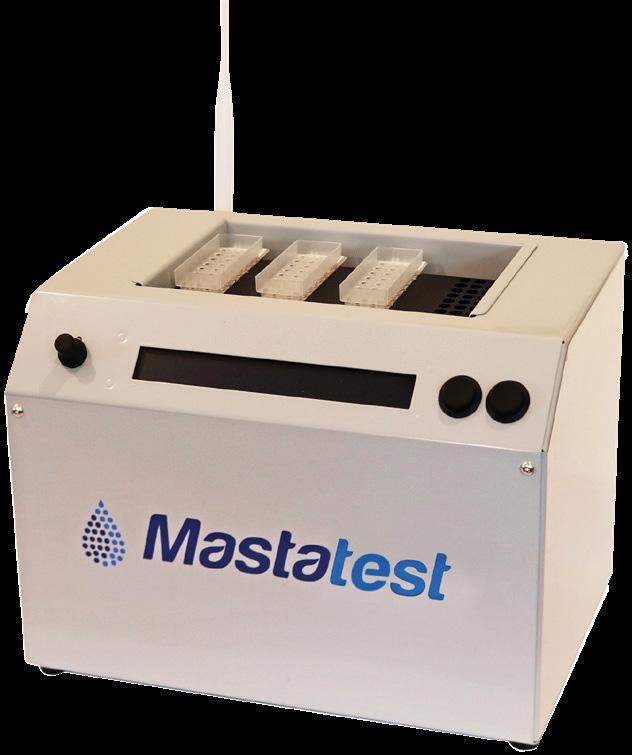
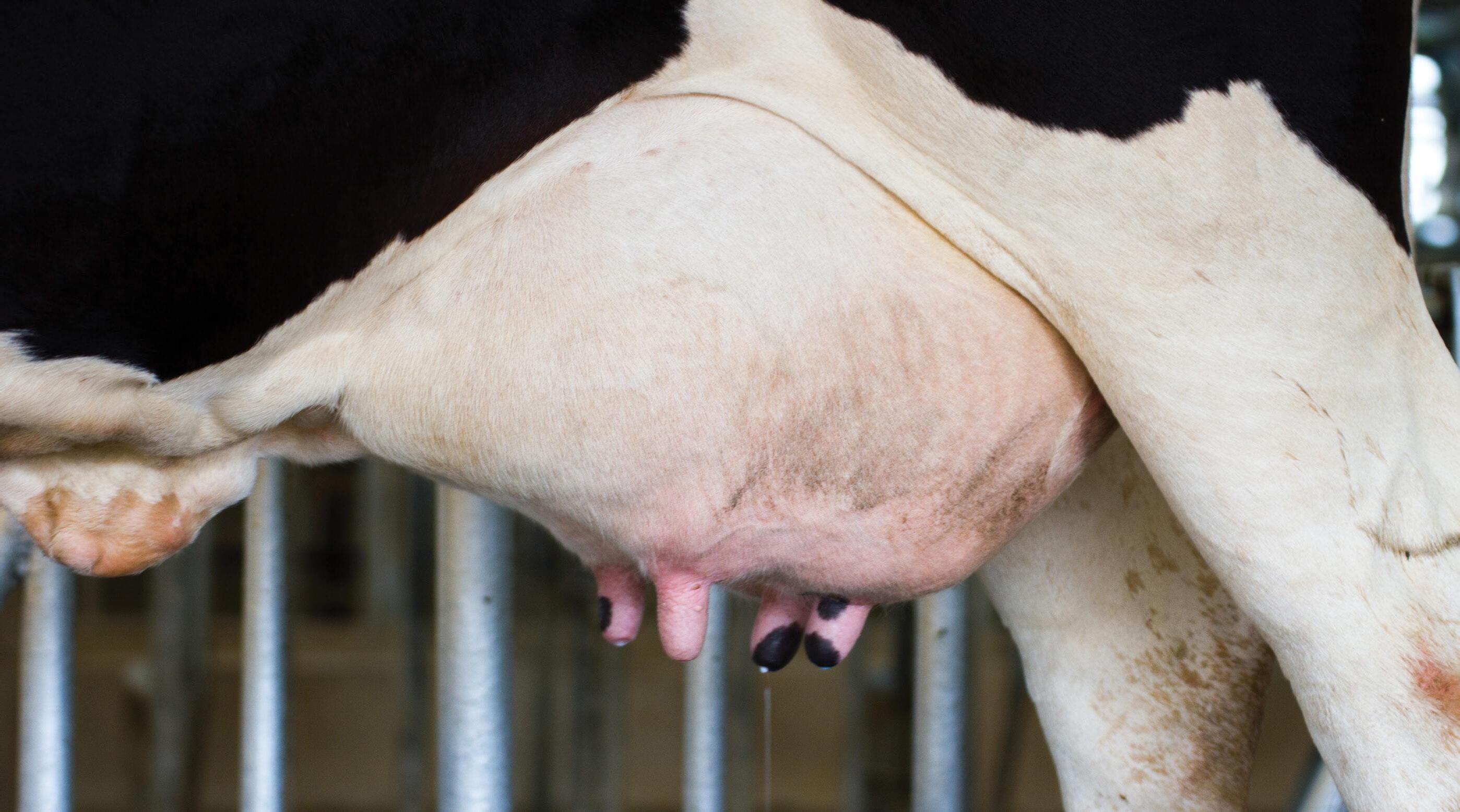
life and that’s not stop start, so 20-minute sessions and being able to balance it with a busy life. I was feeling really good.”
After brainstorming business ideas, Kate realised there must be other women out there like her, who needed this information. “Surely there must be other women just like me who I can help, and that’s how it all started.”
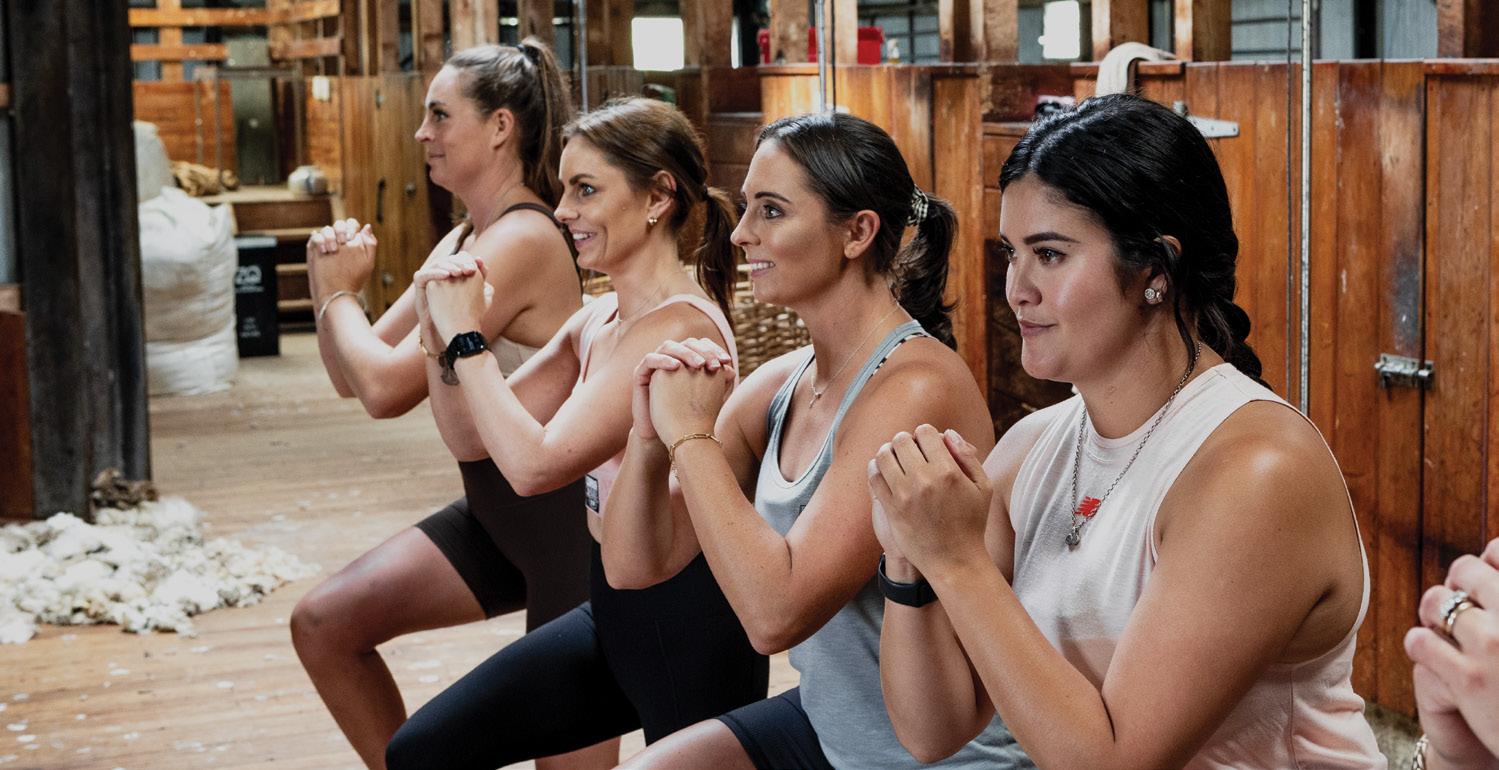
An online subscription model was the obvious option, due to her remote location and in order to create a viable business that was scalable. A strong desire to succeed and self-belief propelled her forward.
“I was going to succeed, there was no question, it was just a matter of putting in the work. It’s still like that now. I had my goals and I believed I could achieve them, so I just did what it took. There’s a lot of learning along the way.”
The cows at the Southern Dairy Hub have dropped their calves earlier than expected. By Louise Cook.
So, you’ve had one of the best starts to the season you’ve experienced, with good numbers in milk compared to previous years and cows are milking better than ever. When we had a good look at this at the Southern Dairy Hub (SDH), it turns out the cows really have been calving much earlier than usual. Surely that’s something to celebrate?
Except, we’ve had one of the best runs of spring weather Southland has ever seen, and if this year’s calving spread landed on last year’s feed supply – we’d have encountered a serious problem trying to keep the cows fed.
The great thing about the SDH is that we have data – lots of it! When we began to drill down to understand what was going on, we noticed that many of our cows had expected calving dates earlier than our planned start of calving.
On top of that – the cows seemed impatient and have dropped out four-legged bundles on average at least one day ahead of even the earlier date.
We wanted to understand if cows having expected calving dates less than 282 days from conception is now normal, or whether we are experiencing something unusual.
We contacted our partners at LIC and discovered this is becoming the new normal.
The genetic component of gestation length is measured in the animal evaluation index and is being used to calculate the expected pregnancy length of cows.
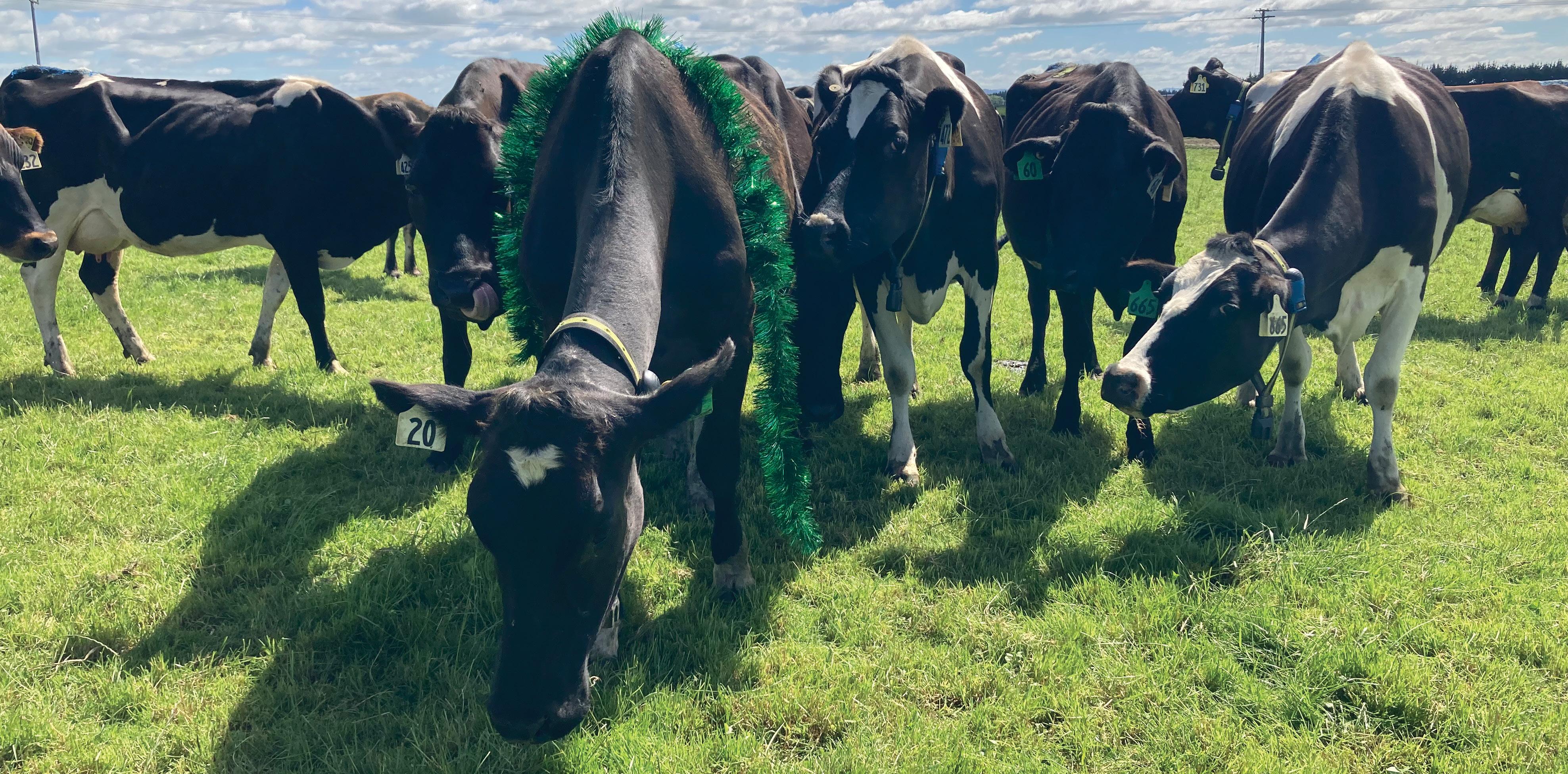
So, for our cows, we’re seeing that this year the herd should have had an average pregnancy length of 280 days, not 282 days.
On top of that, the national bull teams are likely to contribute an average pregnancy length to their daughters of five to six days. It means, when our 2021-born girls calve next year, we’ll have an average pregnancy length of 279 days.
If you put that all together, it means our
























that turns your world upside down when you face a life without the person you shared your life with. We huff and puff when we hear the words health and safety mentioned by someone, it could be your boss, a friend, a parent, or a colleague. We think that it will never happen to us, we think we are bulletproof… until it is too late.
Having been widowed at 28 years old I can assure you that health and safety is nothing to be sniffed at. The aftermath of losing someone in a farming accident is beyond describable and we seem to have forgotten that things like seatbelts and helmets are put there for us to be protected should the worst-case scenario happen and so we have a better chance at going home to our loved ones at the end of the day. This is who we do it for, this is who you should do it for. The people you love, who love you, who are waiting for you at the end of the day. Who are excited for you to walk through the door and greet them.
No one wants to be greeted by a policeman or emergency service person knocking on your door, taking their hat off to inform you of the horrible life-changing news or not your loved ones who have to be unlucky enough to find you in your resting place on the farm where a headline will later read “Gone too soon, farmer tragically killed on a farm”.
You are lying in bed awake, again. It has been like this for some time, maybe a year or more. It’s not just struggling to sleep that is the issue, it is struggling with life generally. Your head pounds as you lie there trying to breathe, trying to figure out how to survive another night alone, another day ahead.
What does the future hold for you now? Why won’t the back aches and the heartache stop? Why are you so short of breath and feel constantly nauseous? Why is life so unfair that life would do this to you? Why does everyone else get to be happy but you? Why is the spot in bed next to you empty, where there used to lie your best friend and soulmate?
Why does the dog whimper constantly and the kids cry all the time? Why am I not deserving of happiness? Why is it so hard to go out in public? Why does my mind feel like it’s stuck in a fog of unclarity? Where have my friends gone? Why is my house so empty? Why won’t the nightmares go away? Why did it happen to me? Why did he have to die?

These are just a few heartbreaking questions that you lie in bed and ask yourself after the loss of someone you love. This is minimal compared to how it actually feels and your mind and body are all consumed by the fierce grief and trauma

You need to stop and think about how many close calls you have had and what you are actually physically doing each day that is potentially going to put you into an early grave and your family into a devastating reality. What can you change to do better? What will help you make better, life-saving decisions when you are out on the farm?





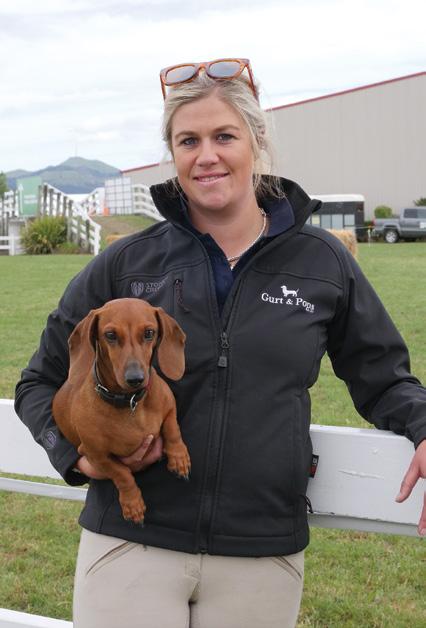
Think of your family. It is nearly Christmas. A time when we have a lot on our plates from social occasions to work pressures and so it can be human nature to want to cut corners but you need to ‘slow down to speed up’. Not only is having an accident life-changing or life-ending but also costly and time-wasting.



Stop and think before you start a job, talk with your staff about how you are going to do this job in the best way possible that does not wreck gear and take lives and remind yourself and them that they treat every job with respect and remember who is waiting for them at home at the end of every single day.
Don’t let your family down by leaving this planet too soon, don’t let it be your headline in the paper or your partner’s speech at your funeral saying they wished they had had more time. Make the right decision and do this over and over again each day to ensure that you stay safe in the most practical way. Do it for them and go home alive at the end of every single day.
Taking care of yourself and others is to ensure a better chance of going home to our loved ones at the end of the day.
By Harriet Bremner.
• Monthly magazines - choose from print or digital subscription options
• Subscribers save between 17% and 22% off the cover price, depending on your subscription term
• Share your magazines with team members to grow their knowledge or subscribe them all and each have a copy
• A great reference tool to refer back to time and time again
• Your subscription is a tax deductible farm working expense
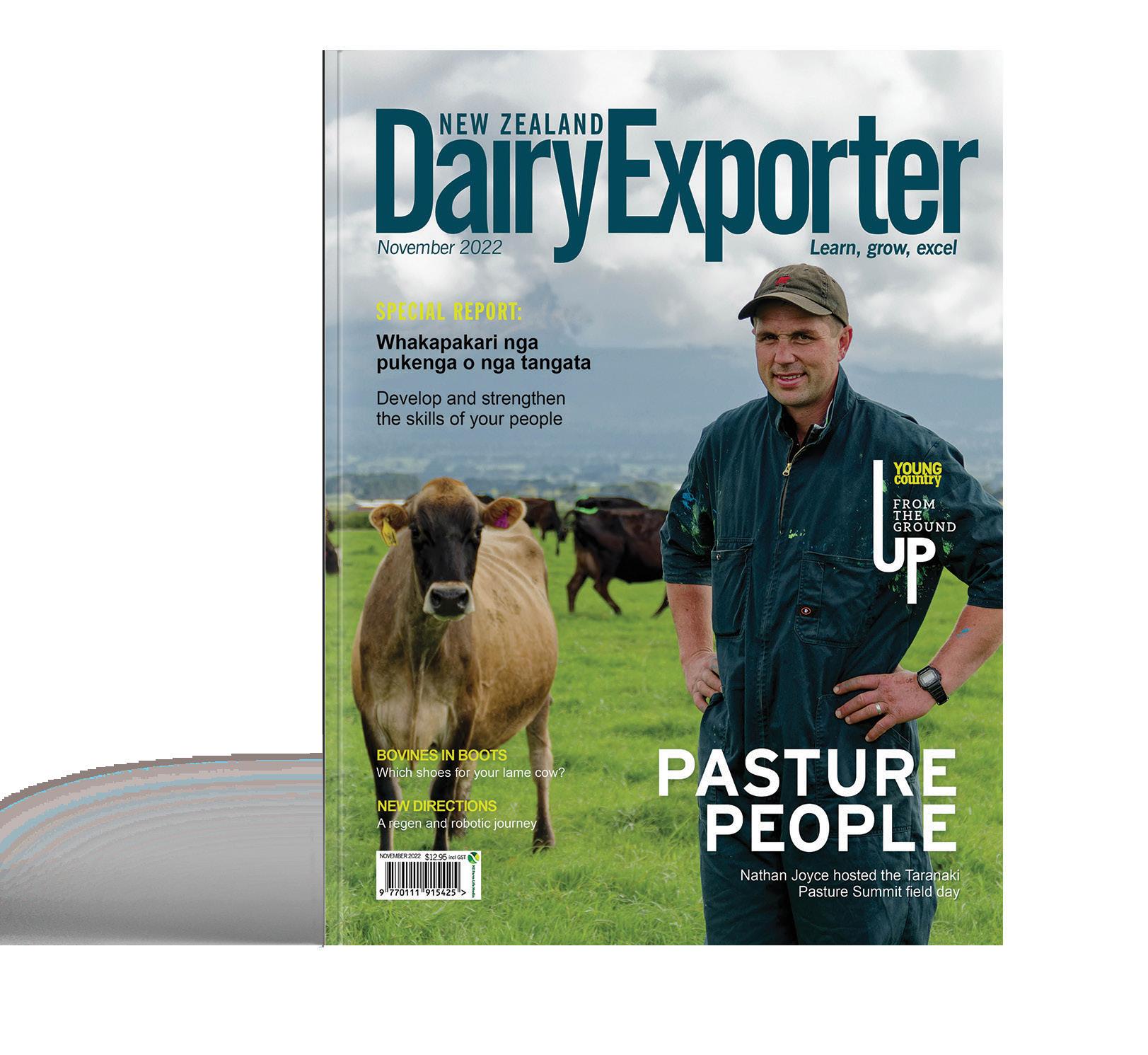
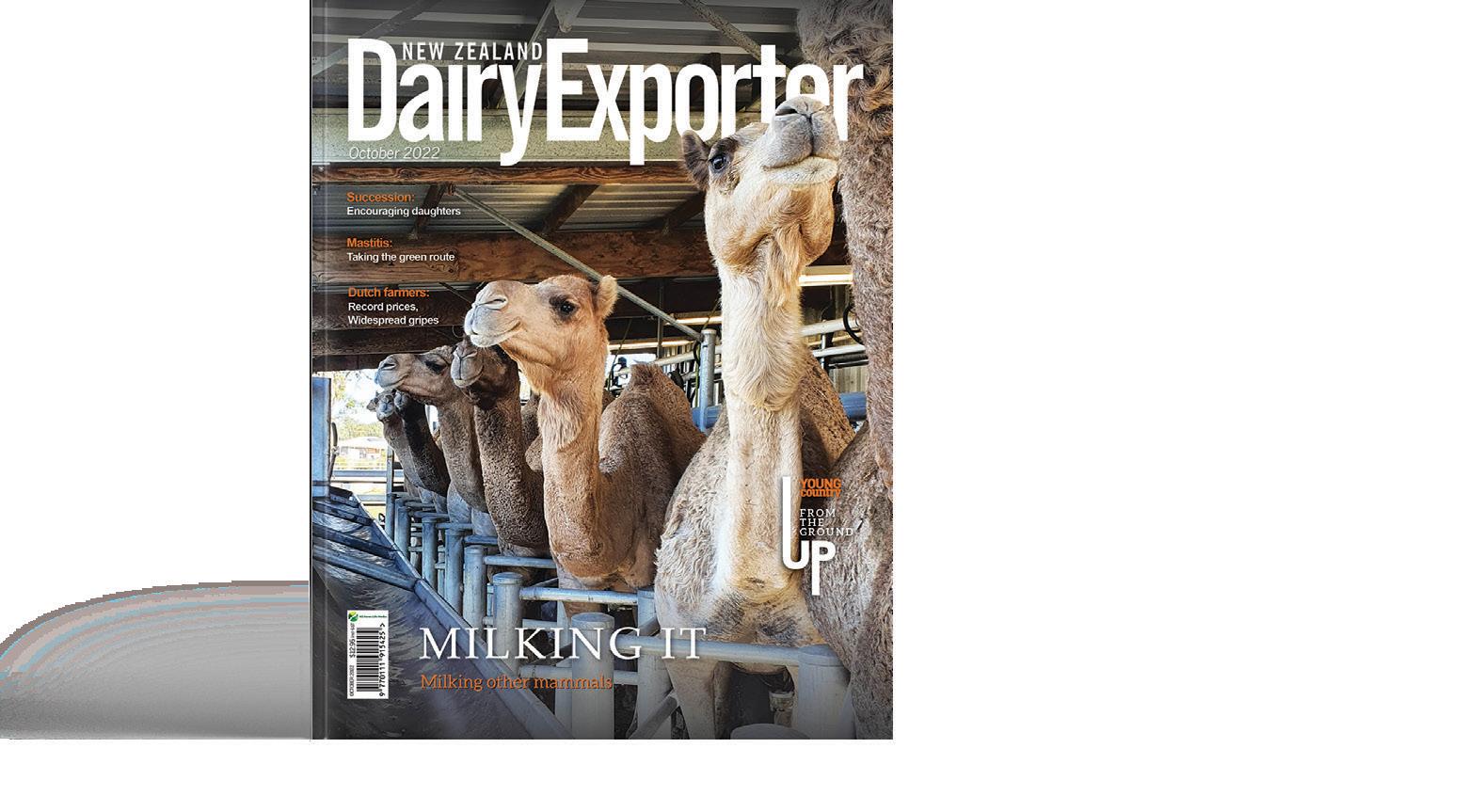
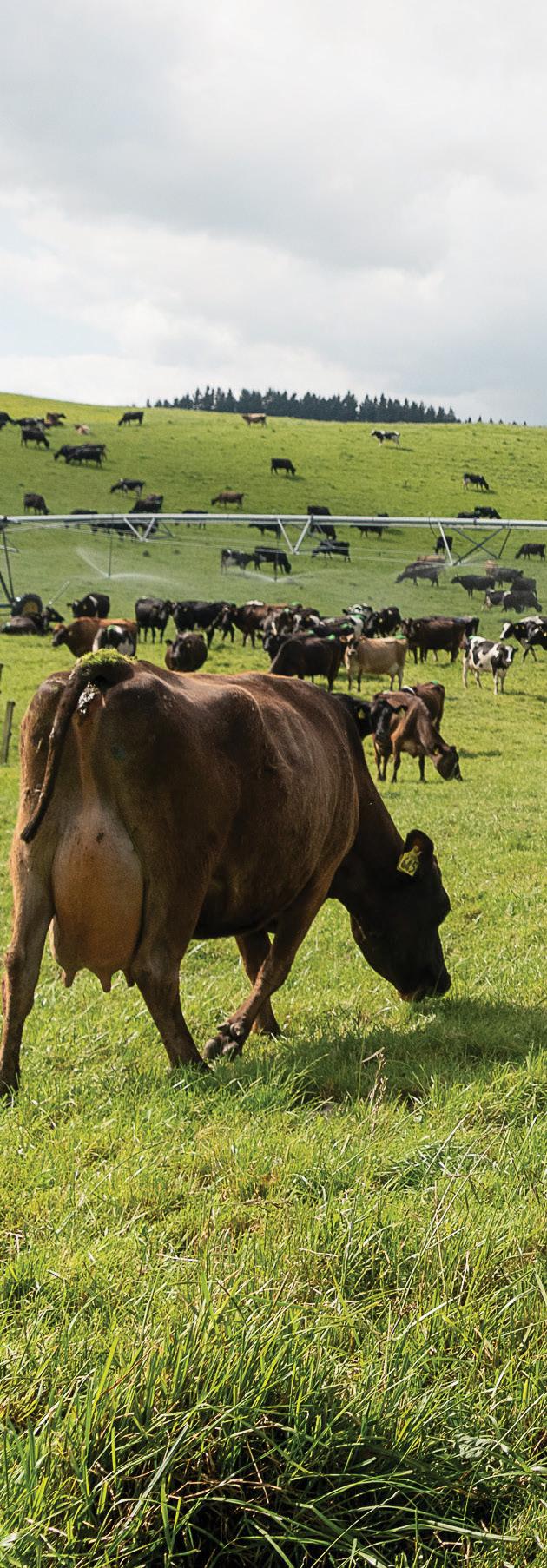
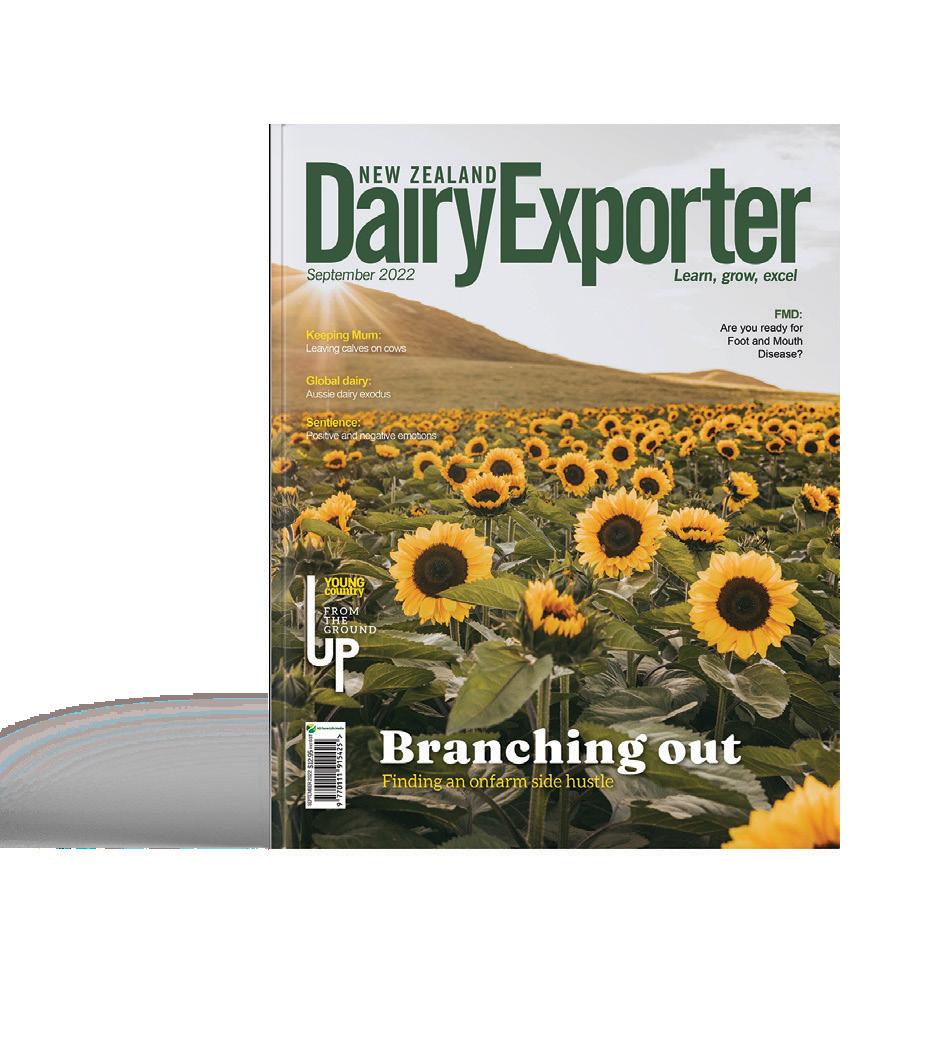
• Entry into regular subscriber-only competitions and giveaways
• Access to years of archive content on our website
12 MONTHS $129
24 MONTHS $252 36 MONTHS $360
As everyone finishes mating for the year, you’re probably thinking about all the things that went wrong and how to do it better.
So write a mental note to yourself for next year or, even better, put it in next year’s diary.
It’s not a fine line between not caring about what bull you use and obsessing. It’s a huge gap between the two and it’s okay to be in it.
Breed catalogues have a lot of information about a bull and many farmers don’t understand it all.

Breeding is not a logical science. Some traits will show more in your calves than others. The most reliable one happens to be the coat colour which has no influence on the milk docket.
Remember from every mating, unless you are using sexed semen, there is about a one in five chance the resulting calf will enter your milking herd. So if it all goes wrong don’t sweat the small stuff.
But grouping cows so all those getting the same bull are together for the AI technician helps to stop stuff ups. Clearly marking which cow is getting what also helps.
Pink foam doesn’t last long so be careful
using it. A spray painted “H” for Hereford works well.
If the cows are on a rotary platform make sure the marking is on the side of the rump that the technician will see as it comes around.
If you are planning synchros make sure you tell your technician as soon as you can. They may need to order the semen and they will need to find the extra time. If you slip an extra 40 cows into their morning without warning them first, it will make them late for everyone after you.
Think about the breeds you are using and why. Hereford straws are some of the cheapest available and they come in short gestation. All cattle breeds have different gestation length with Hereford longer than Friesian or Jersey so SGL Hereford means it’s short for Hereford but it’s about the same gestation length for dairy.
For your late-calving cows use short-gestation dairy semen which is super short and can bring late calving cows back in line in a year. Use the tools AI gives you.
When using SGL Dairy, use SGL Hereford for a week first as a marker so you know when the Hereford calves start being born you no
Grouping cows so all those getting the same bull are together for the AI technician helps to stop stuff ups, Karen Trebilcock writes.
IF THE COWS ARE ON A ROTARY PLATFORM MAKE SURE THE MARKING IS ON THE SIDE OF THE RUMP THAT THE TECHNICIAN WILL SEE AS IT COMES AROUND.The LIC book is divided into fives. One column is 15 cows, two columns 30 cows.
longer keep any of the calves. SGL Dairy semen is selected only on gestation length. They will not milk well in your herd.
Also use Hereford on any cows you know you are going to cull. Getting them pregnant will stop them bulling and put more milk in the vat. Don’t use an expensive straw, or a Wagyu contract, on a cow you are going to cull.
If you’re using sexed, do it for a reason such as you want more heifer calves because you need to grow the herd, or you have a contract for them, or you want to cull deep.
If you don’t need more heifer calves, you should be putting the same number of cows to a cheaper beef straw which gives you more options with the calf, or at least better money on the bobby truck.
Using sexed on your best cows, and beef on your worst, will increase your herd’s genetic gain the fastest. Be nice to your cows. Please read that sentence as if it is in neon flashing capital letters as high as the Sky Tower.
The cows you are putting up for AI are on heat. This means their hormones are making them feel weird, they are tired from bulling, their udders are sore because their milk won’t let down and you are probably trying to put them in an unfamiliar space for AI instead of letting them out to a grass paddock with the rest of the herd.
So be calm, gentle, don’t rush or yell around them. I know you are trying to be ready for the AI technician but a cow that is wound up is harder to inseminate. You will have to wait longer for the job to be done.
Don’t put them in the AI race until the technician is ready because standing there will make them more wound up.
If there is only one cow to be inseminated, never leave it by itself. Give it a buddy. Cows hate being by themselves. They are herd animals. A cow isolated in a race will be so upset it could be impossible to inseminate her.
And don’t try to wash the shed with the high pressure hose during AI. Cows do not like the noise and as soon as a hose is turned on, the AI technician’s job becomes so much harder.
Because an AI technician is not just sticking their hand up your cow’s rear end. They’re feeling where to place the inseminator correctly. It’s not easy. Respect that. The cows in the AI race must be the numbers written down on the paperwork which are then entered into the computer system, whichever one you’re using.
All three must agree – the cow, the paperwork and the computer. The technician will load the inseminators against what is written in the book. If the numbers don’t agree then everything has to be checked. In other words, count your cows and
check the ear tags all match before the technician arrives. The LIC book, if you use one, has its pages marked in fives with 15 to a column. You can look at it instantly and see there are 11 cow numbers written there, or 33. If you write your cow numbers on a piece of cardboard you always have to count them.
Don’t stress over picking cows. It is better to put a cow up for mating that you are unsure about than leave it out. If you do nothing, nothing happens. Don’t put a cow up two days in a row (unless you are really obsessing), but three-day, four-day and more short returns are fine.
Another way to get more cows up for mating is to put a young bull or a teaser bull out with the herd. Make sure it’s a marker bull such as Hereford or Belted Galloway so you can easily spot any resulting calves but there probably won’t be any.
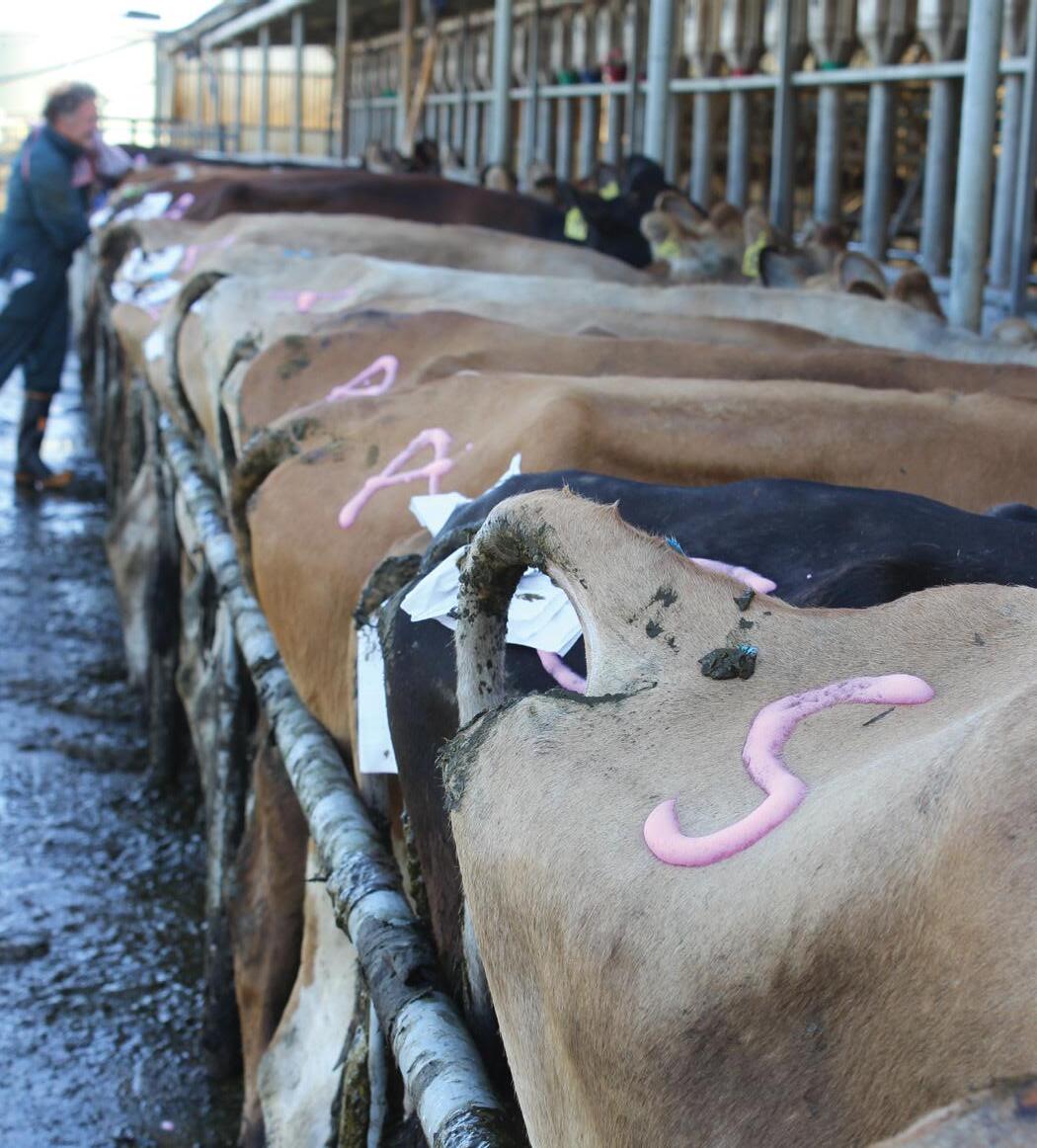
If a young bull is trying to service 20 cows or more on his own every day he won’t be getting them in calf but he will ride the cows and set off the heat detection patches or rub off the tail paint so it’s easier for you to see.
Also, make sure your technician and their assistant is safe at all times. Every year technicians get hurt, sometimes so badly they can never do the job again.
If a technician feels unsafe, it’s harder for them to concentrate.
Remember the reason we do AI is to get cows in calf. Whatever you do onfarm should help this process, not hinder it.
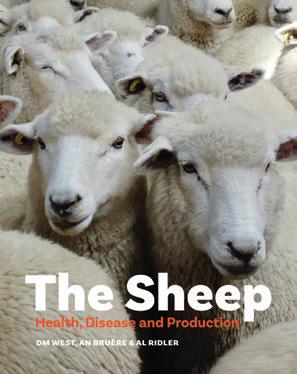
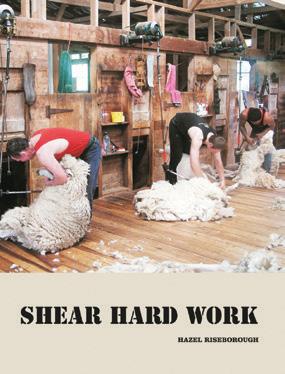
After several years in the market, Ecotain® environmental plantain has been confirmed by DairyNZ to be an effective tool for reducing nitrate leaching on farms.
Released by Agricom in 2017, Ecotain was developed in a Callaghan Innovationfunded programme (Greener Pastures –which included partnerships with Plant and Food Research and Massey and Lincoln Universities), after it was determined that targeting nitrogen leaching from the urine patch was the most practical approach to reducing this leaching loss. In addition, Agricom have seen farmers adopt Ecotain to take advantage of the high-quality feed it offers and its ability to support production in spring and autumn.
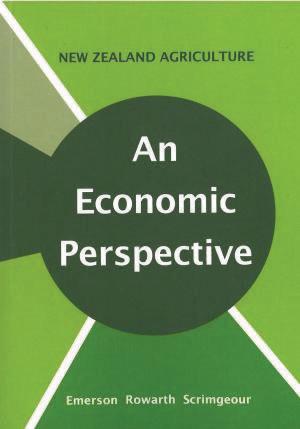
DairyNZ, through an MPI-supported programme, have introduced a plantain evaluation system which they are continuing to develop, to assess the effectiveness of plantain cultivars in reducing nitrate leaching.
The intention is to provide farmers and regulators confidence for what plantains to sow. As at July 2022, AgriTonic and Ecotain (a mix of Agritonic and Tonic) are the only plantain products classed by the Evaluation System as Effective, based on independent assessment of published data. Research supports Ecotain having four nitrate leaching reduction actions: it increases urine volume from livestock therefore diluting nitrogen concentration, reduces the amount of dietary nitrogen being cleared in urine, and reduces the
conversion of ammonium to the more leachable nitrate both in the urine from cows that are grazing plantain, and in the soil where plantain is growing. The Evaluation System considers the actions for reducing urinary nitrogen, and further research is underway to confirm the soilbased actions, with an aim to include these by 2027.
The OverseerFM model accounts for reductions in urinary nitrogen from plantain pastures.
Depending on the farm system, the model shows a farm with 30% plantain in the diet can achieve around 7-26% reduction in nitrate leaching. It is expected that further reductions will be possible with the outcomes of current research on the soil-based effects.
Highly versatile as a functional forage, Ecotain environmental plantain can be grown as a pure sward or special purpose crop, or as part of a mixed ryegrass/clover/

Ecotain pasture. It can be undersown into existing pastures and can add extra feed quality and longevity, in addition to its nitrate leaching reduction properties.
Adam Hardie, Farm Manager at Darroch’s Grazing, says they’ve been growing Ecotain on their Bankside, Canterbury farm for around ten years. Initially, it was planted with a view to harness its environmental benefits, but also prompted by the animal health advantages, with the plant’s extensive root system able to effectively pass on minerals to the cows, alongside its high levels of protein and palatability. They’ve continued to grow it and have also noticed that if they get any grass grub taking out pasture, the self-seeded plantain always grows back.
Adam says his advice to anyone wondering if it’s worth sowing Ecotain is that it’s great for adding value to any farming situation, dryland or irrigated.
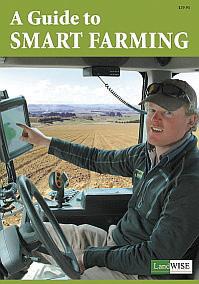
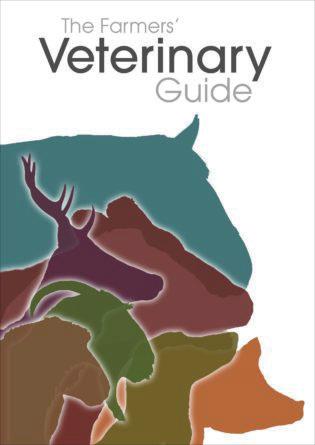
Terragen is an innovative agricultural biologicals company that creates biological products proven to accelerate calf growth, increase cow feed conversion efficiency and milk production, and improve soil biology.
Terragen’s story began with world class scientists looking for individual microbial strains that could benefit the agricultural sector. Thousands of strains of probiotics are available, but they don’t all deliver the same benefit.
Terragen’s team used its expertise in genome sequencing and bioinformatics to identify and determine which strains work best and how they work together to create a bigger impact.
These strains form the basis of Mylo®/calf and Mylo®/cow - live liquid, direct-fed microbial supplements made with AmpliBoost™ technology - and Great Land Plus®, a live liquid soil conditioner made with AmpliStim™ technology.
Independent research by the University of Queensland School of Veterinary Science found calves supplemented with Mylo® were 8.4% (5.8kg) heavier at weaning, had more uniform weaning weights, and had heavier, better developed, gastrointestinal tract organs compared with calves not fed the supplement.
Research by Agriculture Victoria Research’s Ellinbank SmartFarm has revealed Mylo® helps reduce methane emissions. Methane intensity in the control group was 7.5% higher than in the Mylo® group and methane production in the control group was 4.4% higher than in the Mylo® group.
Not only did it reduce methane, cows that received the baseline dose of 10ml of Mylo® a day gained 21% more weight than the control group. On average the cows on the Mylo® diet ate less feed but produced more milk, which means the feed conversion efficiency of the cows fed Mylo® was higher.
Terragen products are available with major rural retailers and selected vets/agents.
More? See terragen.co.nz/results
MaxCare has launched a calf rearing app which features calculators, feeding guidelines and other easy-to-follow instructions.
MaxCare Animal is designed to make farmers’ lives easy by providing them with a tool on their phone that gives them access to information at their fingertips.
“The app helps maximise productivity by guiding farmers through a consistent and targeted approach with their infant animals, accessed easily through the handy location of their mobile phone,” MaxCare New Zealand sales manager Philip Spies says.


“This app was created to simplify some of the potentially confusing messaging around calf rearing,” Spies says.
“My favourite feature is the calculators. They help enable farmers to be more accurate and consistent, while removing a lot of the thinking work required, out of an already very busy daily schedule.”
To support the launch of the new App, MaxCare is also running a competition, with 50 MaxCare-branded R.M.Williams vests valued at $109 to give away.
The competition is open to residents in New Zealand over the age of 18 years of age. To enter, simply fill in the form on the website and answer the question in 25 words or less “What is your favourite feature of the MaxCare Animal App and why”.
The MaxCare Animal app is available to download on IOS via Apple App Store and Android via Google Pay.
More? Visit maxumanimal.com
As NZ Dairy Exporter counts down to its centenary in 2025, we look back at the issues of earlier decades. 50 Years Ago – December 1972.
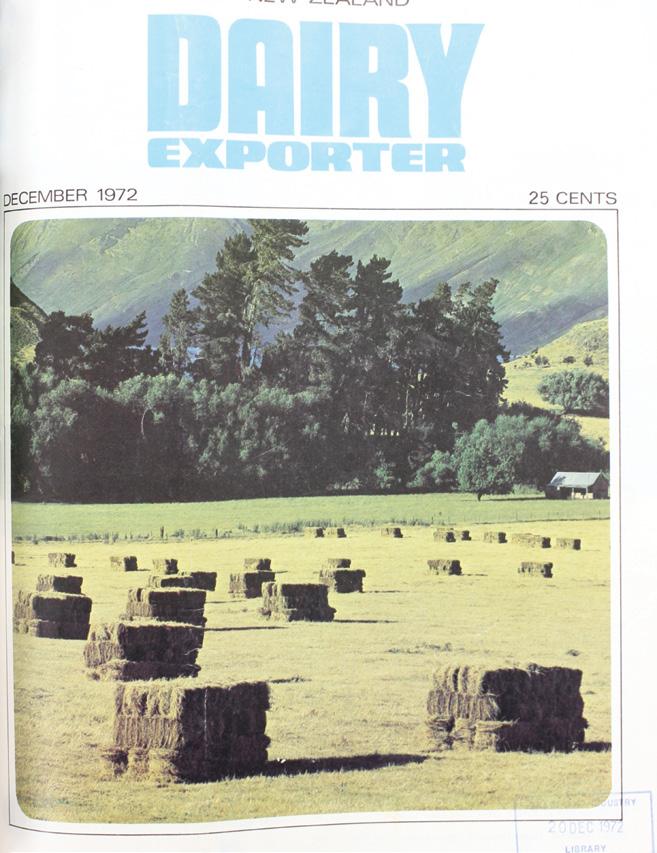
Have you ever thought of ringing the Met. Office for a weather forecast, before beginning hay making?
Send your name, telephone number, address and district to the Forecast section of the Meteorological Office in Wellington, near the time you want to make hay.
When the forecaster sees a period of good weather ahead, he will send you a telegram at your expense. The forecasts usually cover about three days, or in summer, when conditions are more stable, for four days. This long-range forecast system for haymaking has been in operation for some years, and must have saved many a farmer’s haymaking spell being interrupted by unexpected rain.
On January 1 the United Kingdom, together with Ireland and Denmark, will join the European Economic Community.
It will be a step of tremendous significance in European history and the reverberations will be felt in many places by many interests, including the New Zealand dairy industry. The commercial implications of this political decision are immense. The conditions under which Britain will continue to import butter and cheese from New Zealand, a traditional supplier for 90 years, were established in a protocol to the Treaty of Accession between the United Kingdom Government and the EEC, announced early this year.
Since then there has been intense activity at inter-Government official level to work out the details under the general terms of the protocol.
The most important “detail” for New Zealand immediately will be the price to be received in the future from sales of butter and cheese in Britain.
The protocol says this will be the average of prices received by New Zealand in Britain during the last four years,
but there may be some flexibility in the interpretation of this provision.
“Make today a cheeseday.”
This will be the theme of an intensive local market promotional campaign to be conducted by the New Zealand Dairy Board, starting in Auckland in February.
The Board has decided to launch the campaign in New Zealand, its second biggest cheese market after the United Kingdom, in view of Britain’s entry into the Common Market next month and the reduced sales of New Zealand cheese that will result. Organising and directing the campaign is Mrs Catherine Saunders, the former television personality Cathy Dowling. The Auckland pattern, which will be followed in each centre, will include concentrated advertising and promotional activity in newspapers, magazines, radio and television,
There will be two “On Camera” television programmes featuring cooking with cheese.
Packet butter on the New Zealand market will be sold in 500gm and 250gm sizes under the metric system.
This has been decided by the NZ Dairy Board on the recommendation of its local market butter committee.
The 500gm packet, slightly larger than the present 1 lb packet, will be the standard size. The change will be made on June 1, 1976.
The dairy section of the 1972 Lord Bledisloe Ahuwhenua Trophy competitions for Maori farmers has been won by Mr J. Edwards, of Horohoro, Rotorua.
Taranaki farmers took the minor placings. Second went to Mr T. W. Manu, of Oeo, and Mr and Mrs E. Walden, of Rahotu, were third.
The keenness of entrants made the competition this year one of the best, said the former Minister of Maori Affairs, Mr MacIntyre, when announcing the results. Both the first and second placegetters had been second in previous years. Mr Edwards had made good all-round progress with returns at a high level. His interest return on capital, 18.3 per cent, indicated sound management and wise spending.
Mr Edwards has an efficient farm recording system, had managed to control ragwort and achieved improvements in shed extension and plans for the future indicated progress towards higher production.
Milkfat production from the dairy unit of the Telford Farm Training Institute near Balclutha could reach 47,000 lb for 197273 with up to 152 cows being milked.
In giving this figure, deputy principal Mr C. B. Mead says it included production from about 20 cows milked during the winter and the milk used for feeding calves and also that for the institute hostel.
The institute can take up to 64 students aged from 16–19 years. It was established in 1964 on part of the historic Telford estate started by William Telford, an English pioneer who landed at Bluff in 1867 and bought land on the southern bank of the Clutha River.
• Thanks to the Hocken Library, Dunedin.
